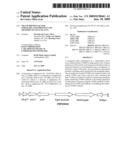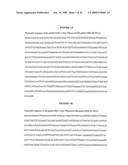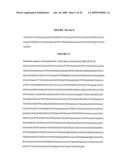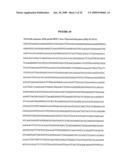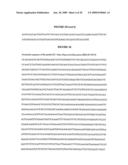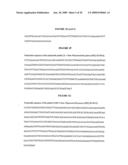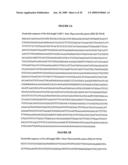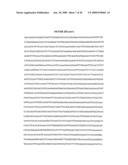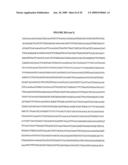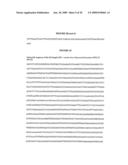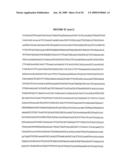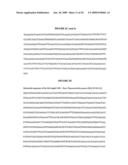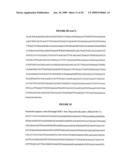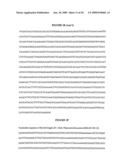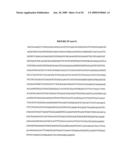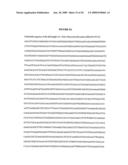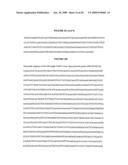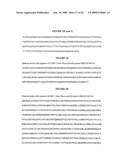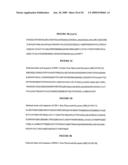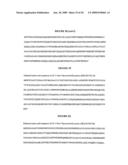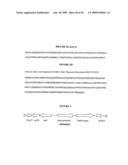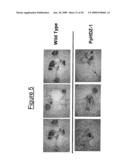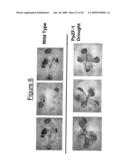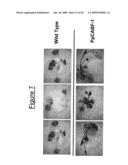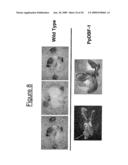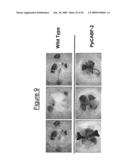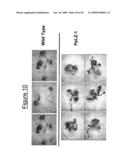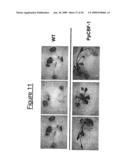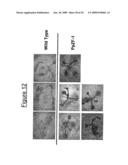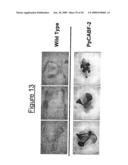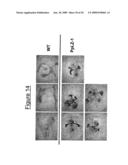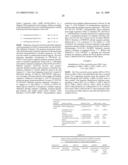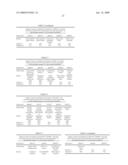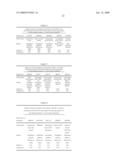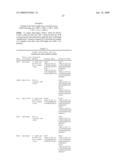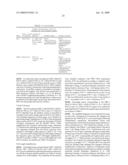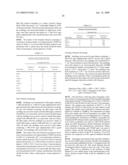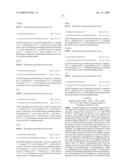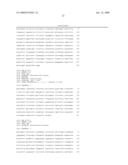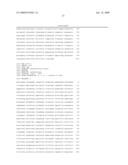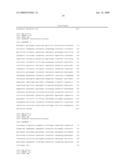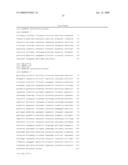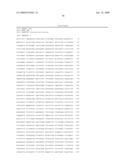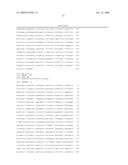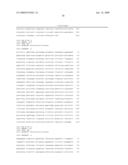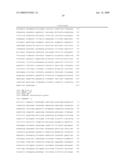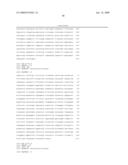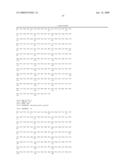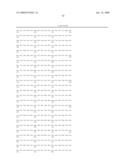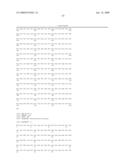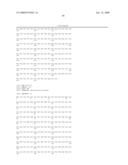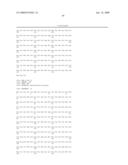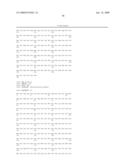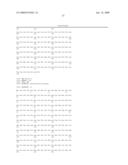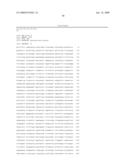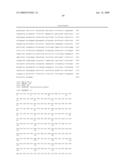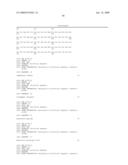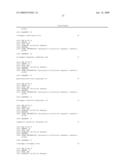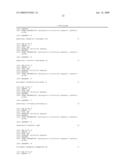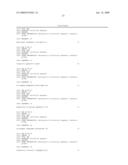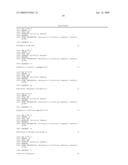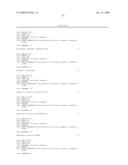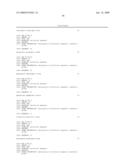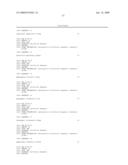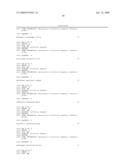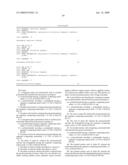Patent application title: Transcription Factor Stress-Related Proteins and Methods of Use in Plants
Inventors:
Oswaldo Da Costa E Silva (Neustadt, DE)
Nocha Van Thielen (Durham, NC, US)
Ruoying Chen (Duluth, GA, US)
Assignees:
BASF Plant Science GmbH
IPC8 Class: AC12N1582FI
USPC Class:
800278
Class name: Multicellular living organisms and unmodified parts thereof and related processes method of introducing a polynucleotide molecule into or rearrangement of genetic material within a plant or plant part
Publication date: 2009-06-18
Patent application number: 20090158461
Claims:
1. A transgenic plant cell transformed with an isolated polynucleotide
selected from the group consisting of:a) a polynucleotide having a
sequence comprising nucleotides 1 to 1521 of SEQ ID NO:13; andb) a
polynucleotide encoding a polypeptide having a sequence comprising amino
acids 1 to 343 of SEQ ID NO:20.
2. The plant cell of claim 1, wherein the polynucleotide has the sequence comprising nucleotides 1 to 1521 of SEQ ID NO:13.
3. The plant cell of claim 1, wherein the polynucleotide has the sequence comprising nucleotides 1 to 343 of SEQ ID NO:20.
4. A transgenic plant transformed with an isolated polynucleotide selected from the group consisting of:a) a polynucleotide having a sequence comprising nucleotides 1 to 1521 of SEQ ID NO:13; andb) a polynucleotide encoding a polypeptide having a sequence comprising amino acids 1 to 343 of SEQ ID NO:20.
5. The plant of claim 4, wherein the polynucleotide has the sequence comprising nucleotides 1 to 1521 of SEQ ID NO:13.
6. The plant of claim 4, wherein the polynucleotide encodes the polypeptide having the sequence comprising amino acids 1 to 343 of SEQ ID NO:20.
7. The plant of claim 4, further described as a monocot.
8. The plant of claim 4, further described as a dicot.
9. The plant of claim 4, wherein the plant is selected from the group consisting of maize, wheat, rye, oat, triticale, rice, barley, soybean, peanut, cotton, rapeseed, canola, manihot, pepper, sunflower, tagetes, potato, tobacco, eggplant, tomato, Vicia species, pea, alfalfa, coffee, cacao, tea, Salix species, oil palm, coconut, perennial grasses, and a forage crop plant.
10. A seed which is true breeding for a transgene comprising a polynucleotide selected from the group consisting of:a) a polynucleotide having a sequence comprising nucleotides 1 to 1521 of SEQ ID NO:13; andb) a polynucleotide encoding a polypeptide having a sequence comprising amino acids 1 to 343 of SEQ ID NO:20.
11. The seed of claim 10, wherein the polynucleotide has the sequence comprising nucleotides 1 to 1521 of SEQ ID NO:13.
12. The seed of claim 10, wherein the polynucleotide encodes the polypeptide having the sequence comprising amino acids 1 to 343 of SEQ ID NO:20.
13. An isolated nucleic acid comprising a polynucleotide selected from the group consisting of:a) a polynucleotide having a sequence comprising nucleotides 1 to 1521 of SEQ ID NO:13; andb) a polynucleotide encoding a polypeptide having a sequence comprising amino acids 1 to 343 of SEQ ID NO:20.
14. The isolated nucleic acid of claim 13, wherein the polynucleotide has the sequence comprising nucleotides 1 to 1521 of SEQ ID NO:13.
15. The isolated nucleic acid of claim 13, wherein the polynucleotide encodes the polypeptide having the sequence comprising amino acids 1 to 343 of SEQ ID NO:20.
16. A method of producing a drought-tolerant transgenic plant, the method comprising the steps of:a) transforming a plant cell with an expression vector comprising a polynucleotide encoding a polypeptide having a sequence comprising amino acids 1 to 343 of SEQ D NO:20;b) growing the transformed plant cell to generate transgenic plants; andc) screening the transgenic plants generated in step b) to identify a transgenic plant that expresses the polypeptide and exhibits increased tolerance to drought stress as compared to a wild type variety of the plant.
17. The method of claim 16, wherein the polynucleotide has a sequence comprising amino acids 1 to 343 of SEQ ID NO:20.
18. The method of claim 16, wherein the polynucleotide has a sequence comprising nucleotides 1 to 1521 of SEQ ID NO:13.
Description:
CROSS-REFERENCE TO RELATED APPLICATIONS
[0001]This application is a divisional of U.S. patent application Ser. No. 10/168,846, filed Oct. 29, 2002 and now U.S. Pat. No. 7,164,057, and this application is copending with U.S. patent application Ser. No. 12/189,865, filed Aug. 12, 2008, also a divisional of U.S. patent application Ser. No. 10/168,846, which is copending with 11/564,883, filed Nov. 30, 2006 and now U.S. Pat. No. 7,485,775, which is also a divisional of U.S. patent application Ser. No. 10/168,846, which is an application filed pursuant to 35 U.S.C. § 371 that claims priority benefit of PCT application PCT/US00/34972, filed Dec. 22, 2000, and U.S. provisional application Ser. No. 60/171,745, filed Dec. 22, 1999, the entire contents of each of which are incorporated herein by reference.
BACKGROUND OF THE INVENTION
[0002]1. Field of the Invention
[0003]This invention relates generally to nucleic acid sequences encoding proteins that are associated with abiotic stress responses and abiotic stress tolerance in plants. In particular, this invention relates to nucleic acid sequences encoding proteins that confer drought, cold, and/or salt tolerance to plants.
[0004]2. Background Art
[0005]Abiotic environmental stresses, such as drought stress, salinity stress, heat stress, and cold stress, are major limiting factors of plant growth and productivity. Crop losses and crop yield losses of major crops such as rice, maize (corn) and wheat caused by these stresses represent a significant economic and political factor and contribute to food shortages in many underdeveloped countries.
[0006]Plants are typically exposed during their life cycle to conditions of reduced environmental water content. Most plants have evolved strategies to protect themselves against these conditions of desiccation. However, if the severity and duration of the drought conditions are too great, the effects on plant development, growth and yield of most crop plants are profound. Furthermore, most of the crop plants are very susceptible to higher salt concentrations in the soil. Continuous exposure to drought and high salt causes major alterations in the plant metabolism. These great changes in metabolism ultimately lead to cell death and consequently yield losses.
[0007]Developing stress-tolerant plants is a strategy that has the potential to solve or mediate at least some of these problems, However, traditional plant breeding strategies to develop new lines of plants that exhibit resistance (tolerance) to these types of stresses are relatively slow and require specific resistant lines for crossing with the desired line. Limited germplasm resources for stress tolerance and incompatibility in crosses between distantly related plant species represent significant problems encountered in conventional breeding. Additionally, the cellular processes leading to drought, cold and salt tolerance in model, drought- and/or salt-tolerant plants are complex in nature and involve multiple mechanisms of cellular adaptation and numerous metabolic pathways. This multi-component nature of stress tolerance has not only made breeding for tolerance largely unsuccessful, but has also limited the ability to genetically engineer stress tolerance plants using biotechnological methods.
[0008]Therefore, what is needed is the identification of the genes and proteins involved in these multi-component processes leading to stress tolerance. Elucidating the function of genes expressed in stress tolerant plants will not only advance our understanding of plant adaptation and tolerance to environmental stresses, but also may provide important information for designing new strategies for crop improvement.
[0009]One model plant used in the study of stress tolerance is Arabidopsis thaliana. There are at least four different signal-transduction pathways leading to stress tolerance in the model plant Arabidopsis thaliana. These pathways are under the control of distinct transcription factors (Shinozaki et al., 2000 Curr. Op. Pl. Biol. 3:217-23). Regulators of genes, especially transcription factors, involved in these tolerance pathways are particularly suitable for engineering tolerance into plants because a single gene can activate a whole cascade of genes leading to the tolerant phenotype. Consequently, transcription factors are important targets in the quest to identify genes conferring stress tolerance to plants.
[0010]One transcription factor that has been identified in the prior art is the Arabidopsis thaliana transcription factor CBF (Jaglo-Ottosen et ale, 1998 Science 280:104-6). Over-expression of this gene in Arabidopsis conferred drought tolerance to this plant (Kasuga et al., 1999 Nature Biotech. 17:287-91). However, CBF is the only example to date of a transcription factor able to confer drought tolerance to plants upon over-expression.
[0011]Although some genes that are involved in stress responses in plants have been characterized, the characterization and cloning of plant genes that confer stress tolerance remains largely incomplete and fragmented. For example, certain studies have indicated that drought and salt stress in some plants may be due to additive gene effects, in contrast to other research that indicates specific genes are transcriptionally activated which leads to accumulation of new proteins in vegetative tissue of plants under osmotic stress conditions, Although it is generally assumed that stress-induced proteins have a role in tolerance, direct evidence is still lacking, and the functions of many stress-responsive genes are unknown.
[0012]There is a need, therefore, to identify genes expressed in stress tolerant plants that have the capacity to confer stress resistance to its host plant and to other plant species. Newly generated stress tolerant plants will have many advantages, such as increasing the range that crop plants can be cultivated by, for example, decreasing the water requirements of a plant species.
SUMMARY OF THE INVENTION
[0013]This invention fulfills in pail the need to identify new, unique transcription factors capable of conferring stress tolerance to plants upon over-expression. Namely, described herein are the transcription factors: 1) CAAT-Box like Binding Factor-1 (CABF-1); 2) CABF-2 3) DNA Binding Factor-1 (DBF-1); 4) CRT/DRE Binding Factor (CBF-1); 0.5) Homeo Domain/Leucine Zipper (HDZ-1); 6) Zinc-Finger Factor (ZF-1) and 7) Leucine Zipper (LZ-1), all from Physcomitrella patens.
[0014]The present invention provides a transgenic plant transformed by a transcription factor stress-related protein (TFSRP) coding nucleic acid, wherein expression of the nucleic acid sequence in the plant results in increased tolerance to environmental stress as compared to a wild type variety of the plant. The invention provides that the TFSRP can be selected from one of the well known general classes of transcription factor proteins: 1) CAAT-Box like Binding Factor (CABF); 2) DNA Binding Factor (DBF); 3) Homeo Domain/Leucine Zipper (HDZ); 4) Zinc-Finger Factor (ZF); and 5) Leucine Zipper (LZ). The invention further provides specific examples of TFSRPs, and TFSRP coding nucleic acids, such as 1) CABF-1; 2) CABF-2; 3) DBF-1; 4) CRT/DRE Binding Factor (CBF-1); 5) HDZ-1; 6) ZF-1 and 7) LZ-1.
[0015]The invention provides in some embodiments that the TFSRP and coding nucleic acid are that found in members of the genus Physcomitrella. In another preferred embodiment, the nucleic acid and protein are from a Physcomitrella patens plant. The invention provides that the environmental stress can be salinity, drought, temperature, metal, chemical, pathogenic and oxidative stresses, or combinations thereof. In preferred embodiments, the environmental stress can be salinity, drought, and temperature, or combinations thereof.
[0016]The invention further provides a seed produced by a transgenic plant transformed by a TFSRP coding nucleic acid, wherein the plant is true breeding for increased tolerance to environmental stress as compared to a wild type variety of the plant. The invention further provides a seed produced by a transgenic plant expressing a TFSRP, wherein the plant is true breeding for increased tolerance to environmental stress as compared to a wild type variety of the plant.
[0017]The invention further provides an agricultural product produced by any of the above-described transgenic plants. The invention further provides an isolated TFSRP, wherein the TFSRP is as described below. The invention further provides an isolated TFSRP coding nucleic acid, wherein the TFSRP coding nucleic acid codes for a TFSRP as described below.
[0018]The invention further provides an isolated recombinant expression vector comprising a TFSRP coding nucleic acid as described below, wherein expression of the vector in a host cell results in increased tolerance to environmental stress as compared to a wild type variety of the host cell. The invention further provides a host cell containing the vector and a plant containing the host cell.
[0019]The invention further provides a method of producing a transgenic plant with a TFSRP coding nucleic acid, wherein expression of the nucleic acid in the plant results in increased tolerance to environmental stress as compared to a wild type variety of the plant comprising: (a) transforming a plant cell with an expression vector comprising a TFSRP coding nucleic acid, and (b) generating from the plant cell a transgenic plant with an increased tolerance to environmental stress as compared to a wild type variety of the plant. In preferred embodiments, the TFSRP is as described below. In preferred embodiments, the TFSRP coding nucleic acid is as described below.
[0020]The invention further provides a method of increasing expression of a gene of interest within a host cell as compared to a wild type variety of the host cell, wherein the gene of interest is transcribed in response to a TFSRP, comprising: (a) transforming the host cell with an expression vector comprising a TFSRP coding nucleic acid, and (b) expressing the TFSRP within the host cell, thereby increasing the expression of the gene transcribed in response to the TFSRP as compared to a wild type variety of the host cell. In preferred embodiments, the TFSRP is as described below. In preferred embodiments, the TFSRP coding nucleic acid is as described below.
[0021]The present invention further provides a method of identifying a novel TFSRP, comprising (a) raising a specific antibody response to a TFSRP, or fragment thereof, as described above; (b) screening putative TFSRP material with the antibody, wherein specific binding of the antibody to the material indicates the presence of a potentially novel TFSRP; and (c) analyzing the bound material in comparison to known TFSRP to determine its novelty.
BRIEF DESCRIPTION OF THE DRAWINGS
[0022]FIGS. 1(A-G) show the partial cDNA sequences of CABF-1 (SEQ ID NO:1), DBF-1 (SEQ ID NO:2), CBF-1 (SEQ ID NO:3), HDZ-1 (SEQ ID NO:4), ZF-1 (SEQ ID NO:5), LZ-1 (SEQ ID NO:6) and CABF-2 (SEQ ID NO:7) from Physcomitrella patens.
[0023]FIGS. 2(A-H) show the full-length cDNA sequences of CABF-1 (SEQ ID NO:8), DBF-1 (SEQ ID NO:9), DBF-1 variant (SEQ ID NO:22), CBF-1 (SEQ ID NO:10), HDZ-1 (SEQ ID NO:11), ZF-1 (SEQ ID NO:12), LZ-1 (SEQ ID NO:13) and CABF-2 (SEQ ID NO:14) from Physcomitrella patens.
[0024]FIGS. 3(A-H) show the deduced amino acid sequences of CABF-1 (SEQ ID NO:15), DBF-1 (SEQ ID NO:16), DBF-1 variant (SEQ ID NO:23), CBF-1 (SEQ ID NO:17), HDZ-1 (SEQ ID NO:18), ZF-12 (SEQ ID NO:19), LZ-1 (SEQ ID NO:20) and CABF-2 (SEQ ID NO:21) from Physcomitrella patens.
[0025]FIG. 4 shows a diagram of the plant expression vector pGMSG containing the super promoter driving the expression of SEQ ID NOs: 8, 9, 10, 11, 12, 13, and 14 ("Desired Gene"). The components are: aacCI gentamycin resistance gene (Hajdukiewicz et al., 1994 Plant Molecular Biology 25:989-94), NOS promoter (Becker et al., 1992 Plant Molecular Biology 20:1195-7), g7T terminator (Becker et al., 1992), NOSpA terminator (Jefferson et al., 1987 EMBO J. 6:3901-7).
[0026]FIG. 5 shows the results of a drought stress test with over-expressing HDZ-1 from Physcomitrella patens in transgenic plants and wild-type Arabidopsis lines. The transgenic lines display a tolerant phenotype. Individual transformant lines are shown.
[0027]FIG. 6 shows the results of a drought stress test with over-expressing ZF-1 from Physcomitrella patens in transgenic plants and wild-type Arabidopsis lines. The transgenic lines display a tolerant phenotype. Individual transformant lines are shown.
[0028]FIG. 7 shows the results of a drought stress test with over-expressing CABF-1 from Physcomitrella patens in transgenic plants and wild-type Arabidopsis lines. The transgenic lines display a tolerant phenotype. Individual transformant lines are shown.
[0029]FIG. 8 shows the results of a drought stress test with over-expressing DBF-1 from Physcomitrella patens in transgenic plants and wild-type Arabidopsis lines. The transgenic lines display a tolerant phenotype. Individual transformant lines are shown.
[0030]FIG. 9 shows the results of a drought stress test with over-expressing CABF-2 from Physcomitrella patens in transgenic plants and wild-type Arabidopsis lines. The transgenic lines display a tolerant phenotype. Individual transformant lines are shown.
[0031]FIG. 10 shows the results of a drought stress test with over-expressing LZ-1 from Physcomitrella patens in transgenic plants and wild-type Arabidopsis lines. The transgenic lines display a tolerant phenotype. Individual transformant lines are shown.
[0032]FIG. 11 shows the results of a drought stress test with over-expressing CBF-1 from Physcomitrella patens in transgenic plants and wild-type Arabidopsis lines. The transgenic lines display a tolerant phenotype. Individual transformant lines are shown.
[0033]FIG. 12 shows the results of a salt stress test with over-expressing ZF-1 from Physcomitrella patens in transgenic plants and wild-type Arabidopsis lines. The transgenic lines display a tolerant phenotype. Individual transformant lines are shown.
[0034]FIG. 13 shows the results of a salt stress test with over-expressing CABF-2 from Physcomitrella patens in transgenic plants and wild-type Arabidopsis lines. The transgenic lines display a tolerant phenotype. Individual transformant lines are shown.
[0035]FIG. 14 shows the results of a salt stress test with over-expressing LZ-1 from Physcomitrella patens in transgenic plants and wild-type Arabidopsis lines. The transgenic lines display a tolerant phenotype. Individual transformant lines are shown.
DETAILED DESCRIPTION OF THE INVENTION
[0036]The present invention may be understood more readily by reference to the following detailed description of the preferred embodiments of the invention and the Examples included herein. However, before the present compounds, compositions, and methods are disclosed and described, it is to be understood that this invention is not limited to specific nucleic acids, specific polypeptides, specific cell types, specific host cells, specific conditions, or specific methods, etc., as such may, of course, vary, and the numerous modifications and variations therein will be apparent to those skilled in the art. It is also to be understood that the terminology used herein is for the purpose of describing specific embodiments only and is not intended to be limiting. In particular, the designation of the amino acid sequences as "Transcription Factor Stress-related Proteins" (TFSRPs), in no way limits the functionality of those sequences.
[0037]The present invention provides a transgenic plant transformed by a TFSRP coding nucleic acid, wherein expression of the nucleic acid sequence in the plant results in increased tolerance to environmental stress as compared to a wild type variety of the plant. The invention further provides a seed produced by a transgenic plant transformed by a TFSRP coding nucleic acid, wherein the seed contains the TFSRP coding nucleic acid, and wherein the plant is true breeding for increased tolerance to environmental stress as compared to a wild type variety of the plant. The invention further provides a seed produced by a transgenic plant expressing a TFSRP, wherein the seed contains the TFSRP, and wherein the plant is true breeding for increased tolerance to environmental stress as compared to a wild type variety of the plant. The invention further provides an agricultural product produced by any of the above- or below-described transgenic plants. As used herein, the term "variety" refers to a group of plants within a species that share constant characters that separate them from the typical form and from other possible varieties within that species. While possessing at least one distinctive trait, a variety is also characterized by some variation between individuals within the variety, based primarily on the Mendelian segregation of traits among the progeny of succeeding generations. A variety is considered "true breeding" for a particular trait if it is genetically homozygous for that trait to the extent that, when the true-breeding variety is self-pollinated, a significant amount of independent segregation of the trait among the progeny is not observed. In the present invention, the trait arises from the transgenic expression of a single DNA sequence introduced into a plant variety.
[0038]The invention further provides an isolated TFSRP. The invention provides that the TFSRP can be selected from one of the well known general classes of transcription factor proteins, such as: 1) CAAT-Box like Binding Factor (CABF); 2) DNA Binding Factor DBF); 3) Homeo Domain/Leucine Zipper (HDZ); 4) Zinc-Finger Factor (ZF); and 5) Leucine Zipper (LZ). It is a novel finding of the present invention that these classes of transcription factors are involved in stress tolerance in plants and that expression of a member of one of these protein classes in a plant can increase that plant's tolerance to stress. In further preferred embodiments, the TFSRP is selected from 1) a CAAT-Box like Binding Factor-1 (CABF-1) as defined in SEQ ID NO:15; 2) a CABF-2 as defined in SEQ ID NO:21; 3) a DNA Binding Factor-1 (DBF-1) as defined in SEQ ID NO: 16; 4) a CRT/DRE Binding Factor (CBF-1) as defined in SEQ ID NO:17; 5) a Homeo Domain/Leucine Zipper (HDZ-1) as defined in SEQ ID NO:18; 6) a Zinc-Finger Factor (ZF-1) as defined in SEQ ID NO:19; 7) a Leucine Zipper (LZ-1) as defined in SEQ ID NO:20; 8) a DNA Binding Factor-1 variant (DBF-1v) as defined in SEQ ID NO:23 and homologues thereof. Homologues of the amino acid sequences are defined below.
[0039]The invention further provides an isolated TFSRP coding nucleic acid. The present invention includes TFSRP coding nucleic acids that encode TFSRPs as described herein. In preferred embodiments, the TFSRP coding nucleic acid is selected from 1) a CAAT-Box like Binding Factor-1 (CABF-1) as defined in SEQ ID NO:1; 2) a CABF-2 as defined in SEQ ID NO:7; 3) a DNA Binding Factor-1 (DBF-1) as defined in SEQ ID NO:2; 4) a CRT/DRE Binding Factor (CBF-1) as defined in SEQ ID NO:3; 5) a Homeo Domain/Leucine Zipper (HDZ-1) as defined in SEQ ID NO:4; 6) a Zinc-Finger Factor (ZF-11) as defined in SEQ ID NO:5; 7) a Leucine Zipper (LZ-1) as defined in SEQ ID NO:6; a DNA Binding Factor-1 variant DBF-1v) as defined in SEQ ID NO:22 and homologues thereof. Homologues of the nucleotide sequences are defined below. In one preferred embodiment, the nucleic acid and protein are isolated from the plant genus Physcomitrella. In another preferred embodiment, the nucleic acid and protein are from a Physcomitrella patens (P. patens) plant.
[0040]As used herein, the term "environmental stress" refers to any sub-optimal growing condition and includes, but is not limited to, sub-optimal conditions associated with salinity, drought temperature, metal, chemical, pathogenic and oxidative stresses, or combinations thereof. In preferred embodiments, the environmental stress can be salinity, drought, and temperature, or combinations thereof, and in particular, can be high salinity, low water content and low temperature. It is also to be understood that as used in the specification and in the claims, "a" or "an" can mean one or more, depending upon the context in which it is used. Thus, for example, reference to "a cell" can mean that at least one cell can be utilized.
[0041]In accordance with the purposes of this invention, as embodied and broadly described herein, this invention, in one aspect, provides an isolated nucleic acid from a moss encoding a Stress-related Protein (SRP), or a portion thereof. In particular, the present invention provides nucleic acids encoding TFSRPs including the nucleic acid sequences shown in SEQ ID NO:8, SEQ ID NO:9, SEQ ID NO:10, SEQ ID NO:11, SEQ ID NO:12, SEQ ID NO:13, SEQ ID NO:14 and SEQ ID NO:22. The present invention also provides amino acid sequences of TFSRPs including the amino acid sequences shown in SEQ ID NO: 15, SEQ ID NO:16, SEQ ID NO:17, SEQ ID NO:18, SEQ ID NO:19, SEQ ID NO:20, SEQ ID NO:21 and SEQ ID NO:23.
[0042]The present invention describes for the first time the predicted P. patens proteins CABF-1 (SEQ ID NO:15) and CABF-2 (SEQ ID NO:21) that are homologous to CAAT-Box Binding Factors. (Homology to other proteins is shown in Tables 4 and 6, respectively). The amino acid sequence of CABF-1 (SEQ ID NO:5) is similar to the domain "B" of other CAAT-Box Binding Factors (Johnson and McKnight, 1989 Ann. Rev. Biochem. 58:799-840). In general, CABFs are members of multi-component transcription activation complex. They are involved as general transcriptional regulators as well as in the activation of specific genes. The particular combination of the different CABFs and other sub-units determines which genes are targeted and activated. The present invention also describes for the first time that CABF proteins such as CABF-1 (SEQ ID NO:15), are useful for increasing stress tolerance in plants. Particularly, the present invention demonstrates that CABF-1 is important for the activation of drought-related genes upon expression in Arabidopsis thaliana.
[0043]Another novel predicted P. patens protein described herein is DBF-1 (SEQ ID NO:16), which is homologous to several eukaryotic proteins implicated in gene regulation (transcription factors) and/or chromatin structure modulation (i.e. helicases), for example the gene Etl-1 from mouse (Soininen et al. 1992 Mech Dev. 39:111-23). (Homology to other proteins is shown in Table 5). The identity between DBF-1 (SEQ ID NO:16) and Etl-1 is greater in the C-terminus of the later; a region where the identity with other known transcription factors and/or helicases (chromatin-structure changing proteins) is the greatest. Hence, DBF-1 (SEQ ID NO:16) contains the functional domains of these other proteins, a fact that strengthens the hypothesis that this protein functions in vivo. Over-expression of DBF-1 in Arabidopsis thaliana permits for the constitutive, strong expression of drought-related genes in this plant, and results in a drought tolerant plant. Interestingly, there seem to be two specifically observed variant forms of protein DBF-1, SEQ ID NO:16 and SEQ ID NO:23, in P. patens and both variants are equally efficient in conferring stress tolerance to a transgenic plant.
[0044]Another novel predicted P. patens protein described herein is CBF-1 (SEQ ID NO:17), which is a homologue of the Arabidopsis thaliana transcription factor CBF-1. (Homology to other proteins is shown in Table 8). As mentioned before, expression of CBF-1 leads to stress-tolerant plants. Because CBF-1 (SEQ ID NO:17) originates from a stress-tolerant plant, Physcomitrella patens, it is conceivable that this gene confers a higher level of stress tolerance to other plants than the Arabidopsis homologue.
[0045]Yet another discovery of the present invention is that a group of Homeodomain/Leucine Zipper transcription factors confer increased stress tolerance to plants. Also described is a novel predicted P. patents protein designated HDZ-1 (SEQ ID NO:18), which is a homologue of HD-Z transcription factors found in plants. (Homology to other proteins is shown in Table 2). Homeodomain (HD) transcription factors have been well characterized in animals as being involved in organ formation. In plants, HD proteins seem to contain, in many cases, an adjacent Leucine Zipper domain (HD-Z proteins). Most of these genes are specifically expressed in meristems; consistent with their role in morphology determination (Tornero et al., 1996 Pl. J. 9:639-48). However, HD-Z proteins have also been implicated in non-developmental processes, Expression of HDZ-1 (SEQ ID NO:18) in Arabidopsis thaliana constitutively activates genes involved in drought tolerance, resulting in drought-tolerant plants.
[0046]Another novel predicted P. patens protein described herein is ZF-1 (SEQ ID NO:19), which shows sequence similarity to the Zinc-Finger class of transcription factors. (Homology to other proteins is shown in Table 3). Zinc-finger transcription factors share a specific secondary structure where a zinc molecule is sequestered via its interaction with cysteine or histidine amino acid residues. Through these "fingers," the proteins interact with their specific DNA targets. After binding, they regulate transcription of the target genes. Zinc-finger factors are associated in yeast with the regulation of multiple genes, e.g., genes involved in general metabolism, In plants, a zinc-finger protein, CONSTANS, is responsible for determining flowering time (Putterill et al., 1995 Cell 80:847-57). The present invention also describes for the first time that ZF transcription factors are useful for increasing stress tolerance in plants. Particularly, the present invention demonstrates that ZF-1 from P. patens is important for the activation of drought-related genes upon expression in Arabidopsis thaliana.
[0047]Another novel predicted protein described herein is LZ-1 (SEQ ID NO:20), which shares amino acid sequence similarity with other Leucine-Zipper transcription factors (Ehrlich et al., 1992 Gene 15 169-78). (Homology to other proteins is shown in Table 7). Leucine-Zipper transcription factors are also involved in numerous other processes in the life cycle of a plant; ranging from light-specific gene expression to seed-specific gene induction. The present invention described for the first time that LZ transcription factors confer stress tolerance to transgenic plants, and in particular that LZ-1 from P. patens confers stress tolerance to Arabidopsis thaliana plants.
[0048]One aspect of the invention pertains to isolated nucleic acid molecules that encode TFSRP polypeptides or biologically active portions thereof, as well as nucleic acid fragments sufficient for use as hybridization probes or primers for the identification or amplification of TFSRP-encoding nucleic acid (e.g., TFSRP DNA). As used herein, the term "nucleic acid molecule" is intended to include DNA molecules (e.g., cDNA or genomic DNA) and RNA molecules (e.g., mRNA) and analogs of the DNA or RNA generated using nucleotide analogs. This term also encompasses untranslated sequence located at both the 3' and 5' ends of the coding region of the gene: at least about 1000 nucleotides of sequence upstream from the 5' end of the coding region and at least about 200 nucleotides of sequence downstream from the 3' end of the coding region of the gene. The nucleic acid molecule can be single-stranded or double-stranded, but preferably is double-stranded DNA. An "isolated" nucleic acid molecule is one that is substantially separated from other nucleic acid molecules which are present in the natural source of the nucleic acid. Preferably, an "isolated" nucleic acid is free of some of the sequences which naturally flank the nucleic acid (i.e., sequences located at the 5' and 3' ends of the nucleic acid) in the genomic DNA of the organism from which the nucleic acid is derived. For example, in various embodiments, the isolated TFSRP nucleic acid molecule can contain less than about 5 kb, 4 kb, 3 kb, 2 kb, 1 kb, 0.5 kb or 0.1 kb of nucleotide sequences which naturally flank the nucleic acid molecule in genomic DNA of the cell from which the nucleic acid is derived (e.g., a Physcomitrella patens cell). Moreover, an "isolated" nucleic acid molecule, such as a cDNA molecule, can be free from some of the other cellular material with which it is naturally associated, or culture medium when produced by recombinant techniques, or chemical precursors or other chemicals when chemically synthesized.
[0049]A nucleic acid molecule of the present invention, e.g., a nucleic acid molecule having a nucleotide sequence of SEQ ID NO:8, SEQ ID NO:9, SEQ ID NO:10, SEQ ID NO:11, SEQ ID NO:12, SEQ ID NO:13, SEQ ID NO:14 or SEQ ID NO:22, or a portion thereof, can be isolated using standard molecular biology techniques and the sequence information provided herein. For example, a P. patens TFSRP cDNA can be isolated from a P. patens library using all or portion of one of the sequences of SEQ ID NO:1, SEQ ID NO:2, SEQ ID NO:3, SEQ ID NO:4, SEQ ID NO:5, SEQ ID) NO:6, and SEQ II) NO:7 as a hybridization probe and standard hybridization techniques (e.g., as described in Sambrook et al., 1989 Molecular Cloning: A Laboratory Manual. 2nd, ed., Cold Spring Harbor Laboratory, Cold Spring Harbor Laboratory Press, Cold Spring Harbor, N.Y.). Moreover, a nucleic acid molecule encompassing all or a portion of one of the sequences of SEQ ID NO:1, SEQ ID NO:2, SEQ ID NO:3, SEQ ID NO:4, SEQ ID NO:5, SEQ ID NO:6, and SEQ ID NO:7 can be isolated by the polymerase chain reaction using oligonucleotide primers designed based upon this sequence (e.g., a nucleic acid molecule encompassing all or a portion of one of the sequences of SEQ ID NO:1, SEQ ID NO:2, SEQ ID NO:3, SEQ ID NO:4, SEQ ID NO:5, SEQ ID NO:6, and SEQ ID NO:7 can be isolated by the polymerase chain reaction using oligonucleotide primers designed based upon this same sequence of SEQ ID NO:1, SEQ ID NO:2, SEQ ID NO:3, SEQ ID NO:4, SEQ ID NO:5, SEQ ID NO:6, or SEQ ID NO:7). For example, mRNA can be isolated from plant cells (e.g., by the guanidinium-thiocyanate extraction procedure of Chirgwin et al., 1979 Biochemistry 18:5294-5299) and cDNA can be prepared using reverse transcriptase (e.g., Moloney MLV reverse transcriptase, available from Gibco/BRL, Bethesda, Md.; or AMV reverse transcriptase, available from Seikagaku America, Inc., St. Petersburg, Fla.). Synthetic oligonucleotide primers for polymerase chain reaction amplification can be designed based upon one of the nucleotide sequences shown in SEQ ID NO:1, SEQ ID NO:2, SEQ ID NO:3, SEQ ID NO:4, SEQ ID NO:5, SEQ ID NO:6 or SEQ ID NO:7. A nucleic acid molecule of the invention can be amplified using cDNA or, alternatively, genomic DNA, as a template and appropriate oligonucleotide primers according to standard PCR amplification techniques. The nucleic acid molecule so amplified can be cloned into an appropriate vector and characterized by DNA sequence analysis. Furthermore, oligonucleotides corresponding to a TFSRP nucleotide sequence can be prepared by standard synthetic techniques, e.g., using an automated DNA synthesizer.
[0050]In a preferred embodiment, an isolated nucleic acid molecule of the invention comprises one of the nucleotide sequences shown in SEQ ID NO:8, SEQ ID NO:9, SEQ II) NO:10, SEQ ID NO:11, SEQ ID NO:12, SEQ ID NO:13, SEQ ID NO:14 or SEQ ID NO:22. The sequences of SEQ ID NO:8, SEQ ID NO:9, SEQ ID NO:10, SEQ ID NO:11, SEQ ID NO:12, SEQ ID NO:13, SEQ ID NO:14 or SEQ ID NO:22 correspond to the Physcomitrella patens TFSRP cDNAs of the invention. These cDNAs comprise sequences encoding TFSRPs (i.e., the "coding region", indicated in Table 1), as well as 5' untranslated sequences and 3' untranslated sequences. It is to be understood that SEQ ID NO:8, SEQ ID NO:9, SEQ ID NO:10, SEQ ID NO:11, SEQ ID NO:12, SEQ i) NO:13, SEQ ID NO:14 or SEQ ID NO:22 comprise both coding regions and 5' and 3' untranslated regions. Alternatively, the nucleic acid molecule can comprise only the coding region of any of the sequences in SEQ ID NO:8, SEQ ID NO:9, SEQ ID NO:10, SEQ ID NO:11, SEQ ID NO:12, SEQ ID NO:13, SEQ ID NO:14 or SEQ ID NO:22 or can contain whole genomic fragments isolated from genomic DNA. A coding region of these sequences is indicated as "ORF position". It is to be understood that the
[0051]In another preferred embodiment, an isolated nucleic acid molecule of the invention comprises a nucleic acid molecule which is a complement of one of the nucleotide sequences shown in SEQ ID NO:8, SEQ ID NO:9, SEQ ID NO:10, SEQ ID NO:11, SEQ ID NO:12, SEQ i) NO:13, SEQ ID NO:14 or SEQ ID NO:22, or a portion thereof. A nucleic acid molecule which is complementary to one of the nucleotide sequences shown in SEQ ID NO:8, SEQ ID NO:9, SEQ ID NO:10, SEQ ID NO:11, SEQ ID NO:12, SEQ ID NO:13, SEQ ID NO:14 or SEQ ID NO:22 is one which is sufficiently complementary to one of the nucleotide sequences shown in SEQ ID NO:8, SEQ ID NO:9 SEQ ID NO:10, SEQ if NO:11, SEQ ID NO:12, SEQ ID NO:13, SEQ ID NO:14 or SEQ ID NO:22 such that it can hybridize to one of the nucleotide sequences shown in SEQ ID) NO:8, SEQ ID NO:9, SEQ ID NO:10, SEQ ID NO:11, SEQ ID NO:12, SEQ ID NO:13, SEQ ID NO:14 or SEQ ID NO:22, thereby forming a stable duplex.
[0052]In still another preferred embodiment, an isolated nucleic acid molecule of the invention comprises a nucleotide sequence which is at least about 50-60%, preferably at least about 60-70%, more preferably at least about 70-80%, 80-90%, or 90-95%, and even more preferably at least about 95%, 96%, 97%, 98%, 99% or more homologous to a nucleotide sequence shown in SEQ ID NO:8, SEQ II) NO:9, SEQ ID NO:10, SEQ ID NO:11, SEQ ID NO:12, SEQ ID NO:13, SEQ ID NO:14 or SEQ ID NO:22, or a portion thereof. In an additional preferred embodiment, an isolated nucleic acid molecule of the invention comprises a nucleotide sequence which hybridizes, e.g., hybridizes tinder stringent conditions, to one of the nucleotide sequences shown in SEQ ID NO:8, SEQ ID NO:9, SEQ ED NO:10, SEQ ID NO:11, SEQ ID NO:12, SEQ ID NO:13, SEQ if NO:14 or SEQ ID NO:22, or a portion thereof. These hybridization conditions include washing with a solution having a salt concentration of about 0.02 molar at pH 7 at about 60° C.
[0053]Moreover, the nucleic acid molecule of the invention can comprise only a portion of the coding region of one of the sequences in SEQ ID NO:8, SEQ ID NO:9, SEQ ID NO:10, SEQ ID NO:11, SEQ ID NO:12, SEQ ID NO:13, SEQ ID NO:14 and SEQ ID NO:22, for example a fragment which can be used as a probe or primer or a fragment encoding a biologically active portion of a TFSRP. The nucleotide sequences determined from the cloning of the TFSRP genes from P. patens allows for the generation of probes and primers designed for use in identifying and/or cloning TFSRP homologues in other cell types and organisms, as well as TFSRP homologues from other mosses or related species. Therefore this invention also provides compounds comprising the nucleic acid molecules disclosed herein, or fragments thereof. These compounds include the nucleic acid molecules attached to a moiety. These moieties include, but are not limited to, detection moieties, hybridization moieties, purification moieties, delivery moieties, reaction moieties, binding moieties, and the like. The probe/primer typically comprises substantially isolated oligonucleotide. The oligonucleotide typically comprises a region of nucleotide sequence that hybridizes under stringent conditions to at least about 12, preferably about 25, more preferably about 40, 50 or 75 consecutive nucleotides of a sense strand of one of the sequences set forth in SEQ ID NO:8, SEQ ID NO:9, SEQ ID NO:10, SEQ ID NO:11, SEQ ID NO:12, SEQ ID NO:13, SEQ ID NO:14 and SEQ ID NO:22, an anti-sense sequence of one of the sequences set forth in SEQ ID NO:8, SEQ ID NO:9, SEQ ID NO:10, SEQ ID NO:11, SEQ ID NO:12, SEQ ID NO:13, SEQ ID NO:14 and SEQ ID NO:22, or naturally occurring mutants thereof. Primers based on a nucleotide sequence of SEQ ID NO:8, SEQ ID NO:9, SEQ ID NO:100, SEQ ID NO:11, SEQ ID NO:12, SEQ ID NO:13, SEQ ID NO:14 or SEQ ID NO:22 can be used in PCR reactions to clone TFSRP homologues. Probes based on the TFSRP nucleotide sequences can be used to detect transcripts or genomic sequences encoding the same or homologous proteins. In preferred embodiments, the probe further comprises a label group attached thereto, e.g. the label group can be a radioisotope, a fluorescent compound, an enzyme, or an enzyme co-factor. Such probes can be used as a part of a genomic marker test kit for identifying cells which express an TFSRP, such as by measuring a level of a TFSRP-encoding nucleic acid in a sample of cells, e.g., detecting TFSRP mRNA levels or determining whether a genomic TFSRP gene has been mutated or deleted.
[0054]In particular, a useful method to ascertain the level of transcription of the gene (an indicator of the amount of mRNA available for translation to the gene product) is to perform a Northern blot (for reference see, for example, Ausubel et al., 1988 Current Protocols in Molecular Biology, Wiley: New York), in which a primer designed to bind to the gene of interest is labeled with a detectable tag (usually radioactive or chemiluminescent), such that when the total RNA of a culture of the organism is extracted, run on gel, transferred to a stable matrix and incubated with this probe, the binding and quantity of binding of the probe indicates the presence and also the quantity of mRNA for this gene. This information at least partially demonstrates the degree of transcription of the transformed gene. Total cellular RNA can be prepared from cells, tissues or organs by several methods, all well-known in the art, such as that described in Bormann, E. R. et al., 1992 Mol. Microbiol. 6:317-326.
[0055]To assess the presence or relative quantity of protein translated from this mRNA, standard techniques, such as a Western blot, may be employed (see, for example, Ausubel et al., 1988 Current Protocols in Molecular Biology, Wiley: New York). In this process, total cellular proteins are extracted, separated by gel electrophoresis, transferred to a matrix such as nitrocellulose, and incubated with a probe, such as an antibody, which specifically binds to the desired protein. This probe is generally tagged with a chemiluminescent or calorimetric label that may be readily detected. The presence and quantity of label observed indicates the presence and quantity of the desired mutant protein present in the cell.
[0056]In one embodiment, the nucleic acid molecule of the invention encodes a protein or portion thereof which includes an amino acid sequence which is sufficiently homologous to an amino acid sequence of SEQ ID NO:15, SEQ ID NO:16, SEQ ID NO:17, SEQ ID NO:18, SEQ ID NO:19, SEQ ID NO:20, SEQ ID NO:21 or SEQ ID NO:23 such that the protein or portion thereof maintains the same or a similar function as the amino acid sequence to which it is compared. As used herein, the language "sufficiently homologous" refers to proteins or portions thereof which have amino acid sequences which include a minimum number of identical or equivalent (e.g., an amino acid residue which has a similar side chain as an amino acid residue in one of the ORFs of a sequence of SEQ ID NO:15, SEQ ID NO:16, SEQ ID NO:17, SEQ iD NO:18, SEQ ID NO:19, SEQ ID NO:20, SEQ ID NO:21 or SEQ if) NO:23) amino acid residues to a TFSRP amino acid sequence such that the protein or portion thereof is able to participate in a stress tolerance response in a plant, or more particularly can participate in the transcription of a protein involved in a stress tolerance response in a Physcomitrella patens plant. Examples of such activities are also described herein. Examples of TFSRP activities are set forth in Table 1.
[0057]In another embodiment, the protein is at least about 50-60%, preferably at least about 60-70%, and more preferably at least about 70-80%, 80-90%, 90-95%, and most preferably at least about 96%, 97%, 98%, 99% or more homologous to an entire amino acid sequence shown in SEQ ID NO:15, SEQ ID NO:16, SEQ ID NO:17, SEQ ID NO:18, SEQ ID NO:19, SEQ ID NO:20, SEQ ID NO:21 or SEQ ID NO:23. In yet another embodiment, at least about 50-60%, preferably at least about 60-70%, and more preferably at least about 70-80%, 80-90%, 90-95%, and most preferably at least about 96%, 97%, 98%, 99% or more homologous to an entire amino acid sequence encoded by a nucleic acid sequence shown in SEQ ID NO:8, SEQ ID NO:9, SEQ ID NO:10, SEQ ID NO:11, SEQ ID NO:12, SEQ ID NO:13, SEQ ID NO:14 or SEQ ID NO:22.
[0058]Portions of proteins encoded by the TFSRP nucleic acid molecules of the invention are preferably biologically active portions of one of the TFSRPs. As used herein, the term "biologically active portion of a TFSRP" is intended to include a portion, e.g., a domain/motif of a TFSRP that participates in a stress tolerance response in a plant, or more particularly participates in the transcription of a protein involved in a stress tolerance response in a plant, or has an activity as set forth in Table 1. To determine whether a TFSRP or a biologically active portion thereof can participate in transcription of a protein involved in a stress tolerance response in a plant, a stress analysis of a plant expressing the TFSRP may be performed. Such analysis methods are well known to those skilled in the art, as detailed in Example 7.
[0059]Additional nucleic acid fragments encoding biologically active portions of a TFSRP can be prepared by isolating a portion of one of the sequences in SEQ ID NO:15, SEQ ID NO:16, SEQ ID NO:17, SEQ ID NO:18, SEQ ID NO:19, SEQ ID NO:20, SEQ ID NO:21 or SEQ ID NO:23, expressing the encoded portion of the TFSRP or peptide (e.g., by recombinant expression in vitro) and assessing the activity of the encoded portion of the TFSRP or peptide.
[0060]The invention further encompasses nucleic acid molecules that differ from one of the nucleotide sequences shown in SEQ ID NO:8, SEQ ID NO:9, SEQ ID NO:11, SEQ ID NO:11, SEQ ID NO:12, SEQ ID NO:13, SEQ ID NO:14 or SEQ ID NO:22 (and portions thereof) due to degeneracy of the genetic code and thus encode the same TFSRP as that encoded by the nucleotide sequences shown in SEQ ID NO:8, SEQ ID NO:9, SEQ ID NO:10, SEQ ID NO:11, SEQ ID NO:12, SEQ ID NO:13, SEQ ID NO:14 or SEQ ID NO:22. In a further embodiment, the nucleic acid molecule of the invention encodes a full length Physcomitrella patens protein which is substantially homologous to an amino acid sequence of a polypeptide shown in SEQ ID NO:15, SEQ ID NO:16, SEQ ID NO:17, SEQ ID NO:18, SEQ ID NO:19, SEQ ID NO:20, SEQ ID NO:21 or SEQ ID NO:23.
[0061]In addition to the Physcomitrella patens TFSRP nucleotide sequences shown in SEQ ID NO:8, SEQ ID NO:9, SEQ ID NO:10, SEQ ID NO:11, SEQ ID NO:12, SEQ ID NO:13, SEQ ID NO:14 and SEQ ID NO:22, it will be appreciated by those skilled in the art that DNA sequence polymorphisms that lead to changes in the amino acid sequences of TFSRPs may exist within a population (e.g., the Physcomitrella patens population). Such genetic polymorphism in the TFSRP gene may exist among individuals within a population due to natural variation. As used herein, the terms "gene" and "recombinant gene" refer to nucleic acid molecules comprising an open reading frame encoding a TFSRP, preferably a Physcomitrella patens TFSRP. Such natural variations can typically result in 1-5% variance in the nucleotide sequence of the TFSRP gene. Any and all such nucleotide variations and resulting amino acid polymorphisms in a TFSRP that are the result of natural variation and that do not alter the functional activity of the TFSRPs are intended to be within the scope of the invention.
[0062]Nucleic acid molecules corresponding to natural variants and non-Physcomitrella patens homologues of the Physcomitrella patens TFSRP cDNA of the invention can be isolated based on their homology to Physcomitrella patens TFSRP nucleic acid disclosed herein using the Physcomitrella patens cDNA, or a portion thereof as a hybridization probe according to standard hybridization techniques under stringent hybridization conditions. Accordingly, in another embodiment, an isolated nucleic acid molecule of the invention is at least 15 nucleotides in length and hybridizes tinder stringent conditions to the nucleic acid molecule comprising a nucleotide sequence of SEQ ID NO:8, SEQ ID NO:9, SEQ ID NO:10, SEQ ID NO:11, SEQ ID NO:12, SEQ ID NO:13, SEQ ID NO:14 or SEQ ID NO:22. In other embodiments, the nucleic acid is at least 30, 50, 100, 250 or more nucleotides in length. As used herein, the term "hybridizes under stringent conditions" is intended to describe conditions for hybridization and washing under which nucleotide sequences at least 60% homologous to each other typically remain hybridized to each other. Preferably, the conditions are such that sequences at least about 65%, more preferably at least about 70%, and even more preferably at least about 75% or more homologous to each other typically remain hybridized to each other. Such stringent conditions are known to those skilled in the art and can be found in Current Protocols in Molecular Biology, 6.3.1-6.3.6, John Wiley & Sons, N.Y. (1989). A preferred, non-limiting example of stringent hybridization conditions are hybridization in 6× sodium chloride/sodium citrate (SSC) at about 45° C., followed by one or more washes in 0.2×SSC, 0.1% SDS at 50-65° C. Preferably, an isolated nucleic acid molecule of the invention that hybridizes under stringent conditions to a sequence of SEQ ID NO:8, SEQ ID NO:9, SEQ ID NO:10, SEQ ID NO:11, SEQ ID NO:12, SEQ ID NO:13, SEQ ID NO:14 or SEQ ID NO:22 corresponds to a naturally occurring nucleic acid molecule, As used herein, a "naturally-occurring" nucleic acid molecule refers to an RNA or DNA molecule having a nucleotide sequence that occurs in nature (e.g., encodes a natural protein). In one embodiment, the nucleic acid encodes a natural Physcomitrella patens TFSRP.
[0063]In addition to naturally-occurring variants of the TFSRP sequence that may exist in the population, the skilled artisan will further appreciate that changes can be introduced by mutation into a nucleotide sequence of SEQ ID NO:8, SEQ ID NO:9, SEQ ID NO:10, SEQ ID NO:11, SEQ ID NO:12, SEQ ID NO:13, SEQ ID NO:14 or SEQ if) NO:22, thereby leading to changes in the amino acid sequence of the encoded TFSRP, without altering the functional ability of the TFSRP. For example, nucleotide substitutions leading to amino acid substitutions at "non-essential" amino acid residues can be made in a sequence of SEQ ID NO:8, SEQ ID NO:9, SEQ NO:10, SEQ ID NO:11, SEQ ID NO:12, SEQ ID NO:13, SEQ ID NO:14 or SEQ ID NO:22. A "non-essential"amino acid residue is a residue that can be altered from the wild-type sequence of one of the TFSRPs (SEQ ID NO:15, SEQ ID NO:16, SEQ ID NO:17, SEQ ID NO:18, SEQ ID NO:19, SEQ ID NO:20, SEQ ID NO:21 and SEQ ID NO:23) without altering the activity of said TFSRP, whereas an "essential" amino acid residue is required for TFSRP activity. Other amino acid residues, however, (e.g., those that are not conserved or only semi-conserved in the domain having TFSRP activity) may not be essential for activity and thus are likely to be amenable to alteration without altering TFSRP activity.
[0064]Accordingly, another aspect of the invention pertains to nucleic acid molecules encoding TFSRPs that contain changes in amino acid residues that are not essential for TFSRP activity. Such TFSRPs differ in amino acid sequence from a sequence contained in SEQ ID NO:15, SEQ ID NO:16, SEQ ID NO:17, SEQ ID NO:18, SEQ ID NO:19, SEQ ID NO:20, SEQ ID NO:21 or SEQ ID NO:23, yet retain at least one of the TFSRP activities described herein. In one embodiment, the isolated nucleic acid molecule comprises a nucleotide sequence encoding a protein, wherein the protein comprises an amino acid sequence at least about 50% homologous to an amino acid sequence of SEQ ID NO:15, SEQ ID NO:16, SEQ ID NO:17, SEQ ID NO:18, SEQ ID NO:19, SEQ ID NO:20, SEQ ID NO:21 or SEQ ID NO:23 and is capable of participating in the a stress tolerance response in a plant, or more particularly participates in the transcription of a protein involved in a stress tolerance response in a Physcomitrella patens plant, or has one or more activities set forth in Table 1. Preferably, the protein encoded by the nucleic acid molecule is at least about 50-60% homologous to one of the sequences of SEQ ID NO:15, SEQ ID NO:16, SEQ ID NO:17, SEQ ID NO:18, SEQ ID NO:19, SEQ ID NO:20, SEQ ID NO:21 or SEQ ID NO:23, more preferably at least about 60-70% homologous to one of the sequences of SEQ ID NO:15, SEQ ID NO:16, SEQ ID NO:17, SEQ ID NO:18, SEQ ID NO:19, SEQ ID NO:20, SEQ ID NO:21 or SEQ ID NO:23, even more preferably at least about 70-80%, 80-90%, 90-95% homologous to one of the sequences of SEQ ID NO:15, SEQ ID NO:16, SEQ ID NO:17, SEQ ID NO:18, SEQ ID NO:19, SEQ ID NO:20, SEQ ID NO:21 or SEQ ID NO:23, and most preferably at least about 96%, 97%, 98%, or 99% homologous to one of the sequences of SEQ ID NO:15, SEQ ID NO:16, SEQ ID NO:17, SEQ ID NO:18, SEQ ID NO:19 SEQ ID NO:20, SEQ ID NO:21 or SEQ ID NO:23.
[0065]To determine the percent homology of two amino acid sequences (e.g., one of the sequences of SEQ ID NO:15, SEQ ID NO:16, SEQ ID NO:17, SEQ ID NO:18, SEQ ID NO:19, SEQ ID NO:20, SEQ ID NO:21 or SEQ ID NO:23 and a mutant form thereof) or of two nucleic acids, the sequences are aligned for optimal comparison purposes (e.g., gaps can be introduced in the sequence of one protein or nucleic acid for optimal alignment with the other protein or nucleic acid). The amino acid residues or nucleotides at corresponding amino acid positions or nucleotide positions are then compared. When a position in one sequence (e.g., one of the sequences of SEQ ID NO:15, SEQ ID NO:16, SEQ ID NO:17, SEQ ID NO:18, SEQ ID NO:19, SEQ ID NO:20, SEQ ID NO:21 or SEQ ID NO:23) is occupied by the same amino acid residue or nucleotide as the corresponding position in the other sequence (e.g., a mutant form of the sequence selected from the polypeptide of SEQ ID NO. 15, SEQ ID NO:16, SEQ ID NO:17, SEQ ID NO:18, SEQ ID NO:19, SEQ ID NO:20, SEQ ID NO:21 or SEQ ID NO:23), then the molecules are homologous at that position (i.e., as used herein amino acid or nucleic acid "homology" is equivalent to amino acid or nucleic acid "identity"). The percent homology between the two sequences is a function of the number of identical positions shared by the sequences (i.e., % homology=numbers of identical positions/total numbers of positions ×100). Preferably, the length of sequence comparison is at least 15 amino acid residues, more preferably at least 25 amino acid residues, and most preferably at least 35 amino acid residues.
[0066]Alternatively, a determination of the percent homology between two sequences can be accomplished using a mathematical algorithm. A preferred, non-limiting example of a mathematical algorithm utilized for the comparison of two sequences is the algorithm of Karlin and Altschul (1990 Proc. Natl. Acad. Sci. USA 90:5873-5877). Such an algorithm is incorporated into the NBLAST and XBLAST programs of Altschul, et al. (1990 J. Mol. Biol. 215:403-410). BLAST nucleic acid searches can be performed with the NBLAST program, score=100, wordlength=12 to obtain nucleic acid sequences homologous to TFSRP nucleic acid molecules of the invention. BLAST protein searches can be performed with the XBLAST program, score=50, wordlength=3 to obtain amino acid sequences homologous to TFSRPs of the present invention. To obtain gapped alignments for comparison purposes, Gapped BLAST can be utilized as described in Altschul et al. (1997 Nucleic Acids Res. 25:3389-3402). When utilizing BLAST and Gapped BLAST programs, the default parameters of the respective programs (e.g., XBLAST and NBLAST) can be used. Another preferred non-limiting example of a mathematical algorithm utilized for the comparison of sequences is the algorithm of Myers and Miller (CABIOS 1989). Such an algorithm is incorporated into the ALIGN program (version 2.0) that is part of the GCG sequence alignment software package. When utilizing the ALIGN program for comparing amino acid sequences, a PAM120 weight residue table, a gap length penalty of 12 and a gap penalty of 4 can be used to obtain amino acid sequences homologous to the TFSRPs of the present invention. To obtain gapped alignments for comparison purposes, Gapped BLAST can be utilized as described in Altschul et al. (1997 Nucleic Acids Res. 25:3389-3402). When utilizing BLAST and Gapped BLAST programs, the default parameters of the respective programs (e.g., XBLAST and NBLAST) can be used. Another preferred non-limiting example of a mathematical algorithm utilized for the comparison of sequences is the algorithm of Myers and Miller (CABIOS 1989). Such an algorithm is incorporated into the ALIGN program (version 2.0) that is part of the GCG sequence alignment software package. When utilizing the ALIGN program for comparing amino acid sequences, a PAM120 weight residue table, a gap length penalty of 12 and a gap penalty of 4 can be used.
[0067]An isolated nucleic acid molecule encoding a TFSRP homologous to a protein sequence of SEQ ID NO:15, SEQ ID NO:16, SEQ ID NO:17, SEQ ID NO 18, SEQ ID NO:19, SEQ ID NO:20, SEQ ID NO:21 or SEQ ID NO:23 can be created by introducing one or more nucleotide substitutions, additions or deletions into a nucleotide sequence of SEQ ID NO:8, SEQ ID NO:9, SEQ ID NO:10, SEQ ID NO:11, SEQ ID NO:12, SEQ ID NO:13, SEQ ID NO:14 or SEQ ID NO:22 such that one or more amino acid substitutions, additions or deletions are introduced into the encoded protein. Mutations can be introduced into one of the sequences of SEQ ID NO:8, SEQ ID NO:9, SEQ ID NO:10, SEQ ID NO:11, SEQ ID NO:12, SEQ ID NO:13, SEQ ID NO:14 or SEQ ID NO:22 by standard techniques, such as site-directed mutagenesis and PCR-mediated mutagenesis. Preferably, conservative amino acid substitutions are made at one or more predicted non-essential amino acid residues. A "conservative amino acid substitution" is one in which the amino acid residue is replaced with an amino acid residue having a similar side chain. Families of amino acid residues having similar side chains have been defined in the art. These families include amino acids with basic side chains (e.g., lysine, arginine, histidine), acidic side chains (e.g., aspartic acid, glutamic acid), uncharged polar side chains (e.g., glycine, asparagine, glutamine, serine, threonine, tyrosine, cysteine), nonpolar side chains (e.g., alanine, valine, leucine, isoleucine, proline, phenylalanine, methionine, tryptophan), beta-branched side chains (e.g., threonine, valine, isoleucine) and aromatic side chains (e.g., tyrosine, phenylalanine, tryptophan, histidine). Thus, a predicted nonessential amino acid residue in a TFSRP is preferably replaced with another amino acid residue from the same side chain family. Alternatively, in another embodiment mutations can be introduced randomly along all or part of a TFSRP coding sequence, such as by saturation mutagenesis, and the resultant mutants can be screened for a TFSRP activity described herein to identify mutants that retain TFSRP activity. Following mutagenesis of one of the sequences of SEQ ID NO:8, SEQ ID NO:9, SEQ ID NO:10, SEQ ID NO:11, SEQ ID NO:12, SEQ ID NO:13, SEQ ID NO:14 or SEQ ID NO:22, the encoded protein can be expressed recombinantly and the activity of the protein can be determined by analyzing the stress tolerance of a plant expressing the protein as described in Example 7.
[0068]In addition to the nucleic acid molecules encoding TFSRPs described above, another aspect of the invention pertains to isolated nucleic acid molecules that are antisense thereto. An "antisense" nucleic acid comprises a nucleotide sequence that is complementary to a "sense" nucleic acid encoding a protein, e.g., complementary to the coding strand of a double-stranded cDNA molecule or complementary to an mRNA sequence. Accordingly, an antisense nucleic acid can hydrogen bond to a sense nucleic acid. The antisense nucleic acid can be complementary to an entire TFSRP coding strand, or to only a portion thereof. In one embodiment an antisense nucleic acid molecule is antisense to a "coding region" of the coding strand of a nucleotide sequence encoding a TFSRP. The term "coding region" refers to the region of the nucleotide sequence comprising codons which are translated into amino acid residues (e.g., the entire coding region of . . . comprises nucleotides 1 to . . . ). In another embodiment, the antisense nucleic acid molecule is antisense to a "noncoding region" of the coding strand of a nucleotide sequence encoding TFSRP. The term "noncoding region" refers to 5' and 3' sequences that flank the coding region that are not translated into amino acids (i.e., also referred to as 5' and 3' untranslated regions).
[0069]Given the coding strand sequences encoding TFSRP disclosed herein (e.g., the sequences set forth in SEQ ID NO:8, SEQ ID NO:9, SEQ ID NO:10, SEQ ID NO:11, SEQ ID NO:12, SEQ ID NO:13, SEQ ID NO:14 and SEQ ID NO:22), antisense nucleic acids of the invention can be designed according to the rules of Watson and Crick base pairing. The antisense nucleic acid molecule can be complementary to the entire coding region of TFSRP mRNA, but more preferably is an oligonucleotide which is antisense to only a portion of the coding or noncoding region of TFSRP mRNA. For example, the antisense oligonucleotide can be complementary to the region surrounding the translation start site of TFSRP mRNA. An antisense oligonucleotide can be, for example, about 5, 10, 15, 20, 25, 30, 35, 40, 45 or 50 nucleotides in length. An antisense nucleic acid of the invention can be constructed using chemical synthesis and enzymatic ligation reactions using procedures known in the art. For example, an antisense nucleic acid (e.g., an antisense oligonucleotide) can be chemically synthesized using naturally occurring nucleotides or variously modified nucleotides designed to increase the biological stability of the molecules or to increase the physical stability of the duplex formed between the antisense and sense nucleic acids, e.g., phosphorothioate derivatives and acridine substituted nucleotides can be used. Examples of modified nucleotides which can be used to generate the antisense nucleic acid include 5-fluorouracil, 5-bromouracil, 5-chlorouracil, 5-iodouracil, hypoxanthine, xanthine, 4-acetylcytosine, 5-(carboxyhydroxylmethyl) uracil, 5-carboxymethylaminomethyl-2-thiouridine, 5-carboxymethylaminomethyluracil, dihydrouracil, beta-D-galactosylqueosine, inosine, N6-isopentenyladenine, 1-methylguanine, 1-methylinosine, 2,2-dimethylguanine, 2-methyladenine, 2-methylguanine, 3-methylcytosine, 5-methylcytosine, N6-adenine, 7-methylguanine, 5-methylaminomethyluracil, 5-methoxyaminomethyl-2-thiouracil, beta-D-mannosylqueosine, 5'-methoxycarboxymethyluracil, 5-methoxyuracil, 2-methylthio-N6-isopentenyladenine, uracil-5-oxyacetic acid (v), wybutoxosine, pseudouracil, queosine, 2-thiocytosine, 5-methyl-2-thiouracil, 2-thiouracil, 4-thiouracil, 5-methyluracil, uracil-5-oxyacetic acid methylester, uracil-5-oxyacetic acid (v), 5-methyl-2-thiouracil, 3-(3-amino-3-N-2-carboxypropyl) uracil, (acp3)w, and 2,6-diaminopurine. Alternatively, the antisense nucleic acid can be produced biologically using an expression vector into which a nucleic acid has been subcloned in an antisense orientation (i.e., RNA transcribed from the inserted nucleic acid will be of an antisense orientation to a target nucleic acid of interest described further in the following subsection).
[0070]The antisense nucleic acid molecules of the invention are typically administered to a cell or generated in situ such that they hybridize with or bind to cellular mRNA and/or genomic DNA encoding a TFSRP to thereby inhibit expression of the protein, e.g., by inhibiting transcription and/or translation. The hybridization can be by conventional nucleotide complementarity to form a stable duplex, or, for example, in the case of an antisense nucleic acid molecule which binds to DNA duplexes, through specific interactions in the major groove of the double helix. The antisense molecule can be modified such that it specifically binds to a receptor or an antigen expressed on a selected cell surface, e.g., by linking the antisense nucleic acid molecule to a peptide or an antibody which binds to a cell surface receptor or antigen. The antisense nucleic acid molecule can also be delivered to cells using the vectors described herein. To achieve sufficient intracellular concentrations of the antisense molecules, vector constructs in which the antisense nucleic acid molecule is placed under the control of a strong prokaryotic, viral, or eukaryotic (including plant) promoters are preferred.
[0071]In yet another embodiment, the antisense nucleic acid molecule of the invention is an α-anomeric nucleic acid molecule. An α-anomeric nucleic acid molecule forms specific double-stranded hybrids with complementary RNA in which, contrary to the usual β-units, the strands run parallel to each other (Gaultier et al., 1987 Nucleic Acids. Res. 15:6625-6641). The antisense nucleic acid molecule can also comprise a 2'-o-methylribonucleotide (Inoue et al., 1987 Nucleic Acids Res. 15:6131-6148) or a chimeric RNA-DNA analogue (Inoue et al., 1987 FEBS Lett. 215:327-330).
[0072]In still another embodiment, an antisense nucleic acid of the invention is a ribozyme. Ribozymes are catalytic RNA molecules with ribonuclease activity which are capable of cleaving a single-stranded nucleic acid, such as an mRNA, to which they have a complementary region. Thus, ribozymes (e.g., hammerhead ribozymes (described in Haselhoff and Gerlach, 1988 Nature 334:585-591)) can be used to catalytically cleave TFSRP mRNA transcripts to thereby inhibit translation of TFSRP mRNA. A ribozyme having specificity for a TFSRP-encoding nucleic acid can be designed based upon the nucleotide sequence of a TFSRP cDNA disclosed herein (i.e., SEQ ID NO:8, SEQ ID NO:9, SEQ ID NO:10 SEQ ID NO:11, SEQ ID NO:12, SEQ ID NO:13, SEQ ID NO:14 or SEQ ID NO:22) or on the basis of a heterologous sequence to be isolated according to methods taught in this invention. For example, a derivative of a Tetrahymena L-19 IVS RNA can be constructed in which the nucleotide sequence of the active site is complementary to the nucleotide sequence to be cleaved in an TFSRP-encoding mRNA. See, e.g., Cech et al. U.S. Pat. No. 4,987,071 and Cech et at. U.S. Pat. No. 5,116,742. Alternatively, TFSRP mRNA can be used to select a catalytic RNA having a specific ribonuclease activity from a pool of RNA molecules. See, e.g., Bartel, D. and Szostak, J. W., 1993 Science 261:1411-1418.
[0073]Alternatively, TFSRP gene expression can be inhibited by targeting nucleotide sequences complementary to the regulatory region of a TFSRP nucleotide sequence (e.g., a TFSRP promoter and/or enhancer) to form triple helical structures that prevent transcription of an TFSRP gene in target cells. See generally, Helene, C., 1991 Anticancer Drug Des. 6(6):569-84; Helene, C. et al., 1992 Ann. N.Y. Acad. Sci. 660:27-36; and Maher, L. J., 1992 Bioassays 14(12):807-15.
[0074]The invention further provides an isolated recombinant expression vector comprising a nucleic acid as described above, wherein expression of the vector in a host cell results in increased tolerance to environmental stress as compared to a wild type variety of the host cell. As used herein, the term "vector" refers to a nucleic acid molecule capable of transporting another nucleic acid to which it has been linked. One type of vector is a "plasmid", which refers to a circular double stranded DNA loop into which additional DNA segments can be ligated. Another type of vector is a viral vector, wherein additional DNA segments can be ligated into the viral genome. Certain vectors are capable of autonomous replication in a host cell into which they are introduced (e.g., bacterial vectors having a bacterial origin of replication and episomal mammalian vectors). Other vectors (e.g., non-episomal mammalian vectors) are integrated into the genome of a host cell upon introduction into the host cell, and thereby are replicated along with the host genome. Moreover, certain vectors are capable of directing the expression of genes to which they are operatively linked. Such vectors are referred to herein as "expression vectors". In general, expression vectors of utility in recombinant DNA techniques are often in the form of plasmids. In the present specification, "plasmid" and "vector" can be used interchangeably as the plasmid is the most commonly used form of vector However, the invention is intended to include such other forms of expression vectors, such as viral vectors (e.g., replication defective retroviruses, adenoviruses and adeno-associated viruses), which serve equivalent functions.
[0075]The recombinant expression vectors of the invention comprise a nucleic acid of the invention in a form suitable for expression of the nucleic acid in a host cell, which means that the recombinant expression vectors include one or more regulatory sequences, selected on the basis of the host cells to be used for expression, which is operatively linked to the nucleic acid sequence to be expressed. Within a recombinant expression vector, "operably linked" is intended to mean that the nucleotide sequence of interest is linked to the regulatory sequencers) in a manner which allows for expression of the nucleotide sequence (e.g., in an in vitro transcription/translation system or in a host cell when the vector is introduced into the host cell). The term "regulatory sequence" is intended to include promoters, enhancers and other expression control elements (e.g., polyadenylation signals). Such regulatory sequences are described, for example, in Goeddel, Gene Expression Technology: Methods in Enzymology 185, Academic Press, San Diego, Calif. (1990) or see: Gruber and Crosby, in: Methods in Plant Molecular Biology and Biotechnology, eds. Glick and Thompson, Chapter 7, 89-108, CRC Press: Boca Raton, Fla., including the references therein. Regulatory sequences include those that direct constitutive expression of a nucleotide sequence in many types of host cells and those that direct expression of the nucleotide sequence only in certain host cells or under certain conditions. It will be appreciated by those skilled in the art that the design of the expression vector can depend on such factors as the choice of the host cell to be transformed, the level of expression of protein desired, etc, The expression vectors of the invention can be introduced into host cells to thereby produce proteins or peptides, including fusion proteins or peptides, encoded by nucleic acids as described herein (e.g., TFSRPs, mutant forms of TFSRPs, fusion proteins, etc.).
[0076]The recombinant expression vectors of the invention can be designed for expression of TFSRPs in prokaryotic or eukaryotic cells. For example, TFSRP genes can be expressed in bacterial cells such as C. glutamicum, insect cells (using baculovirus expression vectors), yeast and other fungal cells (see Romanos, M. A. et al., 1992 Foreign gene expression in yeast: a review, Yeast 8:423-488; van den Hondel, C. A. M. J. J. et al., 1991 Heterologous gene expression in filamentous fungi, in: More Gene Manipulations in Fungi, J. W. Bennet & L. L. Lasure, eds., p. 396-428: Academic Press: San Diego; and van den Hondel, C. A. M. J. J. & Punt, P. J., 1991 Gene transfer systems and vector development for filamentous fungi, in: Applied Molecular Genetics of Fungi, Peberdy, J. F. et al., eds., p. 1-28, Cambridge University Press: Cambridge), algae (Falciatore et al., 1999 Marine Biotechnology 1(3):239-251), ciliates of the types: Holotrichia, Peritrichia, Spirotrichia, Suctoria, Tetrahymena, Paramecium, Colpidium, Glaucoma, Platyophrya, Potomacus, Pseudocohnilembus, Euplotes, Engelmaniella, and Stylonychia, especially of the genus Stylonychia lemnae with vectors following a transformation method as described in WO 98/01572 and multicellular plant cells (see Schmidt, R. and Willmitzer, L., 1988 High efficiency Agrobacterium tumefaciens-mediated transformation of Arabidopsis thaliana leaf and cotyledon explants, Plant Cell Rep. 583-586); Plant Molecular Biology and Biotechnology, C Press, Boca Raton, Fla., chapter 6/7, S.71-119 (1993); F. F. White, B. Jenes et at., Techniques for Gene Transfer, in: Transgenic Plants, Vol. 1, Engineering and Utilization, eds. Kung und R. Wu, 128-43, Academic Press: 1993; Potrykus, 1991 Annu. Rev. Plant Physiol. Plant Molec. Biol. 42:205-225 and references cited therein) or mammalian cells. Suitable host cells are discussed further in Goeddel, Gene Expression Technology. Methods in Enzymology, 185, Academic Press: San Diego, Calif. (1990). Alternatively, the recombinant expression vector can be transcribed and translated in vitro, for example using T7 promoter regulatory sequences and T7 polymerase.
[0077]Expression of proteins in prokaryotes is most often carried out with vectors containing constitutive or inducible promoters directing the expression of either fusion or non-fusion proteins. Fusion vectors add a number of amino acids to a protein encoded therein, usually to the amino terminus of the recombinant protein but also to the C-terminus or fused within suitable regions in the proteins. Such fusion vectors typically serve three purposes: 1) to increase expression of recombinant protein; 2) to increase the solubility of the recombinant protein; and 3) to aid in the purification of the recombinant protein by acting as a ligand in affinity purification. Often, in fusion expression vectors, a proteolytic cleavage site is introduced at the junction of the fusion moiety and the recombinant protein to enable separation of the recombinant protein from the fusion moiety subsequent to purification of the fusion protein. Such enzymes, and their cognate recognition sequences, include Factor Xa, thrombin and enterokinase.
[0078]Typical fusion expression vectors include pGEX (Pharmacia Biotech Inc; Smith, D. B and Johnson, K. S., 1988 Gene 67:31-40), pMAL (New England Biolabs, Beverly, Mass.) and pRIT5 (Pharmacia, Piscataway, N.J.) which fuse glutathione S-transferase (GST), maltose E binding protein, or protein A, respectively, to the target recombinant protein. In one embodiment, the coding sequence of the TFSRP is cloned into a pGEX expression vector to create a vector encoding a fusion protein comprising, from the N-terminus to the C-terminus, GST-thrombin cleavage site-X protein. The fusion protein can be purified by affinity chromatography using glutathione-agarose resin. Recombinant TFSRP unfused to GST can be recovered by cleavage of the fusion protein with thrombin.
[0079]Examples of suitable inducible non-fusion E. coli expression vectors include pTrc (Amann et al., 1988 Gene 69:301-315) and pET 11d (Studier et al., Gene Expression Technology Methods in Enzymology 185, Academic Press, San Diego, Calif. (1990) 60-89). Target gene expression from the pTrc vector relies on host RNA polymerase transcription from a hybrid trp-lac fusion promoter. Target gene expression from the pET 11d vector relies on transcription from a T7 gn10-lac fusion promoter mediated by a co-expressed viral RNA polymerase (T7 gn1). This viral polymerase is supplied by host strains BL21(DE3) or HMS174(DE3) from a resident λ prophage harboring a T7 gn1 gene under the transcriptional control of the lacUV 5 promoter.
[0080]One strategy to maximize recombinant protein expression is to express the protein in a host bacteria with an impaired capacity to proteolytically cleave the recombinant protein (Gottesman, S., Gene Expression Technology: Methods in Enzymology 185, Academic Press, San Diego, Calif. (1990) 119-128). Another strategy is to alter the nucleic acid sequence of the nucleic acid to be inserted into an expression vector so that the individual codons for each amino acid are those preferentially utilized in the bacterium chosen for expression, such as C. glutamicum (Wada et al., 1992 Nucleic Acids Res. 20:2111-2118). Such alteration of nucleic acid sequences of the invention can be carried out by standard DNA synthesis techniques.
[0081]In another embodiment, the TFSRP expression vector is a yeast expression vector. Examples of vectors for expression in yeast S. cerevisiae include pYepSec1 (Baldari, et al., 1987 Embo J. 6:229-234), pMFa (Kurjan and Herskowitz, 1982 Cell 30:933-943), pJRY88 (Schultz et al., 1987 Gene 54:113-123), and pYES2 (Invitrogen Corporation, San Diego, Calif.). Vectors and methods for the construction of vectors appropriate for use in other fungi, such as the filamentous fungi, include those detailed in: van den Hondel, C. A. M. J. J. & Punt, P. J. (1991) "Gene transfer systems and vector development for filamentous fungi, in: Applied Molecular Genetics of Fungi, J. F. Peberdy, et al., eds., p. 1-28, Cambridge University Press: Cambridge.
[0082]Alternatively, the TFSRPs of the invention can be expressed in insect cells using baculovirus expression vectors. Baculovirus vectors available for expression of proteins in cultured insect cells (e.g., Sf 9 cells) include the pAc series (Smith et al., 1983 Mol. Cell. Biol. 3:2156-2165) and the pVL series (Lucklow and Summers, 1989 Virology 170:31-39).
[0083]In yet another embodiment, a nucleic acid of the invention is expressed in mammalian cells using a mammalian expression vector. Examples of mammalian expression vectors include pCDM8 (Seed, B., 1987 Nature 329:840) and pMT2PC (Kaufman et al., 1987 EMBO J. 6:187-195). When used in mammalian cells, the expression vector's control functions are often provided by viral regulatory elements. For example, commonly used promoters are derived from polyoma, Adenovirus 2, cytomegalovirus and Simian Virus 40. For other suitable expression systems for both prokaryotic and eukaryotic cells see chapters 16 and 17 of Sambrook, J., Fritsh, E. F., and Maniatis, T. Molecular Cloning: A Laboratory Manual. 2nd, ed., Cold Spring Harbor Laboratory, Cold Spring Harbor Laboratory Press, Cold Spring Harbor, N.Y., 1989.
[0084]In another embodiment, the recombinant mammalian expression vector is capable of directing expression of the nucleic acid preferentially in a particular cell type (e.g., tissue-specific regulatory elements are used to express the nucleic acid). Tissue-specific regulatory elements are known in the art. Non-limiting examples of suitable tissue-specific promoters include the albumin promoter (liver-specific; Pinkert et al., 1987 Genes Dev. 1:268-277), lymphoid-specific promoters (Calame and Eaton, 1988 Adv. Immunol. 43:235-275), in particular promoters of T cell receptors (Winoto and Baltimore, 1989 EMBO J. 8:729-733) and immunoglobulins (Banerji et al., 1983 Cell 33:729-740; Queen and Baltimore, 1983 Cell 33:741-748), neuron-specific promoters (e.g., the neurofilament promoter; Byrne and Ruddle, 1989 PNAS 86:5473-5477), pancreas-specific promoters (Edlund et al., 1985 Science 230:912-916), and mammary gland-specific promoters (e.g., milk whey promoter; U.S. Pat. No. 4,873,316 and European Application Publication No. 264,166). Developmentally-regulated promoters are also encompassed, for example the murine hox promoters (Kessel and Gruss, 1990 Science 249:374-379) and the fetoprotein promoter (Campes and Tilghman, 1989 Genes Dev. 3:537-546).
[0085]In another embodiment, the TFSRPs of the invention may be expressed in unicellular plant cells (such as algae) (see Falciatore et al., 1999 Marine Biotechnology 1(3):239-251 and references therein) and plant cells from higher plants (e.g., the spermatophytes, such as crop plants). Examples of plant expression vectors include those detailed in: Becker, D., Kemper, E., Schell, J. and Masterson, R., 1992 New plant binary vectors with selectable markers located proximal to the left border, Plant Mol. Biol. 20: 1195-1197; and Bevan, M. W., 1984 Binary Agrobacterium vectors for plant transformation, Nucl. Acid. Res. 12:8711-8721; Vectors for Gene Transfer in Higher Plants; in: Transgenic Plants, Vol. 1, Engineering and Utilization, eds.: Kung and R. Wu, Academic Press, 1993, S. 15-38.
[0086]A plant expression cassette preferably contains regulatory sequences capable of driving gene expression in plants cells and which are operably linked so that each sequence can fulfill its function, for example, termination of transcription by polyadenylation signals. Preferred polyadenylation signals are those originating from Agroobacterium tumefaciens t-DNA such as the gene 3 known as octopine synthase of the Ti-plasmid pTiACH5 (Gielen et al., 1984 EMBO J. 3:835) or functional equivalents thereof but also all other terminators functionally active in plants are suitable.
[0087]As plant gene expression is very often not limited on transcriptional levels, a plant expression cassette preferably contains other operably linked sequences like translational enhancers such as the overdrive-sequence containing the 5'-untranslated leader sequence from tobacco mosaic virus enhancing the protein per RNA ratio (Gallie et al., 1987 Nucl. Acids Research 15:8693-8711).
[0088]Plant gene expression has to be operably linked to an appropriate promoter conferring gene expression in a timely, cell or tissue specific manner, Preferred are promoters driving constitutive expression (Benfey et al., 1989 EMBO J. 8:2195-2202) like those derived from plant viruses like the 35S CAMV (Franck et al., 1980 Cell 21:285-294), the 19S CaMV (see also U.S. Pat. No. 5,352,605 and WO8402913) or plant promoters like those from Rubisco small subunit described in U.S. Pat. No. 4,962,028.
[0089]Other preferred sequences for use in plant gene expression cassettes are targeting-sequences necessary to direct the gene product in its appropriate cell compartment (for review see Kermode, 1996 Crit. Rev. Plant Sci. 15(4):285-423 and references cited therein) such as the vacuole, the nucleus, all types of plastids like amyloplasts, chloroplasts, chromoplasts, the extracellular space, mitochondria, the endoplasmic reticulum, oil bodies, peroxisomes and other compartments of plant cells.
[0090]Plant gene expression can also be facilitated via an inducible promoter (for review see Gatz, 1997 Annu. Rev. Plant Physiol. Plant Mol. Biol. 48:89-108). Chemically inducible promoters are especially suitable if gene expression is wanted to occur in a time specific manner Examples of such promoters are a salicylic acid inducible promoter (WO 95/19443), a tetracycline inducible promoter (Gatz et al., 1992 Plant J. 2:397-404) and an ethanol inducible promoter (WO 93/21334).
[0091]Also, suitable promoters responding to biotic or abiotic stress conditions are those such as the pathogen inducible PRP1-gene promoter (Ward et al., 1993 Plant. Mol. Biol. 22:361-366), the heat inducible hsp80-promoter from tomato (U.S. Pat. No. 5,187,267), cold inducible alpha-amylase promoter from potato (WO 96/12814) or the wound-inducible pinII-promoter (EP 375091). For other examples of drought, cold, and salt-inducible promoters, such as the RD29A promoter, see Yamaguchi-Shinozalei et al. (1993 Mol. Gen. Genet, 236:331-340).
[0092]Especially those promoters are preferred which confer gene expression in specific tissues and organs, such as guard cells and the root hair cells. Suitable promoters include the napin-gene promoter from rapeseed (U.S. Pat. No. 5,608,152), the USP-promoter from Vicia faba (Baeumlein et al., 1991 Mol Gen Genet. 225(3):459-67), the oleosin-promoter from Arabidopsis (WO9845461), the phaseolin-promoter from Phaseolus vulgaris (U.S. Pat. No. 5,504,200), the Bce4-promoter from Brassica (WO9113980) or the legumin B4 promoter (LeB4; Baeumlein et al., 1992 Plant Journal, 2(2):233-9) as well as promoters conferring seed specific expression in monocot plants like maize, barley, wheat, rye, rice, etc. Suitable promoters to note are the Ipt2 or Ipt1-gene promoter from barley (WO 95/15389 and WO 95/23230) or those described in WO 99/16890 (promoters from the barley hordein-gene, rice glutelin gene, rice oryzin gene, rice prolamin gene, wheat gliadin gene, wheat glutelin gene, maize zein gene, oat glutelin gene, Sorghum kasirin-gene and rye secalin gene).
[0093]Also especially suited are promoters that confer plastid-specific gene expression as plastids are the compartment where precursors and some end products of lipid biosynthesis are synthesized. Suitable promoters are the viral RNA-polymerase promoter described in WO 95/16783 and WO 97/06250 and the clpP-promoter from Arabidopsis described in WO 99/46394.
[0094]The invention further provides a recombinant expression vector comprising a DNA molecule of the invention cloned into the expression vector in an antisense orientation. That is, the DNA molecule is operatively linked to a regulatory sequence in a manner that allows for expression (by transcription of the DNA molecule) of an RNA molecule that is antisense to TFSRP mRNA. Regulatory sequences operatively linked to a nucleic acid molecule cloned in the antisense orientation can be chosen which direct the continuous expression of the antisense RNA molecule in a variety of cell types. For instance viral promoters and/or enhancers, or regulatory sequences can be chosen which direct constitutive, tissue specific or cell type specific expression of antisense RNA. The antisense expression vector can be in the form of a recombinant plasmid, phagemid or attenuated virus in which antisense nucleic acids are produced under the control of a high efficiency regulatory region, the activity of which can be determined by the cell type into which the vector is introduced. For a discussion of the regulation of gene expression using antisense genes see Weintraub, H. et al., Antisense RNA as a molecular tool for genetic analysis, Reviews-Trends in Genetics, Vol. 1(1) 1986 and Mol et al., 1990 FEBS Letters 268:427-430.
[0095]Another aspect of the invention pertains to host cells into which a recombinant expression vector of the invention has been introduced. The terms "host cell" and "recombinant host cell" are used interchangeably herein. It is understood that such terms refer not only to the particular subject cell but they also apply to the progeny or potential progeny of such a cell. Because certain modifications may occur in succeeding generations due to either mutation or environmental influences, such progeny may not, in fact be identical to the parent cell, but are still included within the scope of the term as used herein.
[0096]A host cell can be any prokaryotic or eukaryotic cell. For example, a TFSRP can be expressed in bacterial cells such as C. glutamicum, insect cells, fungal cells or mammalian cells (such as Chinese hamster ovary cells (CHO) or COS cells), algae, ciliates, plant cells, fungi or other microorganisms like C. glutamicum. Other suitable host cells are known to those skilled in the art.
[0097]Vector DNA can be introduced into prokaryotic or eukaryotic cells via conventional transformation or transfection techniques. As used herein, the terms "transformation", "transfection", "conjugation" and "transduction" are intended to refer to a variety of art-recognized techniques for introducing foreign nucleic acid (e.g., DNA) into a host cell, including calcium phosphate or calcium chloride co-precipitation, DEAE-dextran-mediated transfection, lipofection, natural competence, chemical-mediated transfer and electroporation. Suitable methods for transforming or transfecting host cells including plant cells can be found in Sambrook, et al. (Molecular Cloning: A Laboratory Manual. 2nd, ed., Cold Spring Harbor Laboratory, Cold Spring Harbor Laboratory Press, Cold Spring Harbor, N.Y., 1989) and other laboratory manuals such as Methods in Molecular Biology, 1995, Vol. 44, Agrobacterium protocols, ed: Gartland and Davey, Humana Press, Totowa, N.J. As biotic and abiotic stress tolerance is a general trait wished to be inherited into a wide variety of plants like maize, wheat, rye, oat, triticale, rice, barley, soybean, peanut, cotton, rapeseed and canola, manihot, pepper, sunflower and tagetes, solanaceous plants like potato, tobacco, eggplant, and tomato, Vicia species, pea, alfalfa, bushy plants (coffee, cacao, tea), Salix species, trees (oil palm, coconut), perennial grasses and forage crops, these crops plants are also preferred target plants for a genetic engineering as one further embodiment of the present invention.
[0098]In particular, the invention provides a method of producing a transgenic plant with a TFSRP coding nucleic acid, wherein expression of the nucleic acid in the plant results in increased tolerance to environmental stress as compared to a wild type variety of the plant comprising: (a) transforming a plant cell with an expression vector comprising a TFSRP nucleic acid, and (b) generating from the plant cell a transgenic plant with a increased tolerance to environmental stress as compared to a wild type variety of the plant. In preferred embodiments, the TFSRP is as described above. In preferred embodiments, the TFSRP coding nucleic acid is as described above. The invention also provides a method of increasing expression of a gene of interest within a host cell as compared to a wild type variety of the host cell, wherein the gene of interest is transcribed in response to a TFSRP, comprising: (a) transforming the host cell with an expression vector comprising a TFSRP coding nucleic acid, and (b) expressing the TFSRP within the host cell, thereby increasing the expression of the gene transcribed in response to the TFSRP as compared to a wild type variety of the host cell. In preferred embodiments, the TFSRP is as described above. In preferred embodiments, the TFSRP coding nucleic acid is as described above.
[0099]For such plant transformation, binary vectors such as pBinAR can be used (Hofgen and Willmitzer, 1990 Plant Science 66:221-230). Construction of the binary vectors can be performed by ligation of the cDNA in sense or antisense orientation into the T-DNA. 5-prime to the cDNA a plant promoter activates transcription of the cDNA. A polyadenylation sequence is located 3-prime to the cDNA. Tissue-specific expression can be archived by using a tissue specific promoter. For example, seed-specific expression can be archived by cloning the napin or LeB4 or USP promoter 5-prime to the cDNA. Also, any other seed specific promoter element can be used. For constitutive expression within the whole plant, the CaMV 35S promoter can be used. The expressed protein can be targeted to a cellular compartment using a signal peptide, for example for plastids, mitochondria or endoplasmic reticulum (Kermode, Crit. Rev. Plant Sci., 1996 4 (15):285-423). The signal peptide is cloned 5-prime in frame to the cDNA to archive subcellular localization of the fusion protein.
[0100]Agrobacterium mediated plant transformation can be performed using for example the GV3101(pMP90) (Koncz and Schell, 1986 Mol. Gen. Genet. 204:383-396) or LBA4404 (Clontech) Agrobacterium tumefaciens strain. Transformation can be performed by standard transformation techniques (Deblaere et al., 1994 Nucl, Acids. Res. 13:4777-4788). In one embodiment, promoters that are responsive to abiotic stresses can be used with, such as the Arabidopsis promoter RD29A, the nucleic acid sequences disclosed herein. One skilled in the art will recognize that the promoter used should be operatively linked to the nucleic acid such that the promoter causes transcription of the nucleic acid which results in the synthesis of a mRNA which encodes a polypeptide. Alternatively, the RNA can be an antisense RNA for use in affecting subsequent expression of the same or another gene or genes.
[0101]Agrobacterium mediated plant transformation can be performed using standard transformation and regeneration techniques (Gelvin, Stanton B. and Schilperoort, Robert A, Plant Molecular Biology Manual, 2nd Ed.--Dordrecht: Kluwer Academic Publ., 1995.--in Sect., Ringbuc Zentrale Signatur: BT11-P ISBN 0-7923-2731-4; Glick, Bernard R.; Thompson, John E., Methods in Plant Molecular Biology and Biotechnology, Boca Raton:CRC Press, 1993.-360 S.,ISBN 0-8493-5164-2). For example, rapeseed can be transformed via cotyledon or hypocotyl transformation (Moloney et al., 1989 Plant cell Report 8:238-242; De Block et al., 1989 Plant Physiol, 91:694-701). Use of antibiotica for Agrobacterium and plant selection depends on the binary vector and the Agrobacterium strain used for transformation. Rapeseed selection is normally performed using kanamycin as selectable plant marker. Agrobacterium mediated gene transfer to flax can be performed using, for example, a technique described by Mlynarova et al., 1994 Plant Cell Report 13: 282-285. Additionally, transformation of soybean can be performed using for example a technique described in EP 0424 047, U.S. Pat. No. 5,322,783 (Pioneer Hi-Bred International) or in EP 0397 687, U.S. Pat. No. 5,376,543, U.S. Pat. No. 5,169,770 (University Toledo).
[0102]Plant transformation using particle bombardment, Polyethylene Glycol mediated DNA uptake or via the Silicon Carbide Fiber technique is for example described by Freeling and Walbot "The maize handbook" Springer Verlag: New York (1993) ISBN 3-540-97826-7. A specific example of maize transformation is found in U.S. Pat. No. 5,990,387 and a specific example of wheat transformation can be found in WO 93/07256.
[0103]For stable transfection of mammalian cells, it is known that, depending upon the expression vector and transfection technique used, only a small fraction of cells may integrate the foreign DNA into their genome. In order to identify and select these integrants, a gene that encodes a selectable marker (e.g., resistance to antibiotics) is generally introduced into the host cells along with the gene of interest. Preferred selectable markers include those which confer resistance to drugs, such as G418, hygromycin and methotrexate or in plants that confer resistance towards a herbicide such as glyphosate or glufosinate. Nucleic acid molecules encoding a selectable marker can be introduced into a host cell on the same vector as that encoding an TFSRP or can be introduced on a separate vector. Cells stably transfected with the introduced nucleic acid molecule can be identified by, for example, drug selection (e.g., cells that have incorporated the selectable marker gene will survive, while the other cells die).
[0104]To create a homologous recombinant microorganism, a vector is prepared which contains at least a portion of a TFSRP gene into which a deletion, addition or substitution has been introduced to thereby alter, e.g., functionally disrupt, the TFSRP gene. Preferably, this TFSRP gene is a Physcomitrella patens TFSRP gene, but it can be a homologue from a related plant or even from a mammalian, yeast, or insect source. In a preferred embodiment, the vector is designed such that, upon homologous recombination, the endogenous TFSRP gene is functionally disrupted (i.e., no longer encodes a functional protein; also referred to as a knock-out vector). Alternatively, the vector can be designed such that, upon homologous recombination, the endogenous TFSRP gene is mutated or otherwise altered but still encodes functional protein (e.g., the upstream regulatory region can be altered to thereby alter the expression of the endogenous TFSRP). To create a point mutation via homologous recombination, DNA-RNA hybrids can be used in a technique known as chimeraplasty (Cole-Strauss et al., 1999 Nucleic Acids Research 27(5):1323-1330 and Kmiec, 1999 Gene therapy American Scientist. 87(3):240-247). Homologous recombination procedures in Physcomitrella patens are also well known in the art and are contemplated for use herein.
[0105]Whereas in the homologous recombination vector, the altered portion of the TFSRP gene is flanked at its 5' and 3' ends by additional nucleic acid molecule of the TFSRP gene to allow for homologous recombination to occur between the exogenous TFSRP gene carried by the vector and an endogenous TFSRP gene in a microorganism or plant. The additional flanking TFSRP nucleic acid molecule is of sufficient length for successful homologous recombination with the endogenous gene. Typically, several hundreds of base pairs up to kilobases of flanking DNA (both at the 5' and 3' ends) are included in the vector (see e.g., Thomas, K. R., and Capecchi, M. R., 1987 Cell 51:503 for a description of homologous recombination vectors or Strepp et al., 1998 PNAS, 95 (8):4368-4373 for cDNA based recombination in Physcomitrella patens). The vector is introduced into a microorganism or plant cell (e.g., via polyethylene glycol mediated DNA) and cells in which the introduced TFSRP gene has homologously recombined with the endogenous TFSRP gene are selected, using art-known techniques.
[0106]In another embodiment, recombinant microorganisms can be produced which contain selected systems which allow for regulated expression of the introduced gene. For example, inclusion of a TFSRP gene on a vector placing it under control of the lac operon permits expression of the TFSRP gene only in the presence of IPTG. Such regulatory systems are well known in the art.
[0107]A host cell of the invention, such as a prokaryotic or eukaryotic host cell in culture, can be used to produce (i.e., express) a TFSRP. An alternate method can be applied in addition in plants by the direct transfer of DNA into developing flowers via electroporation or Agrobacterium medium gene transfer. Accordingly, the invention further provides methods for producing TFSRPs using the host cells of the invention. In one embodiment, the method comprises culturing the host cell of invention (into which a recombinant expression vector encoding a TFSRP has been introduced, or into which genome has been introduced a gene encoding a wild-type or altered TFSRP) in a suitable medium until TFSRP is produced. In another embodiment, the method further comprises isolating TFSRPs from the medium or the host cell.
[0108]Another aspect of the invention pertains to isolated TFSRPs, and biologically active portions thereof. An "isolated" or "purified" protein or biologically active portion thereof is free of some of the cellular material when produced by recombinant DNA techniques, or chemical precursors or other chemicals when chemically synthesized. The language "substantially free of cellular material" includes preparations of TFSRP in which the protein is separated from some of the cellular components of the cells in which it is naturally or recombinantly produced. In one embodiment, the language "substantially free of cellular material" includes preparations of TFSRP having less than about 30% (by dry weight) of non-TFSRP (also referred to herein as a "contaminating protein"), more preferably less than about 20% of non-TFSRP, still more preferably less than about 10% of non-TFSRP, and most preferably less than about 5% non-TFSRP. When the TFSRP or biologically active portion thereof is recombinantly produced, it is also preferably substantially free of culture medium, i.e., culture medium represents less than about 20%, more preferably less than about 10%, and most preferably less than about 5% of the volume of the protein preparation. The language "substantially free of chemical precursors or other chemicals" includes preparations of TFSRP in which the protein is separated from chemical precursors or other chemicals that are involved in the synthesis of the protein. In one embodiment, the language "substantially free of chemical precursors or other chemicals" includes preparations of TFSRP having less than about 30% (by dry weight) of chemical precursors or non-TFSRP chemicals, more preferably less than about 20% chemical precursors or non-TFSRP chemicals, still more preferably less than about 10% chemical precursors or non-TFSRP chemicals, and most preferably less than about 5% chemical precursors or non-TFSRP chemicals. In preferred embodiments, isolated proteins or biologically active portions thereof lack contaminating proteins from the same organism from which the TFSRP is derived. Typically, such proteins are produced by recombinant expression of, for example, a Physcomitrella patens TFSRP in plants other than Physcomitrella patens or microorganisms such as C. glutamicum, ciliates, algae or fungi.
[0109]An isolated TFSRP or a portion thereof of the invention can participate in a stress tolerance response in a plant, or more particularly can participate in the transcription of a protein involved in a stress tolerance response in a Physcomitrella patens plant, or has one or more of the activities set forth in Table 1. In preferred embodiments, the protein or portion thereof comprises an amino acid sequence which is sufficiently homologous to an amino acid sequence encoded by a nucleic acid of SEQ ID NO:8, SEQ ID NO:9, SEQ ID NO:10, SEQ ID NO:11, SEQ ID NO:12, SEQ ID NO:13, SEQ ID NO:14 or SEQ ID NO:22 such that the protein or portion thereof maintains the ability to participate in the metabolism of compounds necessary for the construction of cellular membranes in Physcomitrella patens, or in the transport of molecules across these membranes. The portion of the protein is preferably a biologically active portion as described herein. In another preferred embodiment, a TFSRP of the invention has an amino acid sequence of SEQ ID NO:15, SEQ ID NO:16, SEQ ID NO:17, SEQ ID NO:18, SEQ ID NO:19, SEQ ID NO:20, SEQ ID NO:21 or SEQ ID NO:23. In yet another preferred embodiment, the TFSRP has an amino acid sequence which is encoded by a nucleotide sequence which hybridizes, e.g., hybridizes under stringent conditions, to a nucleotide sequence of SEQ ID NO:8, SEQ ID NO:9, SEQ ED NO:10, SEQ ID NO:11 SEQ ID NO:12, SEQ ID NO:13, SEQ ID NO:14 or SEQ ID NO:22. In still another preferred embodiment, the TFSRP has an amino acid sequence which is at least about 50-60%, preferably at least about 60-70%, more preferably at least about 70-80%, 80-90%, 90-95%, and even more preferably at least about 96%, 97%, 98%, 99% or more homologous to one of the amino acid sequences of SEQ ID NO:15, SEQ ID NO:16, SEQ ID NO:17, SEQ ID NO:18, SEQ ID NO:19, SEQ ID NO:20, SEQ ID NO:21 or SEQ ID NO:23. The preferred TFSRPs of the present invention also preferably possess at least one of the TFSRP activities described herein. For example, a preferred TFSRP of the present invention includes an amino acid sequence encoded by a nucleotide sequence which hybridizes, e.g., hybridizes under stringent conditions, to a nucleotide sequence of SEQ ID NO:8, SEQ ID NO:9, SEQ ID NO:10, SEQ ID NO:11 I, SEQ ID NO:12, SEQ ID NO:13, SEQ ID NO:14 or SEQ ID NO:22, and which can participate can participate in a stress tolerance response in a plant, or more particularly can participate in the transcription of a protein involved in a stress tolerance response in a Physcomitrella patens plant, or which has one or more of the activities set forth in Table 1.
[0110]In other embodiments, the TFSRP is substantially homologous to an amino acid sequence of SEQ ID NO:15, SEQ ID NO:16, SEQ ID NO:17, SEQ ID NO:18, SEQ ID NO:19, SEQ ID NO:20, SEQ ID NO:21 or SEQ ID NO:23 and retains the functional activity of the protein of one of the sequences of SEQ ID NO:15, SEQ ID NO:16, SEQ ID NO:17, SEQ ID NO:18, SEQ ID NO: 19, SEQ ID NO:20, SEQ ID NO:21 or SEQ ID NO:23, yet differs in amino acid sequence due to natural variation or mutagenesis, as described in detail above. Accordingly, in another embodiment, the TFSRP is a protein which comprises an amino acid sequence which is at least about 50-60%, preferably at least about 60-70%, and more preferably at least about 70-80, 80-90, 90-95%, and most preferably at least about 96%, 97%, 98%, 99% or more homologous to an entire amino acid sequence of SEQ ID NO:15, SEQ ID NO:16, SEQ ID NO:17, SEQ ID NO:18, SEQ ID NO:19, SEQ ID NO:20, SEQ ID NO:21 or SEQ ID NO:23 and which has at least one of the TFSRP activities described herein. In another embodiment, the invention pertains to a full Physcomitrella patens protein which is substantially homologous to an entire amino acid sequence encoded by a nucleic acid of SEQ ID NO:8, SEQ ID NO:9, SEQ ID NO:10, SEQ ID NO:11, SEQ ID NO:12, SEQ ID NO:13, SEQ ID NO:14 or SEQ ID NO:22.
[0111]Biologically active portions of an TFSRP include peptides comprising amino acid sequences derived from the amino acid sequence of an TFSRP, e.g., an amino acid sequence of SEQ ID NO:15, SEQ ID NO:16, SEQ ID NO:17, SEQ ID NO:18, SEQ ID NO:19, SEQ ID NO:20, SEQ ID NO:21 or SEQ ID NO:23 or the amino acid sequence of a protein homologous to an TFSRP, which include fewer amino acids than a full length TFSRP or the full length protein which is homologous to an TFSRP, and exhibit at least one activity of an TFSRP. Typically, biologically active portions (peptides, e.g., peptides which are, for example, 5, 10, 15, 20, 30, 35, 36, 37, 38, 39, 40, 50, 100 or more amino acids in length) comprise a domain or motif with at least one activity of a TFSRP. Moreover, other biologically active portions, in which other regions of the protein are deleted, can be prepared by recombinant techniques and evaluated for one or more of the activities described herein, Preferably, the biologically active portions of a TFSRP include one or more selected domains/motifs or portions thereof having biological activity.
[0112]TFSRPs are preferably produced by recombinant DNA techniques. For example, a nucleic acid molecule encoding the protein is cloned into an expression vector (as described above), the expression vector is introduced into a host cell (as described above) and the TFSRP is expressed in the host cell. The TFSRP can then be isolated from the cells by an appropriate purification scheme using standard protein purification techniques. Alternative to recombinant expression, a TFSRP, polypeptide, or peptide can be synthesized chemically using standard peptide synthesis techniques. Moreover, native TFSRP can be isolated from cells (e.g., Physcomitrella patens), for example using an anti-TFSRP antibody, which can be produced by standard techniques utilizing a TFSRP or fragment thereof of this invention.
[0113]The invention also provides TFSRP chimeric or fusion proteins. As used herein, a TFSRP "chimeric protein" or "fusion protein" comprises a TFSRP polypeptide operatively linked to a non-TFSRP polypeptide. An "TFSRP polypeptide" refers to a polypeptide having an amino acid sequence corresponding to a TFSRP, whereas a "non-TFSRP polypeptide" refers to a polypeptide having an amino acid sequence corresponding to a protein which is not substantially homologous to the TFSRP, e.g., a protein which is different from the TFSRP and which is derived from the same or a different organism. Within the fusion protein, the term "operatively linked" is intended to indicate that the TFSRP polypeptide and the non-TFSRP polypeptide are fused to each other so that both sequences fulfill the proposed function attributed to the sequence used. The non-TFSRP polypeptide can be fused to the N-terminus or C-terminus of the TFSRP polypeptide. For example, in one embodiment, the fusion protein is a GST-TFSRP fusion protein in which the TFSRP sequences are fused to the C-terminus of the GST sequences. Such fusion proteins can facilitate the purification of recombinant TFSRPs. In another embodiment, the fusion protein is a TFSRP containing a heterologous signal sequence at its N-terminus. In certain host cells (e.g., mammalian host cells), expression and/or secretion of a TFSRP can be increased through use of a heterologous signal sequence.
[0114]Preferably, a TFSRP chimeric or fusion protein of the invention is produced by standard recombinant DNA techniques. For example, DNA fragments coding for the different polypeptide sequences are ligated together in-frame in accordance with conventional techniques, for example by employing blunt-ended or stagger-ended termini for ligation, restriction enzyme digestion to provide for appropriate termini, filling-in of cohesive ends as appropriate, alkaline phosphatase treatment to avoid undesirable joining and enzymatic ligation. In another embodiment, the fusion gene can be synthesized by conventional techniques including automated DNA synthesizers. Alternatively, PCR amplification of gene fragments can be carried out using anchor primers which give rise to complementary overhangs between two consecutive gene fragments which can subsequently be annealed and re-amplified to generate a chimeric gene sequence (see, for example, Current Protocols in Molecular Biology, Eds. Ausubel et al. John Wiley & Sons: 1992). Moreover, many expression vectors are commercially available that already encode a fusion moiety (e.g., a GST polypeptide). A TFSRP-encoding nucleic acid can be cloned into such an expression vector such that the fusion moiety is linked in-frame to the TFSRP.
[0115]Homologues of the TFSRP can be generated by mutagenesis, e.g., discrete point mutation or truncation of the TFSRP. As used herein, the term "homologue" refers to a variant form of the TFSRP which acts as an agonist or antagonist of the activity of the TFSRP. An agonist of the TFSRP can retain substantially the same, or a subset, of the biological activities of the TFSRP. An antagonist of the TFSRP can inhibit one or more of the activities of the naturally occurring form of the TFSRP, by, for example, competitively binding to a downstream or upstream member of the cell membrane component metabolic cascade which includes the TFSRP, or by binding to an TF-SRP which mediates transport of compounds across such membranes, thereby preventing translocation from taking place.
[0116]In an alternative embodiment, homologues of the TFSRP can be identified by screening combinatorial libraries of mutants, e.g., truncation mutants, of the TFSRP for TFSRP agonist or antagonist activity. In one embodiment, a variegated library of TFSRP variants is generated by combinatorial mutagenesis at the nucleic acid level and is encoded by a variegated gene library. A variegated library of TFSRP variants can be produced by, for example, enzymatically ligating a mixture of synthetic oligonucleotides into gene sequences such that a degenerate set of potential TFSRP sequences is expressible as individual polypeptides, or alternatively, as a set of larger fusion proteins (e.g., for phage display) containing the set of TFSRP sequences therein. There are a variety of methods which can be used to produce libraries of potential TFSRP homologues from a degenerate oligonucleotide sequence. Chemical synthesis of a degenerate gene sequence can be performed in an automatic DNA synthesizer, and the synthetic gene is then ligated into an appropriate expression vector. Use of a degenerate set of genes allows for the provision, in one mixture, of all of the sequences encoding the desired set of potential TFSRP sequences. Methods for synthesizing degenerate oligonucleotides are known in the art (see, e.g., Narang, S. A., 1983 Tetrahedron 39:3; Itakura et al., 1984 Annu. Rev. Biochem. 53:323; Itakura et al., 1984 Science 198:1056; Ike et al., 1983 Nucleic Acid Res. 11:477.
[0117]In addition, libraries of fragments of the TFSRP coding can be used to generate a variegated population of TFSRP fragments for screening and subsequent selection of homologues of a TFSRP. In one embodiment, a library of coding sequence fragments can be generated by treating a double stranded PCR fragment of a TFSRP coding sequence with a nuclease under conditions wherein nicking occurs only about once per molecule, denaturing the double stranded DNA, renaturing the DNA to form double stranded DNA which can include sense/antisense pairs from different nicked products, removing single stranded portions from reformed duplexes by treatment with S1 nuclease, and ligating the resulting fragment library into an expression vector. By this method, an expression library can be derived which encodes N-terminal, C-terminal and internal fragments of various sizes of the TFSRP.
[0118]Several techniques are known in the art for screening gene products of combinatorial libraries made by point mutations or truncation, and for screening cDNA libraries for gene products having a selected property. Such techniques are adaptable for rapid screening of the gene libraries generated by the combinatorial mutagenesis of TFSRP homologues. The most widely used techniques, which are amenable to high through-put analysis, for screening large gene libraries typically include cloning the gene library into replicable expression vectors, transforming appropriate cells with the resulting library of vectors, and expressing the combinatorial genes under conditions in which detection of a desired activity facilitates isolation of the vector encoding the gene whose product was detected. Recursive ensemble mutagenesis (REM), a new technique which enhances the frequency of functional mutants in the libraries, can be used in combination with the screening assays to identify TFSRP homologues (Arkin and Yourvan, 1992 PNAS 89:7811-7815; Delgrave et al., 1993 Protein Engineering 6(3):327-331). In another embodiment, cell based assays can be exploited to analyze a variegated TFSRP library, using methods well known in the art. The present invention further provides a method of identifying a novel TFSRP, comprising (a) raising a specific antibody response to a TFSRP, or fragment thereof, as described above; (b) screening putative TFSRP material with the antibody, wherein specific binding of the antibody to the material indicates the presence of a potentially novel TFSRP; and (c) analyzing the bound material in comparison to known TFSRP to determine its novelty.
[0119]The nucleic acid molecules, proteins, protein homologues, fusion proteins, primers, vectors, and host cells described herein can be used in one or more of the following methods: identification of Physcomitrella patens and related organisms; mapping of genomes of organisms related to Physcomitrella patens; identification and localization of Physcomitrella patens sequences of interest; evolutionary studies; determination of TFSRP regions required for function; modulation of an TFSRP activity; modulation of the metabolism of one or more cell functions; modulation of the transmembrane transport of one or more compounds; and modulation of stress resistance.
[0120]The moss Physcomitrella patens represents one member of the mosses. It is related to other mosses such as Ceratodon purpureus which is capable of growth in the absence of light, Mosses like Ceratodon and Physcomitrella share a high degree of homology on the DNA sequence and polypeptide level allowing the use of heterologous screening of DNA molecules with probes evolving from other mosses or organisms, thus enabling the derivation of a consensus sequence suitable for heterologous screening or functional annotation and prediction of gene functions in third species. The ability to identify such functions can therefore have significant relevance, e.g.) prediction of substrate specificity of enzymes. Further, these nucleic acid molecules may serve as reference points for the mapping of moss genomes, or of genomes of related organisms.
[0121]The TFSRP nucleic acid molecules of the invention have a variety of uses. Most importantly, the nucleic acid and amino acid sequences of the present invention can be used to transform plants, thereby inducing tolerance to stresses such as drought, high salinity and cold. The present invention therefore provides a transgenic plant transformed by a TFSRP coding nucleic acid, wherein expression of the nucleic acid sequence in the plant results in increased tolerance to environmental stress as compared to a wild type variety of the plant. The transgenic plant can be a monocot or a dicot. The invention further provides that the transgenic plant can be selected from maize, wheat, rye, oat, triticale, rice, barley, soybean, peanut, cotton, rapeseed, canola, manihot, pepper, sunflower, tagetes, solanaceous plants, potato, tobacco, eggplant, tomato, Vicia species, pea, alfalfa, coffee, cacao, tea, Salix species, oil palm, coconut, perennial grass and forage crops, for example. In particular, the present invention describes using the expression of CABF-1 (SEQ ID NO:15), DBF-1(SEQ ID NO:16), CBF-1(SEQ ID NO:17), HDZ-1(SEQ ID NO:18), ZF-1(SEQ ID NO:19), LZ-1(SEQ ID NO:20) and CABF-2(SEQ ID NO:21) to engineer drought-tolerant plants. This strategy has herein been demonstrated for Arabidopsis thaliana, Rapeseed/Canola, soybeans, corn and wheat but its application is not restricted to these plants. Accordingly, the invention provides a transgenic plant containing a TFSRP selected from 1) CABF-1; 2) CABF-2; 3) DBF-1; 4) CBF-1; 5) HDZ-1; 6) ZF-1; 7) LZ-1 as defined above, including homologues, wherein the environmental stress is drought. This invention also describes the principle of using over-expression of ZF-1 (SEQ ID NO:19), CABF-2(SEQ ID NO:21) and LZ-1(SEQ ID NO:20) to engineer salt-tolerant plants. Again, this strategy has herein been demonstrated for Arabidopsis thaliana, Rapeseed/Canola, soybeans, corn and wheat but its application is not restricted to these plants. Accordingly, the invention provides a transgenic plant containing the TFSRP selected from 1) CABF-2; 2) ZF-1); and 3) LZ-1 as defined above, including homologues, wherein the environmental stress is salinity.
[0122]The present invention also provides methods of modifying stress tolerance of a plant comprising, modifying the expression of a TFSRP in the plant. The invention provides that this method can be performed such that the stress tolerance is either increased or decreased.
[0123]Furthermore, this method can be used wherein the plant is either transgenic or not transgenic. In cases when the plant is transgenic, the plant can be transfoimed with a vector containing any of the above described TFSRP coding nmcleic acids, or the plant can be transformed with a promoter that directs expression of native TFSRP in the plant, for example. The invention provides that such a promoter can be tissue specific. Furthermore, such a promoter can be developmentally regulated. Alternatively, non-transgenic plants can have native TFSRP expression modified by inducing a native promoter. Furthermore, the invention provides that TFSRP expression can be modified by administration of an anti-sense molecule that inhibits expression of TFSRP.
[0124]The expression of CABF-1 (SEQ ID NO:15), DBF-1(SEQ ID NO:16), CBF-1(SEQ ID NO:17), HDZ-1(SEQ ID NO:18), ZF-1(SEQ ID NO:19), LZ-1(SEQ ID NO:20) and CABF-2(SEQ ID NO:21) in target plants can be accomplished by, but is not limited to, one of the following examples: (a) constitutive promoter, (b) stress-inducible promoter, (c) chemical-induced promoter, and (d) engineered promoter over-expression with for example zinc-finger derived transcription factors (Greisman and Pabo, 1997 Science 275:657). The later case involves identification of the CABF-1 (SEQ ID NO:15), DBF-1(SEQ ID NO:16), CBF-1(SEQ ID NO:17), HDZ-1(SEQ ID NO:18), ZF-1(SEQ ID NO:19), LZ-1(SEQ ID NO:20) and CABF-2(SEQ ID NO:21) homologues in the target plant as well as from its promoter. Zinc-finger-containing recombinant transcription factors are engineered to specifically interact with the CABF-1 (SEQ ID NO:15), DBF-1(SEQ ID NO:16), CBF-1(SEQ ID NO:17), HDZ-1(SEQ ID NO:18), ZF-1(SEQ ID NO:19), LZ-1(SEQ ID NO:20) and CABF-2(SEQ ID NO:21) homologue and transcription of the corresponding gene is activated.
[0125]As shown herein and described more fully below, expression of the TFSRPs (CABF-1 (SEQ ID NO:15), DBF-1(SEQ ID NO:16), CBF-1(SEQ ID NO:17), HDZ-1(SEQ ID NO:18), ZF-1(SEQ ID NO:19), LZ-1(SEQ ID NO:20) and CABF-2 (SEQ ID NO:21)) in Arabidopsis thaliana confers a high degree of drought tolerance to the plant. Additionally, several TFSRPs confer tolerance to high salt concentrations (ZF-1(SEQ ID NO: 19), LZ-1 (SEQ ID NO:20) and CABF-2 (SEQ ID NO:21)) to this plant. Under drought stress conditions, CABF-1 over expressing lines showed a survival rate of 89%, DBF-1 over-expressing lines showed a survival rate of 80%, CBF-1 over-expressing lines showed a survival rate of 100%; HDZ-1 over-expressing lines showed a survival rate of 50%, ZF-1 over-expressing lines showed a survival rate of 57%, LZ-1 over-expressing lines showed a survival rate of 79%, and CABF-2 over-expressing lines showed a survival rate of 50%. Under salt stress conditions, ZF-1 over-expressing lines showed a survival rate of 52%, CABF-2 over-expressing lines showed a survival rate of 56% and LZ-1 over-expressing lines showed a survival rate of 48%. The untransformed controls showed a survival rate of 10%. It is noteworthy that the analyses of these transgenic lines were performed with T1 plants. Therefore, the results will be better when a homozygous, strong expresser is found. Further proof of involvement of these genes in stress tolerance is given by the increase in the level of transcript in response to cold temperature treatment. The concentration of the transcripts for CABF-1, CABF-2, and CBF-1 are all increased 2 fold over untreated background following the treatment.
[0126]In addition to introducing the TFSRP nucleic acid sequences into transgenic plants, these sequences can also be used to identify an organism as being Physcomitrella patens or a close relative thereof. Also, they may be used to identify the presence of Physcomitrella patens or a relative thereof in a mixed population of microorganisms. The invention provides the nucleic acid sequences of a number of Physcomitrella patens genes; by probing the extracted genomic DNA of a culture of a unique or mixed population of microorganisms under stringent conditions with a probe spanning a region of a Physcomitrella patens gene which is unique to this organism, one can ascertain whether this organism is present.
[0127]Further the nucleic acid and protein molecules of the invention may serve as markers for specific regions of the genome. This has utility not only in the mapping of the genome, but also in functional studies of Physcomitrella patens proteins. For example, to identify the region of the genome to which a particular Physcomitrella patens DNA-binding protein binds, the Physcomitrella patens genome could be digested, and the fragments incubated with the DNA-binding protein. Those which bind the protein may be additionally probed with the nucleic acid molecules of the invention, preferably with readily detectable labels; binding of such a nucleic acid molecule to the genome fragment enables the localization of the fragment to the genome map of Physcomitrella patens, and, when performed multiple times with different enzymes, facilitates a rapid determination of the nucleic acid sequence to which the protein binds. Further, the nucleic acid molecules of the invention may be sufficiently homologous to the sequences of related species such that these nucleic acid molecules may serve as markers for the construction of a genomic map in related mosses.
[0128]The TFSRP nucleic acid molecules of the invention are also useful for evolutionary and protein structural studies. The metabolic and transport processes in which the molecules of the invention participate are utilized by a wide variety of prokaryotic and eukaryotic cells; by comparing the sequences of the nucleic acid molecules of the present invention to those encoding similar enzymes from other organisms, the evolutionary relatedness of the organisms can be assessed. Similarly, such a comparison permits an assessment of which regions of the sequence are conserved and which are not, which may aid in determining those regions of the protein which are essential for the functioning of the enzyme. This type of determination is of value for protein engineering studies and may give an indication of what the protein can tolerate in terms of mutagenesis without losing function.
[0129]Manipulation of the TFSRP nucleic acid molecules of the invention may result in the production of TFSRPs having functional differences from the wild-type TFSRPs. These proteins may be improved in efficiency or activity, may be present in greater numbers in the cell than is usual, or may be decreased in efficiency or activity.
[0130]There are a number of mechanisms by which the alteration of a TFSRP of the invention may directly affect stress response and/or stress tolerance. In the case of plants expressing TFSRPs, increased transport can lead to improved salt and/or solute partitioning within the plant tissue and organs. By either increasing the number or the activity of transporter molecules which export ionic molecules from the cell, it may be possible to affect the salt tolerance of the cell.
[0131]The effect of the genetic modification in plants, C. glutamicum, fungi, algae, or ciliates on stress tolerance can be assessed by growing the modified microorganism or plant under less than suitable conditions and then analyzing the growth characteristics and/or metabolism of the plant. Such analysis techniques are well known to one skilled in the art, and include dry weight, wet weight, protein synthesis, carbohydrate synthesis, lipid synthesis, evapotranspiration rates, general plant and/or crop yield, flowering, reproduction, seed setting, root growth, respiration rates, photosynthesis rates, etc. (Applications of HPLC in Biochemistry in: Laboratory Techniques in Biochemistry and Molecular Biology, vol. 17; Rehm et al., 1993 Biotechnology, vol. 3, Chapter III: Product recovery and purification, page 469-714, VCH: Weinheim; Belter, P. A. et al., 1988 Bioseparations: downstream processing for biotechnology, John Wiley and Sons; Kennedy, J. F. and Cabral, J. M. S., 1992 Recovery processes for biological materials, John Wiley and Sons; Shaeiwitz, J. A. and Henry, J. D., 1988 Biochemical separations, in: Ulmann's Encyclopedia of Industrial Chemistry, vol. B3, Chapter 11, page 1-27, VCH: Weinheim; and Dechow, F. J. (1989) Separation and purification techniques in biotechnology, Noyes Publications).
[0132]For example, yeast expression vectors comprising the nucleic acids disclosed herein, or fragments thereof, can be constructed and transformed into Saccharomyces cerevisiae using standard protocols. The resulting transgenic cells can then be assayed for fail or alteration of their tolerance to drought, salt, and temperature stress. Similarly, plant expression vectors comprising the nucleic acids disclosed herein, or fragments thereof, can be constructed and transformed into an appropriate plant cell such as Arabidopsis, soy, rape, maize, wheat, Medicago truncatula, etc., using standard protocols. The resulting transgenic cells and/or plants derived therefrom can then be assayed for fail or alteration of their tolerance to drought, salt, and temperature stress.
[0133]The engineering of one or more TFSRP genes of the invention may also result in TFSRPs having altered activities which indirectly impact the stress response and/or stress tolerance of algae, plants, ciliates or fungi or other microorganisms like C. glutamicum. For example, the normal biochemical processes of metabolism result in the production of a variety of products (e.g., hydrogen peroxide and other reactive oxygen species) which may actively interfere with these same metabolic processes (for example, peroxynitrite is known to nitrate tyrosine side chains, thereby inactivating some enzymes having tyrosine in the active site (Groves, J. T., 1999 Curr. Opin. Chem. Biol. 3(2):226-235). While these products are typically excreted, cells can be genetically altered to transport more products than is typical for a wild-type cell. By optimizing the activity of one or more TFSRPs of the invention which are involved in the export of specific molecules, such as salt molecules, it may be possible to improve the stress tolerance of the cell.
[0134]Additionally, the sequences disclosed herein, or fragments thereof can be used to generate knockout mutations in the genomes of various organisms, such as bacteria, mammalian cells, yeast cells, and plant cells, (Girke, T., 1998 The Plant Journal 15:39-48). The resultant knockout cells can then be evaluated for their ability or capacity to tolerate various stress conditions, their response to various stress conditions, and the effect on the phenotype and/or genotype of the mutation. For other methods of gene inactivation include U.S. Pat. No. 6,004,804 "Non-Chimeric Mutational Vectors" and Puttaraju et al., 1999 Spliceosome-mediated RNA trans-splicing as a tool for gene therapy Nature Biotechnology 17:246-252.
[0135]The aforementioned mutagenesis strategies for TFSRPs to result in increased stress resistance are not meant to be limiting; variations on these strategies will be readily apparent to one skilled in the art. Using such strategies, and incorporating the mechanisms disclosed herein, the nucleic acid and protein molecules of the invention may be utilized to generate algae, ciliates, plants, fungi or other microorganisms like C. glutamicum expressing mutated TFSRP nucleic acid and protein molecules such that the stress tolerance is improved.
[0136]The present invention also provides antibodies which specifically bind to a TFSRP-polypeptide, or a portion thereof, as encoded by a nucleic acid disclosed herein or as described herein. Antibodies can be made by many well-known methods (See, e.g. Harlow and Lane, "Antibodies; A Laboratory Manual" Cold Spring Harbor Laboratory, Cold Spring Harbor, N.Y., (1988)). Briefly, purified antigen can be injected into an animal in an amount and in intervals sufficient to elicit an immune response. Antibodies can either be purified directly, or spleen cells can be obtained from the animal. The cells can then fused with an immortal cell line and screened for antibody secretion. The antibodies can be used to screen nucleic acid clone libraries for cells secreting the antigen. Those positive clones can then be sequenced. (See, for example, Kelly et al., 1992 Bio/Technology 10:163-167Bebbington et al., 1992 Bio/Technology 10:169-175).
[0137]The phrases "selectively binds" and "specifically binds" with the polypeptide refers to a binding reaction which is determinative of the presence of the protein in a heterogeneous population of proteins and other biologics. Thus, under designated immunoassay conditions, the specified antibodies bound to a particular protein do not bind in a significant amount to other proteins present in the sample. Selective binding to an antibody under such conditions may require an antibody that is selected for its specificity for a particular protein. A variety of immunoassay formats may be used to select antibodies selectively bind with a particular protein. For example, solid-phase ELISA immunoassays are routinely used to select antibodies selectively immunoreactive with a protein. See Harlow and Lane "Antibodies, A Laboratory Manual" Cold Spring Harbor Publications, New York, (1988), for a description of immunoassay formats and conditions that could be used to determine selective binding.
[0138]In some instances, it is desirable to prepare monoclonal antibodies from various hosts. A description of techniques for preparing such monoclonal antibodies may be found in Stites et al., editors, "Basic and Clinical Immunology," (Lange Medical Publications, Los Altos, Calif., Fourth Edition) and references cited therein, and in Harlow and Lane ("Antibodies, A Laboratory Manual" Cold Spring Harbor Publications, New York, 1988).
[0139]Throughout this application various publications are referenced. The disclosures of all of these publications and those references cited within those publications in their entireties are hereby incorporated by reference into this application in order to more fully describe the state of the art to which this invention pertains.
[0140]It should also be understood that the foregoing relates to preferred embodiments of the present invention and that numerous changes may be made therein without departing from the scope of the invention. The invention is further illustrated by the following examples, which are not to be construed in any way as imposing limitations upon the scope thereof. On the contrary, it is to be clearly understood that resort may be had to various other embodiments, modifications, and equivalents thereof, which, after reading the description herein, may suggest themselves to those skilled in the art without departing from the spirit of the present invention and/or the scope of the appended claims. Additionally, all references cited herein are hereby expressly incorporated herein by reference.
EXAMPLES
Example 1
Growth of Physcomitrella patens Cultures
[0141]For this study, plants of the species Physcomitrella patens (Hedw.) B. S. G. from the collection of the genetic studies section of the University of Hamburg were used. They originate from the strain 16/14 collected by H. L. K. Whitehouse in Gransden Wood, Huntingdonshire (England), which was subcultured from a spore by Engel (1968, Am. J. Bot. 55:438-446). Proliferation of the plants was carried out by means of spores and by means of regeneration of the gametophytes. The protonema developed from the haploid spore as a chloroplast-rich chloronema and chloroplast-low caulonema, on which buds formed after approximately 12 days. These grew to give gametophores bearing antheridia and archegonia. After fertilization, the diploid sporophyte with a short seta and the spore capsule resulted, in which the meiospores matured.
[0142]Culturing was carried out in a climatic chamber at an air temperature of 25° C. and light intensity of 55 micromol s-1m-2 (white light; Philips TL 65W/25 fluorescent tube) and a light/dark change of 16/8 hours. The moss was either modified in liquid culture using Knop medium according to Reski and Abel (1985, Planta 165:354-358) or cultured on Knop solid medium using 1% oxoid agar (Unipath, Basingstoke, England). The protonemas used for RNA and DNA isolation were cultured in aerated liquid cultures. The protonemas were comminuted every 9 days and transferred to fresh culture medium.
Example 2
Total DNA Isolation From Plants
[0143]The details for the isolation of total DNA relate to the working up of one gram flesh weight of plant material. The materials used include the following buffers: CTAB buffer: 2% (w/v) N-cethyl-N,N,N-trimethylammonium bromide (CTAB); 100 mM Tris HCl pH 8.0; 1.4 M NaCl; 20 mM EDTA; N-Laurylsarcosine buffer: 10% (w/v) N-laurylsarcosine; 100 mM Tris HCl pH 8.0; 20 mM EDTA.
[0144]The plant material was triturated under liquid nitrogen in a mortar to give a fine powder and transferred to 2 ml Eppendorf vessels. The frozen plant material was then covered with a layer of 1 ml of decomposition buffer (1 ml CTAB buffer, 100 μl of N-laurylsarcosine buffer; 20 μl of β-mercaptoethanol and 10 μl of proteinase K solution, 10 mg/ml) and incubated at 60° C. for one hour with continuous shaking. The homogenate obtained was distributed into two Eppendorf vessels (2 ml) and extracted twice by shaking with the same volume of chloroform/isoamyl alcohol (24:1). For phase separation, centrifugation was carried out at 8000×g and room temperature for 15 minutes in each case. The DNA was then precipitated at -70° C. for 30 min using ice-cold isopropanol. The precipitated DNA was sedimented at 4° C. and 10,000g for 30 minutes and resuspended in 180 μl of TE buffer (Sambrook et al., 1989, Cold Spring Harbor Laboratory Press: ISBN 0-87969-309-6). For further purification, the DNA was treated with NaCl (1.2 M final concentration) and precipitated again at -70° C. for 30 minutes using twice the volume of absolute ethanol. After a washing step with 70% ethanol, the DNA was dried and subsequently taken up in 50 μl of H2O+RNAse (50 mg/ml final concentration). The DNA was dissolved overnight at 4° C. and the RNAse digestion was subsequently carried out at 37° C. for 1 hour. Storage of the DNA took place at 4° C.
Example 3
Isolation of Total RNA and Poly-(A)+RNA and cDNA Library Construction From Physcomitrella patens
[0145]For the investigation of transcripts, both total RNA and poly-(A).sup.+ RNA were isolated. The total RNA was obtained from wild-type 9 day old protonemata following the GTC-method (Reski et al., 1994 Mol. Gen. Genet, 244:352-359). The Poly(A)+ RNA was isolated using Dyna Beads® (Dynal, Oslo, Norway) following the instructions of the manufacturers protocol. After determination of the concentration of the RNA or of the poly(A)+ RNA, the RNA was precipitated by addition of 1/10 volumes of 3 M sodium acetate pH 4.6 and 2 volumes of ethanol and stored at -70° C.
[0146]For cDNA library construction, first strand synthesis was achieved using Murine Leukemia Virus reverse transcriptase (Roche, Mannheim, Germany) and oligo-d(T)-primers, second strand synthesis by incubation with DNA polymerase I, Klenow enzyme and RNAseH digestion at 12° C. (2 hours), 16° C. (1 hour) and 22° C. (1 hour). The reaction was stopped by incubation at 65° C. (10 minutes) and subsequently transferred to ice. Double stranded DNA molecules were blunted by T4-DNA-polymerase (Roche, Mannheim) at 37° C. (30 minutes). Nucleotides were removed by phenol/chloroform extraction and Sephadex G50 spin columns. EcoRI adapters (Pharmacia, Freiburg, Germany) were ligated to the cDNA ends by T4-DNA-ligase (Roche, 12° C., overnight) and phosphorylated by incubation with polynucleotide kinase (Roche, 37° C., 30 minutes). This mixture was subjected to separation on a low melting agarose gel. DNA molecules larger than 300 base pairs were eluted from the gel, phenol extracted, concentrated on Elutip-D-columns (Schleicher and Schuell, Dassel, Germany) and were ligated to vector arms and packed into lambda ZAPII phages or lambda ZAP-Express phages using the Gigapack Gold Kit (Stratagene, Amsterdam, Netherlands) using material and following the instructions of the manufacturer.
Example 4
Sequencing and Function Annotation of Physcomitrella patens ESTs
[0147]cDNA libraries as described in Example 2 were used for DNA sequencing according to standard methods, and in particular, by the chain termination method using the ABI PRISM Big Dye Terminator Cycle Sequencing Ready Reaction Kit (Perkin-Elmer, Weiterstadt, Germany). Random Sequencing was carried out subsequent to preparative plasmid recovery from cDNA libraries via in vivo mass excision, retransformation, and subsequent plating of DH10B on agar plates (material and protocol details from Stratagene, Amsterdam, Netherlands. Plasmid DNA was prepared from overnight grown E. coli cultures grown in Luria-Broth medium containing ampicillin (see Sambrook et al. 1989 Cold Spring Harbor Laboratory Press: ISBN 0-87969-309-6) on a Qiagene DNA preparation robot (Qiagen, Hilden) according to the manufacturer's protocols. Sequencing primers with the following nucleotide sequences were used:
TABLE-US-00001 5'-CAGGAAACAGCTATGACC-3' SEQ ID NO:24 5'-CTAAAGGGAACAAAAGCTG-3' SEQ ID NO:25 5'-TGTAAAACGACGGCCAGT-3' SEQ ID NO:26
[0148]Sequences were processed and annotated using the software package EST-MAX commercially provided by Bio-Max (Munich, Germany). The program incorporates practically all bioinformatics methods important for functional and structural characterization of protein sequences. For reference the website at pedant.mips.biochem.mpg.de. The most important algorithms incorporated in EST-MAX are: FASTA: Very sensitive sequence database searches with estimates of statistical significance; Pearson W. R., 1990 Rapid and sensitive sequence comparison with FASTP and FASTA. Methods Enzymol. 183:63-98; BLAST: Very sensitive sequence database searches with estimates of statistical significance. Altschul S. F., Gish W., Miller W., Myers E. W., and Lipman D. J. Basic local alignment search tool. Journal of Molecular Biology 215:403-10; PREDATOR: High-accuracy secondary structure prediction from single and multiple sequences. Frishman, D. and Argos, P., 1997 75% accuracy in protein secondary structure prediction. Proteins, 27:329-335; CLUSTALW: Multiple sequence alignment. Thompson, J. D., Higgins, D. G. and Gibson, T. J. (1994); CLUSTAL W: improving the sensitivity of progressive multiple sequence alignment through sequence weighting, positions-specific gap penalties and weight matrix choice. Nucleic Acids Research, 22:4673-4680; TMAP: Transmembrane region prediction from multiply aligned sequences. Persson, B. and Argos, P., 1994 Prediction of transmembrane segments in proteins utilizing multiple sequence alignments. J. Mol. Biol. 237:182-192; ALOM2: Transmembrane region prediction from single sequences. Klein, P., Kanehisa, M., and DeLisi, C., 1984 Prediction of protein function from sequence properties: A discriminate analysis of a database. Biochim. Biophys. Acta 787:221-226. Version 2 by Dr. K. Nakai; PROSEARCH: Detection of PROSITE protein sequence patterns. Kolakowski L. F. Jr., Leunissen J. A. M., Smith J. E., 1992 ProSearch: fast searching of protein sequences with regular expression patterns related to protein structure and function. Biotechniques 13:919-921; BLIMPS: Similarity searches against a database of ungapped blocks. J. C. Wallace and Henikoff S., 1992; PATMAT: A searching and extraction program for sequence, pattern and block queries and databases, CABIOS 8:249-254. Written by Bill Alford.
Example 5
Identification of Physcomitrella patens ORF Corresponding to CABF-1, DBF-1, CBF-1, HDZ-1, ZF-1, LZ-1 and CABF-2
[0149]The Physcomitrella patens partial cDNAs (ESTs) shown in Table 1 below were identified in the Physcomitrella patens EST sequencing program using the program EST-MAX through BLAST analysis. (Tables 2-8 show some of these results). The Sequence Identification Numbers corresponding to these ESTs are as follows: CABF-1 (SEQ D NO:1), DBF-1 (SEQ if NO:2), CBF-1 (SEQ ID NO:3), HDZ-1 (SEQ ID NO:4), ZF-1 (SEQ ID NO:5), LZ-1 (SEQ ID NO:6) and CABF-2 (SEQ ID NO:7) These particular clones were chosen for further analyses since they encoded for transcription factors.
TABLE-US-00002 TABLE 1 Functional Category Putative Function Sequence Code ORF position Name Transcription DNA-binding protein s_pp001031077f 1-515 DBF-1 Factor transcription factor, c_pp004053131r 500-1 CABF-1 CCAAT-binding, chain A transcription factor s_pp004052093r 2-508 CABF-2 zinc finger protein c_pp001074039r 1154-447 ZF-1 homeodomain leucine zipper c_pp001058012r 364-750 HDZ-1 protein DNA-binding protein VBP1 s_pp013006061r 1-371 LZ-1 transcriptional activator c_pp004032055r 183-998 CBF-1 CBF1
TABLE-US-00003 TABLE 2 Degree of amino acid identity and similarity of PpHDZ-1 and other homologous proteins (GCG Gap program was used: gap penalty: 10; gap extension penalty: 0.1; score matrix: blosum62) Swiss-Prot # Q9LS31 Q9LS33 Q43529 Q9XH37 Q9SP47 Protein name Homeobox Homeobox Homeobox Homeodomain Homeodomain protein PPHB7 protein PPHB5 leucine zipper leucine protein zipper protein 57 Species Physcomitrella Physcomitrella Lycopersicon Oryza sativa Glycine max patens (Moss) patens (Moss) esculentum (Rice) (Soybean) (Tomato) Identity % 71% 38% 30% 29% 30% Similarity % 72% 51% 40% 39% 36%
TABLE-US-00004 TABLE 3 Degree of amino acid identity and similarity of PpZF-1 and other homologous proteins (GCG Gap program was used: gap penalty: 10; gap extension penalty: 0.1; score matrix: blosum62) Swiss-Prot # Q9SK53 Q9ZTK7 Q9ZTK8 Q9XE47 O82431 Protein name Constans-like Constans-like Constans-like Zinc finger Constans- B-box zinc protein 2 protein 1 protein like 1 finger protein protein Species Arabidopsis Arabidopsis Malus Pinus radiata Raphanus thaliana thaliana domestica (Monterey sativus (Mouse-ear (Mouse-ear (Apple) (Malus pine) (Radish) cress) cress) sylvestris) Identity % 40% 43% 42% 39% 41% Similarity % 50% 54% 54% 49% 53%
TABLE-US-00005 TABLE 4 Degree of amino acid identity and similarity of PpCABF-1 and other homologous proteins (GCG Gap program was used: gap penalty: 10; gap extension penalty: 0.1; score matrix: blosum62) Swiss-Prot # Q9ZQC3 O23310 P25209 Q9LFI3 O23633 Protein name Putative CCAAT- CCAAT- Transcription Transcription CCAAT- binding binding factor NF-Y, factor binding transcription transcription CCAAT- transcription factor subunit factor subunit binding-like factor A A protein Species Arabidopsis Arabidopsis Zea mays Arabidopsis Arabidopsis thaliana thaliana (Maize) thaliana thaliana (Mouse-ear (Mouse-ear (Mouse-ear (Mouse-ear cress) cress) cress) cress) Identity % 47% 53% 49% 41% 46% Similarity % 58% 56% 57% 53% 52%
TABLE-US-00006 TABLE 5 Degree of amino acid identity and similarity of PpDBF-1 and other homologous proteins (GCG Gap program was used: gap penalty: 10; gap extension penalty: 0.1; score matrix: blosum62) Swiss-Prot # Q9ZUL5 O45609 Q9NPU9 Protein name Putative DNA- M03C11.8 Hypothetical binding protein protein 68.6 KDA protein Species Arabidopsis Caenorhabditis Homo sapiens thaliana elegans (Human) (Mouse-ear cress) Identity % 47% 24% 25% Similarity % 58% 35% 37%
TABLE-US-00007 TABLE 6 Degree of amino acid identity and similarity of PpCABF-2 and other homologous proteins (GCG Gap program was used: gap penalty: 10; gap extension penalty: 0.1; score matrix: blosum62) Swiss-Prot # O23636 Q9SNZ0 Q9SMP0 Q92869 O35088 Protein name Transcription Heme activated Transcription Transcription Nuclear factor protein factor HAP5A factor NF-YC factor YC subunit Species Arabidopsis Arabidopsis Arabidopsis Homo sapiens Mus thaliana thaliana thaliana (Human) musculus (Mouse-ear (Mouse-ear (Mouse-ear (Mouse) cress) cress) cress) Identity % 54% 40% 42% 26% 25% Similarity % 62% 49% 49% 31% 30%
TABLE-US-00008 TABLE 7 Degree of amino acid identity and similarity of PpLZ-1 and other homologous proteins (GCG Gap program was used: gap penalty: 10; gap extension penalty: 0.1; score matrix: blosum62) Swiss-Prot # Q9SQK1 P43273 O24160 Q06979 Q41558 Protein name BZIP Transcription Leucine zipper OCS-element Transcription Transcription factor HBP- transcription binding factor factor HBP- factor 1B factor TGA2.1 3.2 IB(C1) Species Nicotiana Arabidopsis Nicotiana Zea mays Triticum tabacum thaliana tabacum (Maize) aestivum (Common (Mouse-ear (Common (Wheat) tobacco) cress) tobacco) Identity % 62% 73% 46% 46% 45% Similarity % 74% 61% 55% 53% 53%
TABLE-US-00009 TABLE 8 Degree of amino acid identity and similarity of PpCBF-1 and other homologous proteins (GCG Gap program was used: gap penalty: 10; gap extension penalty: 0.1; score matrix: blosum62) Swiss-Prot # or Genbank# Q9M210 BAA33435 Q9LU18 Q9ZQP3 Q9SUK8 Protein name Transcription DREB1B Transcription Putative TINY Apetala2 factor-like factor TINY- protein domain protein like protein TINY like protein Species Arabidopsis Arabidopsis Arabidopsis Arabidopsis Arabidopsis thaliana thaliana thaliana thaliana thaliana (Mouse-ear (Mouse-ear (Mouse-ear (Mouse-ear (Mouse-ear cress) cress) cress) cress) cress) Identity % 22% 21% 21% 20% 20% Similarity % 35% 32% 32% 30% 27%
Example 6
Cloning of the Full-Length Physcomitrella patens cDNA Encoding for CABF-1, DBF-1, CBF-1, HDZ-1, ZF-1, LZ-1, CABF-2
[0150]To isolate full-length CABF-1 (SEQ ID NO:8), CABF-2 (SEQ ID NO:14), CBF-1 (SEQ ID NO:10), PCR was performed as described below under the title "Full-length Amplification" using the original ESTs described in Example 4 as template since they were full-length (see Table 9 for primers).
TABLE-US-00010 TABLE 9 Scheme and primers used for cloning of full-length clones Final sites Isolation Gene in product Method Primers Race Primer RT-PCR DBF-1 XmaI/HpaI 5' RACE and RC056 RC279 RT-PCR for (SEQ ID NO:27) (SEQ ID NO:29) Full-length 5'GCGATCCTCAGC 5'ATCCCGGGCGAT clome CTGTCCATCCATT3' GGTGCGTTCGAGAT RC116 CGTAAGG3' (SEQ ID NO:28) RC280 5'CCCTGAGGTATC (SEQ ID NO:30) GTTCCTGGTTCCCA3' 5'GCGTTAACGAGC TTTCTCGCAGTGCC AGATAA3' CABF-2 XmaI/SacI PCR of RC031 original EST (SEQ ID NO:31) clone ATCCCGGGCTCTGC ACCCCAGATGTCGC ATCCT RC032: (SEQ ID NO:32) CTGAGCTCTAATGC ATTCACTGTTGCTG CTGCT LZ-1 Hpal/EcoRV 5' RACE and RC058 RC108 RT-PCR for (SEQ ID NO:33) (SEQ ID NO:34) Full-length 5'CCTGTAGGGCCA 5'GAGTTAACGCAG clone CCCGGAGCTCACT3' TGGTCACAACGCA GAGTACGC3' RC109 (SEQ ID NO:35) 5'GCGATATCGCTTC CATACCTGCGCCGA AGACTT3' CBF-1 XmaI/HpaI PCR of RC033 original EST (SEQ ID NO:36) clone 5'GACCCGGGCCAT GTGATATGGCTTCA AAGTAT3' RC034 (SEQ ID NO:37) 5'GCGTTAACGACT CACTGAGAGTCATA ATGGTG3' HDZ-1 XmaI/Hpal 5' RACE and RC047 RC321 RT-PCR for (SEQ ID NO:38) (SEQ ID NO:39) Full-length 5'CGTAGTCGCGCT 5'ATCCCGGGCACG clone CGAGCTGTTTGGT3' AGGGCAAGAGGGG ATAGAGAC3' RC322 (SEQ ID NO:40) 5'GCGTTAACGCCG ATGGTGCAACTTTG GTTGAC3' ZF-1 XmaI/SacI 5' RACE and RC063 RC122 RT-PCR for (SEQ ID NO:41) (SEQ ID NO:42) Full-length 5'CCGTGTCCTCGG 5'ATCCCGGOAGGA clone AGCATTCTGGCAT3' GGGAGTTGGAATC TAGGAGAC3' RC124 (SEQ ID NO:43) 5'GCGAGCTCGACC TTGCTCGATGGAGA CTCCAAT3' CABF-1 XmaI/SacI PCR of RC019 original EST (SEQ ID NO:44) clone 5'ATCCCGGGAATA GGACGGATGGCCG ACAGTTAC3' RC020 (SEQ ID NO:45) 5'ATGAGCTCAC TCTTACACTCCGCG CGGTTGGTT3'
[0151]To isolate the clones encoding for DBF-1(SEQ ID NO:9), HDZ-1 (SEQ ID NO:1), ZF-1 (SEQ ID NO:12) and LZ-1 (SEQ ID NO:13) from Physcomitrella patens, cDNA libraries were created with SMART RACE cDNA Amplification kit (Clontech Laboratories) following manufacturer's instructions. Total RNA isolated as described in Example 2 was used as the template. The cultures were treated prior to RNA isolation as follows: Salt Stress: 2, 6, 12, 24, 48 hours with 1-M NaCl-supplemented medium; Cold Stress: 4° C. for the same time points as for salt; Drought Stress: cultures were incubated on dry filter paper for the same time points above. RNA was then pulled and used for isolation.
5' RACE Protocol
[0152]The EST sequences DBF-1 (SEQ ID NO:2), HDZ-1 (SEQ ID NO:4), ZF-1 (SEQ ID NO:5) and LZ-1 (SEQ ID NO:6) identified from the database search as described in Example 4 were used to design oligos for RACE (see Table 9). The extended sequences for these genes were obtained by performing Rapid Amplification of cDNA Ends polymerase chain reaction (RACE PCR) using the Advantage 2 PCR kit (Clontech Laboratories) and the SMART RACE cDNA amplification kit (Clontech Laboratories) using a Biometra T3 Thermocycler following the manufacturer's instructions. The sequences obtained from the RACE reactions corresponded to fill-length coding regions of HDZ-1, ZF-1 and LZ-1 and were used to design oligos for full-length cloning of the respective genes (see below full-length amplification). The RACE product of DBF-1 was not full length and a new RACE reaction was needed (see Table 9 for primers).
Full-Length Amplification
[0153]Full-length clones corresponding CABF-1 (SEQ ID NO:8), CBF-1 (SEQ ID NO:10) and CABF-2 (SEQ ID NO:14) were obtained by performing polymerase chain reaction (PCR) with gene-specific primers (see Table 9) and the original EST as the template. The conditions for the reaction were standard conditions with PWO DNA polymerase (Roche). PCR was performed according to standard conditions and to manufacturer's protocols (Sambrook et al., 1989 Molecular Cloning, A Laboratory Manual. 2nd Edition. Cold Spring Harbor Laboratory Press. Cold Spring Harbor, N.Y., Biometra T3 Thermocycler). The parameters for the reaction were: five minutes at 94° C. followed by five cycles of one minute at 94° C., one minute at 50° C. and 1.5 minutes at 72° C. This was followed by twenty five cycles of one minute at 94° C., one minute at 65° C. and 1.5 minutes at 72° C.
[0154]Full-length clones corresponding to the DBF-1 (SEQ II) NO:9), HDZ-1 (SEQ ID NO:11), ZF-1 (SEQ ID NO:12) and LZ-1 (SEQ ID NO:13) genes were isolated by repeating the RACE method but using the gene-specific primers as given in Table 9.
[0155]The amplified fragments were extracted from agarose gel with a QIAquick Gel Extraction Kit (Qiagen) and ligated into the TOPO pCR 2.1 vector (Invitrogen) following manufacturer's instructions. Recombinant vectors were transformed into Top10 cells (Invitrogen) using standard conditions (Sambrook et al. 1989. Molecular Cloning, A Laboratory Manual. 2nd Edition. Cold Spring Harbor Laboratory Press. Cold Spring Harbor, N.Y.). Transformed cells were selected for on LB agar containing 100 μg/ml carbenicillin, 0.8 mg X-gal (5-bromo-4-chloro-3-indolyl-β-D-galactoside) and 0.8 mg IPTG (isopropylthio-β-D-galactoside) grown overnight at 37° C. White colonies were selected and used to inoculate 3 ml of liquid LB containing 100 μg/ml ampicillin and grown overnight at 37° C. Plasmid DNA was extracted using the QIAprep Spin Miniprep Kit (Qiagen) following manufacturer's instructions. Analyses of subsequent clones and restriction mapping was performed according to standard molecular biology techniques (Sambrook et al., 1989 Molecular Cloning, A Laboratory Manual. 2nd Edition. Cold Spring Harbor Laboratory Press. Cold Spring Harbor, N.Y.).
Example 7
Engineering Stress-Tolerant Arabidopsis Plants by Over-Expressing the Genes CABF-1, DBF-1, CBF-1, HDZ-1, ZF-1, LZ-1 and CABF-2
[0156]Binary Vector Construction: pGMSG
[0157]The pLMNC53 (Mankin, 2000, PhD thesis) vector was digested with HindIII (Roche) and blunt-end filled with Klenow enzyme and 0.1 mM dNTPs (Roche) according to manufacturer's instructions. This fragment was extracted from agarose gel with a QIAquick Gel Extraction Kit (Qiagen) according to manufacturer's instructions. The purified fragment was then digested with EcoRI (Roche) according to manufacturer's instructions. This fragment was extracted from agarose gel with a QIAquick Gel Extraction Kit (Qiagen) according to manufacturer's instructions. The resulting 1.4 kilobase fragment, the gentamycin cassette, included the nos promoter, aacCI gene and the g7 terminator.
[0158]The vector pBlueScript was digested with EcoRI and SmaI (Roche) according to manufacturer's instructions. The resulting fragment was extracted from agarose gel with a QIAquick Gel Extraction Kit (Qiagen) according to manufacturer's instructions. The digested pBlueScript vector and the gentamycin cassette fragments were ligated with T4 DNA Ligase (Roche) according to manufacturer's instructions, joining the two respective EcoRI sites and joining the blunt-ended HindIII site with the SmaI site.
[0159]The recombinant vector (pGMBS) was transformed into Top10 cells (Invitrogen) using standard conditions. Transformed cells were selected for on LB agar containing 100 μg/ml carbenicillin, 0.8 mg X-gal (5-bromo-4-chloro-3-indolyl-β-D-galactoside) and 0.8 mg IPTG (isopropylthio-β-D-galactoside), grown overnight at 37° C. White colonies were selected and used to inoculate 3 ml of liquid LB containing 100 μg/ml ampicillin and grown overnight at 37° C. Plasmid DNA was extracted using the QIAprep Spin Miniprep Kit (Qiagen) following manufacturer's instructions. Analyses of subsequent clones and restriction mapping was performed according to standard molecular biology techniques (Sambrook et al. 1989. Molecular Cloning, A Laboratory Manual. 2nd Edition. Cold Spring Harbor Laboratory Press. Cold Spring Harbor, N.Y.).
[0160]Both the pGMBS vector and plbxSuperGUS vector were digested with XbaI and KpnI (Roche) according to manufacturer's instructions, excising the gentamycin cassette from pGMBS and producing the backbone from the plbxSuperGUS vector. The resulting fragments were extracted from agarose gel with a QIAquick Gel Extraction Kit (Qiagen) according to manufacturer's instructions. These two fragments were ligated with T4 DNA ligase (Roche) according to manufacturer's instructions.
[0161]The resulting recombinant vector (pGMSG) was transformed into Top10 cells (Invitrogen) using standard conditions. Transformed cells were selected for on LB agar containing 100 μg/ml carbenicillin, 0.8 mg X-gal (5-bromo-4-chloro-3-indolyl-β-D-galactoside) and 0.8 mg IPTG (isopropylthio-β-D-galactoside) and grown overnight at 37° C. White colonies were selected and used to inoculate 3 ml of liquid LB containing 100 μg/ml ampicillin and grown overnight at 37° C. Plasmid DNA was extracted using the QIAprep Spin Miniprep Kit (Qiagen) following manufacturer's instructions. Analyses of subsequent clones and restriction mapping was performed according to standard molecular biology techniques (Sambrook et al., 1989 Molecular Cloning, A Laboratory Manual. 2nd Edition. Cold Spring Harbor Laboratory Press. Cold Spring Harbor, N.Y.).
Subcloning of CABF-1, DBF-1, CBF-1, HDZ-1; ZF-1, LZ-1 and CABF-2 Into the Binary Vector
[0162]The fragments containing the different Physcomitrella patens transcription factors were subcloned from the recombinant PCR2.1 TOPO vectors by double digestion with restriction enzymes (see Table 10) according to manufacturer's instructions. The subsequence fragment was excised from agarose gel with a QIAquick Gel Extraction Kit (QIAgen) according to manufacturer's instructions and ligated into the binary vector pGMSG, cleaved with appropriate enzymes (see Table 10) and dephosphorylated prior to ligation. The resulting recombinant pGMSG vector contained the corresponding transcription factor in the sense orientation under the control of the constitutive super promoter.
TABLE-US-00011 TABLE 10 Names of the various constructs of the Physcomitrella patens transcription factors used for plant transformation Enzymes used to generate gene Enzymes used to Binary Vector Gene fragment restrict pGMSG Construct CABF-1 XmaI/SacI XmaI/SacI pBPSSH003 DBF-1 XmaI/HpaI XmaI/Ecl136 pBPSLVM009 CBF-1 XmaI/HpaI XmaI/Ecl136 pBPSSH002 HDZ-1 XmaI/HpaI XmaI/Ecl136 pBPSLVM007 ZF-1 XmaI/SacI XmaI/SacI pBPSLVM008 LZ-1 HpaI/EcoRV Ecl136 pBPSLVM012 CABF-2 XmaI/SacI XmaI/SacI pBPSMI003
Agrobacterium Transformation
[0163]The recombinant vectors were transformed into Agrobacterium tumefaciens C58C1 and PMP90 according to standard conditions (Hoefgen and Willmitzer, 1990).
Plant Transformation
[0164]Arabidopsis thaliana ecotype C24 were grown and transformed according to standard conditions (Bechtold, 1993 Acad. Sci. Paris. 316:1194-1199Bent et al., 1994 Science 265:1856-1860).
Screening of Transformed Plants
[0165]T1 seeds were sterilized according to standard protocols (Xiong et al. 1999, Plant Molecular Biology Reporter 17: 159-170). Seeds were plated on 1/2 MS 0.6% agar supplemented with 1% sucrose, 150 μg/ml gentamycin (Sigma-Aldrich) and 2 μg/ml benomyl (Sigma-Aldrich). Seeds on plates were vernalized for four days at 4° C. The seeds were germinated in a climatic chamber at an air temperature of 22° C. and light intensity of 40 micromol s-1m-2 (white light; Philips TL 65W/25 fluorescent tube) and 16 hours light and 8 hours dark day length cycle. Transformed seedlings were selected after 14 days and transferred to 1/2 MS 0.6% agar plates supplemented with 1% sucrose and allowed to recover for five-seven days.
Drought Tolerance Screening
[0166]T1 seedlings were transferred to dry, sterile filter paper in a petri dish and allowed to desiccate for two hours at 80% RH (relative humidity) in a Sanyo Growth Cabinet MLR-350H, micromole s-1m-2 (white light; Philips TL 65W/25 fluorescent tube). The RH was then decreased to 60% and the seedlings were desiccated further for eight hours. Seedlings were then removed and placed on 1/2 MS 0.6% agar plates supplemented with 2 μg/ml benomyl and scored after five days.
[0167]The results of the drought tolerance screening in Arabidopsis thaliana plants over-expressing the TFSRP are shown in Table 11. It is noteworthy that these analyses were performed with T1 plants since the results should be better when a homozygous, strong expresser is found.
TABLE-US-00012 TABLE 11 Summary of the drought stress tests Drought Stress Test Number of Total number of Percentage of Gene Name survivors plants survivors HDZ-1 7 14 50% ZF-1 25 45 53% CABF-1 8 9 89% DBF-1 4 5 80% CABF-2 3 6 50% LZ-1 11 14 79% CBF-1 9 9 100% Control 18 84 21%
Salt Tolerance Screening
[0168]Seedlings were transferred to filter paper soaked in 1/2 MS and placed on 1/2 MS 0.6% agar supplemented with 2 μg/ml benomyl the night before the salt tolerance screening. For the salt tolerance screening, the filter paper with the seedlings was moved to stacks of sterile filter paper, soaked in 50 mM NaCl, in a petri dish, After two hours, the filter paper with the seedlings was moved to stacks of sterile filter paper, soaked with 200 mM NaCl, in a petri dish. After two hours, the filter paper with the seedlings was moved to stacks of sterile filter paper, soaked in 600 mM NaCl, in a petri dish. After 10 hours, the seedlings were moved to petri dishes containing 1/2 MS 0.6% agar supplemented with 2 μg/ml benomyl. The seedlings were scored after 5 days.
[0169]The results of the salt tolerance screening in Arabidopsis thaliana plants over-expressing the TFSRPs are shown in Table 12. In particular, ZF-1 over-expressing Arabidopsis thaliana plants showed a 52% (12 survivors from 23 stressed plants) survival rate; LZ-1, 48% (10 survivor from 21 stressed plants); CABF-2, 56% (5 survivors from 9 stressed plants); whereas the untransformed control a 9% (2 survivors from 23 tested plants) survival rate. It is noteworthy that these analyses were performed with T1 plants, and therefore, the results should be better when a homozygous, strong expresser is found.
TABLE-US-00013 TABLE 12 Summary of the salt stress tests Salt Stress Test Number of Total number of Percentage of Gene Name survivors plants survivors ZF-1 12 23 52% CABF-2 5 9 56% LZ-1 10 21 48% Control 2 23 9%
Freezing Tolerance Screening
[0170]Seedlings were moved to petri dishes containing 1/2 MS 0.6% agar supplemented with 2% sucrose and 2 μg/ml benomyl. After four days, the seedlings were incubated at 4° C. for 1 hour and then covered with shaved ice. The seedlings were then placed in an Environmental Specialist ES2000 Environmental Chamber and incubated for 3.5 hours beginning at -1.0° C. decreasing 1° C./hour. The seedlings were then incubated at -5.0° C. for 24 hours and then allowed to thaw at 5° C. for 12 hours. The water was poured off and the seedlings were scored after 5 days. The transgenic plants are then screened for their improved cold tolerance demonstrating that transgene expression confers cold tolerance.
Example 8
Detection of the CABF-1, DBF-1, CBF-1, HDZ-1, ZF-1, LZ-1, and CABF-2 Transgenes in the Transgenic Arabidopsis Lines
[0171]One leaf from a wild type and a transgenic Arabidopsis plant was homogenized in 250 μl Hexadecyltrimethyl ammonium bromide (CTAB) buffer (2% CTAB, 1.4 M NaCl, 8 mM EDTA and 20 mM Tris pH 8.0) and 1 μl β-mercaptoethanol. The samples were incubated at 60-65° C. for 30 minutes and 250 μl of Chloroform was then added to each sample. The samples were vortexed for 3 minutes and centrifuged for 5 minutes at 18,000×g. The supernatant was taken from each sample and 150 μl isopropanol was added. The samples were incubated at room temperature for 15 minutes, and centrifuged for 10 minutes at 18,000×g. Each pellet was washed with 70% ethanol, dried, and resuspended in 20 μl TE. 4 μl of above suspension was used in a 20 μl PCR reaction using Taq DNA polymerase (Roche Molecular Biochemicals) according to the manufacturer's instructions. Binary vector plasmid containing each TFSRP gene was used as positive control, and the wild type C24 genomic DNA was used as negative control in the PCR reactions. 10 μl PCR reaction was analyzed on 0.8% agarose-ethidium bromide gel.
[0172]The primers and reaction times used fore amplification of each TFSRP gene are below, Notably, the transgenes were successfully amplified from the T1 transgenic lines, but not from the wild type C24. This result indicates that the T1transgenic plants contain at least one copy of the transgenes. There was no indication of the existence of either identical or very similar genes in the untransformed Arabidopsis thaliana control which could be amplified by this method.
CABF-1
[0173]The primers used in the reactions were:
TABLE-US-00014 5'GAATAGATACGCTGACACGC3' SEQ ID NO:46 5'ATGAGCTCACTCTTACACTCCGCGGGGTTGGTT3' SEQ ID NO:47
The PCR program was: 1 cycle of 1 minute at 94° C., 1 minute at 75° C. and 3 minutes at 72° C., followed by 14 cycles of the same cycle except that the annealing temperature decreased 1° C. every cycle until 62° C.; and then 16 cycles of 1 minute at 94° C., 1 minute at 62° C. and 3 minutes at 72° C. A 600-base pair fragment was generated from the positive control and the transgenic plants.
HDZ-1
[0174]The primers used in the reactions were:
TABLE-US-00015 5'GAATAGATACGCTGACACGC3' SEQ ID NO:46 5'GCGTTAACGCCGATGGTGCAACTTTGGTTGAC3' SEQ ID NO:48
The PCR program was as following: 30 cycles of 1 minute at 94° C. 1 minute at 62° C. and 4 minutes at 72° C., followed by 10 minutes at 72° C. A 1.3-kb fragment was produced from the positive control and the transgenic plants.
ZF-1
[0175]The primers used in the reactions were:
TABLE-US-00016 5'GAATAGATACGCTGACACGC3' SEQ ID NO:46 5'GCGAGCTCGACCTTGCTCGATGGAGACTCCAAT3' SEQ ID NO:49
The PCR program was as following: 1 cycle of 1 minute at 94° C., 1 minute at 75° C. and 3 minutes at 72° C., followed by 14 cycles of the same cycle except that the annealing temperature decreased 1° C. every cycle until 62° C.; and then 16 cycles of 1 minute at 94° C., 1 minute at 62° C. and 3 minutes at 72° C. A 1.3-kb fragment was generated from the positive control and the T1 transgenic plants.
CBF-1
[0176]The primers used in the reactions were:
TABLE-US-00017 5'GAATAGATACGCTGACACGC3' SEQ ID NO:46 5'GCGTTAACGACTCACTGAGAGTCATAATGGTG3' SEQ ID NO:50
The PCR program was as following: 1 cycle of 1 minute at 94° C., 1 minute at 75° C. and 3 minutes at 72° C., followed by 14 cycles of the same cycle except that the annealing temperature decreased 1° C. every cycle until 62° C.; and then 16 cycles of 1 minute at 94° C., 1 minute at 62° C. and 3 minutes at 72° C. A 1.1-kb fragment was generated from the positive control and the T1transgenic plants.
DBF-1
[0177]The primers used in the reactions were:
TABLE-US-00018 5'CTAGTAACATAGATGACACC3' SEQ ID NO:51 5'ATCCCGGGCGATGGTGCGTTCGAGATCGTAAGG3' SEQ ID NO:52
The PCR program was as following: 30 cycles of 1 minute at 94° C., 1 minute at 62° C. and 4 minutes at 72° C., followed by 10 minutes at 72° C. A 2.9-kb fragment was produced from the positive control and the transgenic plants.
CABF-2
[0178]The primers used in the reactions were:
TABLE-US-00019 5'GAATAGATACGCTGACACGC3' SEQ ID NO:53 5'CTGAGCTCTAATGCATTCACTGTTGCTGCTGCT3' SEQ ID NO:54
The PCR program was as following: 30 cycles of 1 minute at 94° C., 1 minute at 62° C. and 4 minutes at 72° C., followed by 10 minutes at 72° C. An 800-bp fragment was produced from the positive control and the transgenic plants.
LZ-1
[0179]The primers used in the reactions were:
TABLE-US-00020 5'GAATAGATACGCTGACACGC3' SEQ ID NO:53 5'GCGATATCGCTTCCATACCTGCGCCGAAGACTT3' SEQ ID NO:55
The PCR program was as following: 30 cycles of 1 minute at 94° C., 1 minute at 62° C. and 4 minutes at 72° C., followed by 10 minutes at 72° C. A 1.8-kb fragment was produced from the positive control and the transgenic plants.
Example 9
Detection of the CABF-1, DBF-1, CBF-1, HDZ-1, ZF-J, LZ-1, and CABF-2 Transgene mRNA in Transgenic Arabidopsis Lines
[0180]Transgene expression was detected using RT-PCR. Total RNA was isolated from stress-treated plants using a procedure adapted from (Verwoerd et al., 1989 NAR 17.2362). Leaf samples (50-100 mg) were collected and ground to a fine powder in liquid nitrogen. Ground tissue was resuspended in 500 μl of an 80° C., 1:1 mixture, of phenol to extraction buffer (100 mM LiCl, 100 mM Tris pH8, 10 mM EDTA, 1% SDS), followed by brief vortexing to mix. After the addition of 250 μl of chloroform, each sample was vortexed briefly. Samples were then centrifuged for 5 minutes at 12,000×g. The upper aqueous phase was removed to a fresh eppendorf tube. RNA was precipitated by adding 1/10th volume 3M sodium acetate and 2 volumes 95% ethanol. Samples were mixed by inversion and placed on ice for 30 minutes. RNA was pelleted by centrifugation at 12,000×g for 10 minutes. The supernatant was removed and pellets briefly air-dried. RNA sample pellets were resuspended in 10 μl DEPC treated water. To remove contaminating DNA from the samples, each was treated with RNAse-free DNAse (Roche) according to the manufacturer's recommendations. cDNA was synthesized from total RNA using the 1st Strand cDNA synthesis kit (Boehringer Mannheim) following manufacturer's recommendations. PCR amplification of a gene-specific fragment from the synthesized cDNA was performed using Taq DNA polymerase (Roche) and gene-specific primers (see Table 13 for primers) in the following reaction: 1×PCR buffer, 1.5 mM MgCl2, 0.2 μM each primer, 0.2 μM dNTPs, 1 unit polymerase, 5 μl cDNA from synthesis reaction. Amplification was performed under the following conditions: Denaturation, 95° C., 1 minute; annealing, 62° C., 30 seconds; extension, 72° C., 1 minute, 35 cycles; extension, 72° C., 5 minutes; hold, 4° C., forever. PCR products were run on a 1% agarose gel, stained with ethidium bromide, and visualized under UV light using the Quantity-One gel documentation system (Bio-Rad).
[0181]Expression of the transgenes was detected in the T1 transgenic line. These results indicated that the transgenes are expressed in the transgenic lines and strongly suggested that their gene product improved plant stress tolerance in the transgenic lines. In agreement with the previous statement, no expression of identical or very similar endogenous genes could be detected by this method. These results are in agreement with the data from Example 7.
TABLE-US-00021 TABLE 13 Primers used for the amplification of respective transgene mRNA in PCR using RNA isolated from transgenic Arabidopsis thaaliana plants as template Gene 5' primer 3' primer DBF-1 RC876 (SEQ ID NO:56) RC877 (SEQ ID NO:57) 5'GGAGACGGTATCACACCATC 5'TGCACAGACATCTGCCT GAAGA3' GGCTCACA3' CABF-2 RC974 (SEQ ID NO:58) RC975 (SEQ ID NO:60) 5'GATGATCGCAGCCGAAGCTC 5'GGCAGTCTGTGGAGGG CAGTG3' TGATACATCA3' RC976: (SEQ ID NO:59) RC977: (SEQ ID NO:61) 5'GGGTGTGGCATGGACTGGT 5'CCTGATCCTGTGACCCC GTTCCAG3' TTTTGCCA3' LZ-1 RC978 (SEQ ID NO:62) RC979 (SEQ ID NO:64) 5'GACATGGAGGGTGATGCGA 5'GCATACTCCAGGTCAA AGTTGG3' ATGCAGCAGC3' RC980: (SEQ ID NO:63) RC981: (SEQ ID NO:65) 5'CGGCAACAGCAGGGTCTAT 5'GGGTCGGCAGCCTCCA ACCTTGG3' ATCCATACA3' CBF-1 RC880 (SEQ ID NO:66) RC881 (SEQ ID NO:67) 5'GGCAGGGAATCTACGCATC 5'CGACGAGATTCTCTGC GCTTTG3' AACATCTGAG3' HDZ-1 RC982 (SEQ ID NO:68) RG983 (SEQ ID NO:69) 5'GGAGCTTGGACTGCGACCTC 5'GGTGTGGCTCGTGCGA GTCAAG3' GGGCTATCAG3' RC984: (SEQ ID NO:70) RC985: (SEQ ID NO:71) 5'GTCATCGAGGAATCGCACA 5'GGTTGACGTTGGATTGC ACTCCT3' AGATGGTGG3' ZF4 RC874 (SEQ ID NO:72) RC875 (SEQ ID NO:73) 5'TGGATGTGCGAAGTGTGCG 5'GCGCTGCCTCTGATAAT AGGTTG3' AGAGTTGG3' CABF-1 RC938 (SEQ ID NO:74) RC939 (SEQ ID NO:75) 5'GTGCAGGAGTGCGTATCCG 5'CGTACGGCTGTTGCATC AGTTCATC3' ATCTGGATCG3'
Example 10
Engineering Stress-Tolerant Soybean Plants by Over-Expressing the CABF-1; DBF-1, CBF-1, HDZ-1, ZF-1, LZ-1 and CABF-2 Gene
[0182]The constructs pBPSLVM111, pBPSLVM149, pBPSLVM157, pBPSLVM39, pBPSLVM12, pBPSLVM19, pBPSLVM69 are used to transform soybean as described below.
[0183]Seeds of soybean are surface sterilized with 70% ethanol for 4 minutes at room temperature with continuous shaking, followed by 20% (v/v) Clorox supplemented with 0.05% (v/v) Tween for 20 minutes with continuous shaking. Then, the seeds are rinsed 4 times with distilled water and placed on moistened sterile filter paper in a Petri dish at room temperature for 6 to 39 hours. The seed coats are peeled off, and cotyledons are detached from the embryo axis. The embryo axis is examined to make sure that the meristematic region is not damaged. The excised embryo axes are collected in a half-open sterile Petri dish and air-dried to a moisture content less than 20% (fresh weight) in a sealed Petri dish until farther use.
[0184]Agrobacterium tumefaciens culture is prepared from a single colony in LB solid medium plus appropriate antibiotics (e.g. 100 mg/l streptomycin, 50 mg/l kanamycin) followed by growth of the single colony in liquid LB medium to an optical density at 600 nm of 0.8. Then, the bacteria culture is pelleted at 7000 rpm for 7 minutes at room temperature, and resuspended in MS (Murashige and Skoog, 1962) medium supplemented with 100 μM acetosyringone. Bacteria cultures are incubated in this pre-induction medium for 2 hours at room temperature before use. The axis of soybean zygotic seed embryos at approximately 15% moisture content are imbibed for 2 hours at room temperature with the pre-induced Agrobacterium suspension culture. The embryos are removed from the imbibition culture and are transferred to Petri dishes containing solid MS medium supplemented with 2% sucrose and incubated for 2 days, in the dark at room temperature. Alternatively, the embryos are placed on top of moistened (liquid MS medium) sterile filter paper in a Petri dish and incubated under the same conditions described above. After this period, the embryos are transferred to either solid or liquid MS medium supplemented with 500 mg/L carbenicillin or 300 mg/L cefotaxime to kill the agrobacteria. The liquid medium is used to moisten the sterile filter paper. The embryos are incubated during 4 weeks at 25° C., under 150 μmol m-2sec-1 and 12 hours photoperiod. Once the seedlings produce roots, they are transferred to sterile metromix soil. The medium of the in vitro plants is washed off before transferring the plants to soil. The plants are kept under a plastic cover for 1 week to favor the acclimatization process. Then the plants are transferred to a growth room where they are incubated at 25° C., under 150 Mmol m-2sec-1 light intensity and 12 hours photoperiod for about 80 days.
[0185]The transgenic plants are then screened for their improved drought, salt and/or cold tolerance according to the screening method described in Example 7 to demonstrate that transgene expression confers stress tolerance.
Example 11
Engineering Stress-Tolerant Rapeseed/Canola Plants by Over-Expressing the CABF-1; DBF-1, CBF-1, HDZ-1, ZF-1, LZ-1 and CABF-2 Gene
[0186]The constructs pBPSLVM111, pBPSLVM149, pBPSLVM157, pBPSLVM39, pBPSLVM12, pBPSLVM19, pBPSLVM69 are used to transform rapeseed/canola as described below.
[0187]The method of plant transformation described herein is also applicable to Brassica and other crops. Seeds of canola are surface sterilized with 70% ethanol for 4 minutes at room temperature with continuous shaking, followed by 20% (v/v) Clorox supplemented with 0.05% (v/v) Tween for 20 minutes, at room temperature with continuous shaking. Then, the seeds are rinsed 4 times with distilled water and placed on moistened sterile filter paper in a Petri dish at room temperature for 18 hours. Then the seed coats are removed and the seeds are air dried overnight in a half-open sterile Petri dish. During this period, the seeds lose approx. 85% of its water content. The seeds are then stored at room temperature in a sealed Petri dish until farther use. DNA constructs and embryo imbibition are as described in Example 10. Samples of the primary transgenic plants (TO) are analyzed by PCR to confirm the presence of T-DNA. These results are confirmed by Southern hybridization in which DNA is electrophoresed on a 1% agarose gel and transferred to a positively charged nylon membrane (Roche Diagnostics). The PCR DIG Probe Synthesis Kit (Roche Diagnostics) is used to prepare a digoxigenin-labelled probe by PCR, and used as recommended by the manufacturer.
[0188]The transgenic plants are then screened for their improved stress tolerance according to the screening method described in Example 7 demonstrating that transgene expression confers drought tolerance.
Example 12
Engineering Stress-Tolerant Corn Plants by Over-Expressing the CABF-1; DBF-1, CBF-1, HDZ-J5 ZF-1, LZ-1 and CABF-2 Gene
[0189]The constructs pBPSLVM11, pBPSLVM149, pBPSLVM157, pBPSLVM39, pBPSLVM12, pBPSLVM19, pBPSLVM69 are used to transform corn as described below.
[0190]Transformation of maize (Zea Mays L.) is performed with the method described by Ishida et al., 1996 Nature Biotech 14745-50. Immature embryos are co-cultivated with Agrobacterium tumefaciens that carry "super binary" vectors, and transgenic plants are recovered through organogenesis. This procedure provides a transformation efficiency of between 2.5% and 20%. The transgenic plants are then screened for their improved drought salt and/or cold tolerance according to the screening method described in Example 7 demonstrating that transgene expression confers stress tolerance.
Example 13
Engineering Stress-Tolerant Wheat Plants by Over-Expressing the CABF-1; DBF-1, CBF-1, HDZ-1, ZF-1, LZ-1 and CABF-2 Gene
[0191]The constructs pBPSLVM111, pBPSLVM149, pBPSLVM157, pBPSLVM39, pBPSLVM12, pBPSLVM19, pBPSLVM69 are used to transform wheat as described below.
[0192]Transformation of wheat is performed with the method described by Ishida et al. 1996. Nature Biotech 14745-50. Immature embryos are co-cultivated with Agrobacterium tumefaciens that carry "super binary" vectors, and transgenic plants are recovered through organogenesis. This procedure provides a transformation efficiency between 2.5% and 20%. The transgenic plants are then screened for their improved stress tolerance according to the screening method described in Example 7 demonstrating that transgene expression confers drought tolerance.
Example 14
Monitoring Changes in mRNA Concentration of CABF-1, CABF-2 and CBF-1 in Physcomitrella patens Cultures Cold Treated
DNA Microarray Slide Preparation
[0193]PCR amplification was performed in 96 well plates from selected Physcomitrella patens ESTs cloned in the pBluescript vector. The PCR buffer set (Boehringer Mannheim) was employed for PCR reaction. Each PCR reaction mixture contains 10 μl of PCR Buffer without MgCl2, 10 μl of MgSO4, 3 μl of SK-Fwd primer (MWG-Biotech, Sequence: 5'-CGCCAAGCGCGCAATTAACCCTCACT-3', SEQ ID NO:76), 3 μl SK-Rev primer (MWG-Biotech, Sequence: 5'GCGTAATACGACTCACTATAGGG CGA-3', SEQ ID NO:77), 2 μl dNTP, 1 μl Taq DNA polymerase (Roche), 72 μl water and 1 μl DNA template. After denaturing at 95° C. for three minutes, the PCR reactions were performed with 35 cycles of three consecutive steps including denaturing at 95° C. for 45 seconds, annealing at 63° C. for 45 seconds, and elongation at 72° C. for 60 seconds. The last elongation was 72° C. for 10 minutes. The PCR products were then purified with QIAquick PCR purification kit (Qiagen, Inc.), eluted with water and the DNA concentration measured at 260 nm in a spectrophotometer.
[0194]2 to 5 μg of each PCR product were dried down and dissolved in 50 μl of DMSO. The PCR products were then formatted from 96 well plates to 384 well plates for printing. Microarray GenIII arrayer (Molecular Dynamics) was employed to print the PCR products to microarray slides (Molecular Dynamics) with the format recommended by the manufacturer. The printed spots were about 290 μm in diameter and were spaced about 320 μm from center to center. After printing, the slide was left in the dust free chamber for one hour to dry out. UV cross-link was performed with 600 μJ/mm, The cross-linked slides were ready for hybridization and were stored in dark and dry chambers.
Microarray Probe Synthesis
[0195]Total RNA was extracted from cold-treated Physcomitrella patens cultures (12 hours at 4° C. in the dark) following the RNA extraction method described in Ausubel et al. (1987 Curr. Prot. in Mol. Biol. J. Wiley and Sons, New York). Oligotex mRNA midi kit (Qiagen Inc.) was applied to isolate mRNA from total RNA with an approach combining both batch and standard protocol recommended by the manufacturer. After binding the total RNA with Oligotex, the sample was centrifuged at 14000×g to separate the Oligotex:mRNA with the liquid phase instead of running through a column. After four washes with OW2 buffer as described in batch protocol, the Oligotex:mRNA was resuspended in 400 μl OW2 and then collected by the column as the standard protocol. The mRNA was eluted following standard protocol.
[0196]Cy3 and Cy5 labeled cDNA probes were synthesized from mRNA with Superscript Choice System for cDNA synthesis (Gibco BRL). Both oligo-(dT)25 primer (Genosys Biotechnologies) and Nonamer primer (Amersham Pharmacia Biotech) were mixed with mRNA to reach a total volume of 20 μl. The mixture was first heated at 70° C. for 10 minutes and then left at room temperature for 15 minutes before transferring to ice. Once the sample is on ice, add 8 μl First Strand Synthesis Buffer, 4 μl 0.1M DTT, 2 μl dNTP (Amersham Pharmacia Biotech), 2 μl Cy3- or Cy5-dCTP (Amersham Pharmacia Biotech), 2 μl RNAse Inhibitor (Gibco BRL) and 2 μl SuperScript II Reverse Transcriptase. The first strand synthesis was performed at 42° C. for 8 hours and the mixture was then heated at 94° C. for three minutes after the reaction.
[0197]After the first strand synthesis, 4 μl of 2.5M sodium hydroxide was added to the reaction and the mixture was incubated at 37° C. for ten minutes. 20 μl of 2M MOPS (pH 5.0) and 500 μl of PB buffer (Qiagen Inc.) were then added to each reaction. The probe was then purified by the QIAquick PCR Purification Kit (Qiagen Inc.) with the protocol provided by the manufacturer.
cDNA Microarray Hybridization and Washes
[0198]The purified Cy3- and Cy5-labeled probes were mixed and vacuum died to give a final volume of 9 μl. 9 μl Microarray Hybridization Solution (Amersham Pharmacia Biotech) and 18 μl Formamide (Sigma) were then added to the cDNA probes to give a final volume of 36 μl. The mixture was applied to the printed microarray slide that was then covered with a clean dust-free cover slide with no air trapped. The hybridization was performed in a hybridization chamber at 42° C. for 16 to 20 hours. After the hybridization, the slides were washed two times with 0.5×SSC, 0.2% SDS at room temperature for 5 minutes and 15 minutes. Two times of stringent washes were performed with 0.25×SSC, 0.1% SDS at 55° C. for 10 and 30 minutes respectively. After the washes, the slides were briefly rinsed with Millipore water and dried under compressed nitrogen.
Scanning, Microarray Data Analysis
[0199]The cDNA microarrays were scanned using the microarray GenIII Scanner (Molecular Dynamics) equipped with two laser channels. The scanned images were firstly viewed and adjusted in ImageQuant software (Molecular Dynamics) and then analyzed by ArrayVision software (Molecular Dynamics). The signal intensity for each spot was extracted by ArrayVision software (Molecular Dynamics) and transferred to Excel (Microsoft). The data obtained was normalized by dividing the difference of the intensity value and background and the difference of the control value and background. The ratio was then obtained by dividing the normalized data.
Example 15
Identification of Homologous and Heterologous Genes
[0200]Gene sequences can be used to identify homologous or heterologous genes from cDNA or genomic libraries. Homologous genes (e.g. full-length cDNA clones) can be isolated via nucleic acid hybridization using for example cDNA libraries. Depending on the abundance of the gene of interest, 100,000 tip to 1,000,000 recombinant bacteriophages are plated and transferred to nylon membranes. After denaturation with alkali, DNA is immobilized on the membrane by e.g. UV cross linking. Hybridization is carried out at high stringency conditions. In aqueous solution hybridization and washing is performed at an ionic strength of 1 M NaCl and a temperature of 68° C. Hybridization probes are generated by e.g. radioactive (32P) nick transcription labeling (High Prime, Roche, Mannheim, Germany). Signals are detected by autoradiography.
[0201]Partially homologous or heterologous genes that are related but not identical can be identified in a manner analogous to the above-described procedure using low stringency hybridization and washing conditions. For aqueous hybridization, the ionic strength is normally kept at 1 M NaCl while the temperature is progressively lowered from 68 to 42° C.
[0202]Isolation of gene sequences with homologies (or sequence identity/similarity) only in a distinct domain of (for example 10-20 amino acids) can be carried out by using synthetic radio labeled oligonucleotide probes. Radio labeled oligonucleotides are prepared by phosphorylation of the 5-prime end of two complementary oligonucleotides with T4 polynucleotide kinase. The complementary oligonucleotides are annealed and ligated to form concatemers. The double stranded concatemers are than radiolabeled by, for example, nick transcription. Hybridization is normally performed at low stringency conditions using high oligonucleotide concentrations.
Oligonucleotide Hybridization Solution:
6×SSC
[0203]0.01 M sodium phosphate
1 mM EDTA (pH 8)
0.5% SDS
[0204]100 μg/ml denatured salmon sperm DNA0.1% nonfat dried milk
[0205]During hybridization, temperature is lowered stepwise to 5-10° C. below the estimated oligonucleotide Tm or down to room temperature followed by washing steps and autoradiography. Washing is performed with low stringency such as 3 washing steps using 4×SSC, Further details are described by Sambrook, J. et al., 1989, "Molecular Cloning: A Laboratory Manual", Cold Spring Harbor Laboratory Press or Ausubel, F. M. et al., 1994 "Current Protocols in Molecular Biology", John Wiley & Sons.
Example 16
Identification of Homologous Genes by Screening Expression Libraries with Antibodies
[0206]cDNA clones can be used to produce recombinant protein for example in E. coli (e.g. Qiagen QIAexpress pQE system). Recombinant proteins are then normally affinity purified via Ni-NTA affinity chromatography (Qiagen). Recombinant proteins are then used to produce specific antibodies for example by using standard techniques for rabbit immunization. Antibodies are affinity purified using a Ni-NTA column saturated with the recombinant antigen as described by Gu et al., 1994 BioTechniques 17:257-262. The antibody can than be used to screen expression cDNA libraries to identify homologous or heterologous genes via an immunological screening (Sambrook, J. et al., 1989, "Molecular Cloning: A Laboratory Manual", Cold Spring Harbor Laboratory Press or Ausubel, F. M. et al., 1994 "Current Protocols in Molecular Biology", John Wiley & Sons).
Example 17
In vivo Mutagenesis
[0207]In Vivo mutagenesis of microorganisms can be performed by passage of plasmid (or other vector) DNA through E. coli or other microorganisms (e.g. Bacillus spp. or yeasts such as Saccharomyces cerevisiae) which are impaired in their capabilities to maintain the integrity of their genetic information. Typical mutator strains have mutations in the genes for the DNA repair system (e.g., mutHLS, mutD, mutT, etc.; for reference, see Rupp, W. D., 1996 DNA repair mechanisms, in: Escherichia coli and Salmonella, p. 2277-2294, ASM: Washington.) Such strains are well known to those skilled in the art. The use of such strains is illustrated, for example, in Greener, A. and Callahan, M., 1994 Strategies 7:32-34. Transfer of mutated DNA molecules into plants is preferably done after selection and testing in microorganisms. Transgenic plants are generated according to various examples within the exemplification of this document.
Example 18
In vitro Analysis of the Function of Physcomitrella Genes in Transgenic Organisms
[0208]The determination of activities and kinetic parameters of enzymes is well established in the art. Experiments to determine the activity of any given altered enzyme must be tailored to the specific activity of the wild-type enzyme, which is well within the ability of one skilled in the art. Overviews about enzymes in general, as well as specific details concerning structure, kinetics, principles, methods, applications and examples for the determination of many enzyme activities may be found, for example, in the following references: Dixon, M., and Webb, E. C., (1979) Enzymes. Longmans: London; Fersht, (1985) Enzyme Structure and Mechanism. Freeman: New York; Walsh, (1979) Enzymatic Reaction Mechanisms. Freeman: San Francisco; Price, N. C., Stevens, L. (1982) Fundamentals of Enzymology. Oxford Univ. Press: Oxford; Boyer, P. D., ed. (1983) The Enzymes, 3rd ed. Academic Press: New York; Bisswanger, H., (1994) Enzymkinetik, 2nd ed. VCH: Weinheim (ISBN 3527300325); Bergmeyer, H. U., Bergmeyer, J., Graβl, M., eds. (1983-1986) Methods of Enzymatic Analysis, 3rd ed., vol. I-XII, Verlag Chemie: Weinheim; and Ullmann's Encyclopedia of Industrial Chemistry (1987) vol. A9, Enzymes. VCH: Weinheim, p. 352-363.
[0209]The activity of proteins which bind to DNA can be measured by several well-established methods, such as DNA band-shift assays (also called gel retardation assays). The effect of such proteins on the expression of other molecules can be measured using reporter gene assays (such as that described in Kolmar, H. et al., 1995 EMBO J. 14:3895-3904 and references cited therein). Reporter gene test systems are well known and established for applications in both pro- and eukaryotic cells, using enzymes such as β-galactosidase, green fluorescent protein, and several others.
[0210]The determination of activity of membrane-transport proteins can be performed according to techniques such as those described in Gennis, R. B. Pores, Channels and Transporters, in Biomembranes, Molecular Structure and Function, pp. 85-137, 199-234 and 270-322, Springer: Heidelberg (1989).
Example 19
Purification of the Desired Product from Transformed Organisms
[0211]Recovery of the desired product from plant material (i.e., Physcomitrella patents or Arabidopsis thaliana), fungi, algae, ciliates, C. glutamicum cells, or other bacterial cells transformed with the nucleic acid sequences described herein, or the supernatant of the above-described cultures can be performed by various methods well known in the art. If the desired product is not secreted from the cells, can be harvested from the culture by low-speed centrifugation, the cells can be lysed by standard techniques, such as mechanical force or sonification. Organs of plants can be separated mechanically from other tissue or organs. Following homogenization cellular debris is removed by centrifugation, and the supernatant fraction containing the soluble proteins is retained for further purification of the desired compound. If the product is secreted from desired cells, then the cells are removed from the culture by low-speed centrifugation, and the supernate fraction is retained for further purification.
[0212]The supernatant fraction from either purification method is subjected to chromatography with a suitable resin, in which the desired molecule is either retained on a chromatography resin while many of the impurities in the sample are not, or where the impurities are retained by the resin while the sample is not. Such chromatography steps may be repeated as necessary, using the same or different chromatography resins. One skilled in the art would be well-versed in the selection of appropriate chromatography resins and in their most efficacious application for a particular molecule to be purified. The purified product may be concentrated by filtration or ultrafiltration, and stored at a temperature at which the stability of the product is maximized.
[0213]There is a wide array of purification methods known to the art and the preceding method of purification is not meant to be limiting. Such purification techniques are described, for example, in Bailey, J. E. & Ollis, D. F. Biochemical Engineering Fundamentals, McGraw-Hill: New York (1986). Additionally, the identity and purity of the isolated compounds may be assessed by techniques standard in the art. These include high-performance liquid chromatography (HPLC), spectroscopic methods, staining methods, thin layer chromatography, NIRS, enzymatic assay, or microbiologically. Such analysis methods are reviewed in: Patek et al., 1994 Appl. Environ. Microbiol. 60:133-140; Malakhova et al., 1996 Biotekhnologiya 11:27-32; and Schmidt et al., 1998 Bioprocess Engineer. 19:67-70. Ulmann's Encyclopedia of Industrial Chemistry, (1996) vol. A27, VCH: Weinheim, p. 89-90, p. 521-540, p. 540-547, p. 559-566, 575-581 and p. 581-587; Michal, G. (1999) Biochemical Pathways: An Atlas of Biochemistry and Molecular Biology, John Wiley and Sons; Fallon, A. et al. (1987) Applications of HPLC in Biochemistry in: Laboratory Techniques in Biochemistry and Molecular Biology, vol. 17.
Sequence CWU
1
771685DNAPhyscomitrella patens 1gcaccagcga atccgtctcc gcctccgcct
tctgcacgcg tggttgtggt cgacctctcg 60ccggagcaac aggaaactaa tcccttttcc
agcactaaac gattgaagca attttttttt 120tcttgtgaac tgctcactct ctctctgtta
tgaggggatt cgaagcttga aagttatgag 180ctgaaggttg aggacacgta agcaccagag
gacgatcata ctacaattaa cccttgcggg 240gaaaagccca ggcaaaatag gacggatggc
cgacagttac ggccacaacg caggttcacc 300cgagagcagc ccgcattctg ataacgagtc
cggcggccat taccgtgatc aggacgcttc 360tgtacgggag caagaccggt ttttgcccat
cgcaaatgtg agccgaatca tgaagaaagc 420attgccatct aatgcgaaga tatcgaaaga
cgccaaagag actgtgcagg agtgcgtatc 480cgagttcatc agtttcatta ctggtgaggc
gtccgacaag tgtcagaggg aaaagaggaa 540gacgatcaac ggggatgact tgctgtgggc
catgagtact cttggttttg aagattatgt 600ggaacctctg aaggtgtacc tacacaagta
tcgtgaactg gagggggaga aggcctctat 660ggccaagggt ggtgatcaag caggg
6852517DNAPhyscomitrella
patensmodified_base(487)..(487)a, c, g, t, unknown or other 2ggcacgaggc
ttgatgatga tcatgcacta gcttctgcaa agtgccaggc tttagcacgt 60ctacttccca
agttacagca aggtggccat cgcacattga tattcagcca gtggacaagc 120atgctggata
ttttagaatg ggctcttgac gtcatgggtt tttcttacac tcgcctagat 180ggaagcactc
aagtaagtga acgccaaacc ctagtggacg agttcaacaa tgaccctagc 240atatttgtgt
ttctcctgtc tactcgagct ggaggtcaag gtctaaattt aacaggagca 300gacacagtca
ttttacatga tttggacttc aatccccaaa tggatcgaca ggctgaggat 360cgctgtcatc
ggattggcca gtctaaacct gttacgatat accgacttgt aacaaaagat 420acggtcgatg
aaagtatata caagatagcc caacagaagc tggtcctcga tgcggcagtt 480cttgaangaa
aagagtcatc ctctgatctt aatgatg
51731000DNAPhyscomitrella patens 3ggcacgagct gatactaatt gcacgaggtt
ttctcaaatg tgtttttggg tacaggaagg 60tggaggggaa tttgtaagtg acagagacgt
ggtgggagtg ggaggagtgt gaggaatcga 120gctagcacct aaaggatttc ggggtgaagg
aaggtgcgat tgaaggcgtg catgaaattt 180tgacgcagcg ggttgaatcg gaaggagttt
tcagcagctg gaaagtacct tcgagggttg 240attcatccaa agtttccatg tgatatggct
tcaaagtatc cgcgaaaatg tagagagcac 300gcatcacctg gagttggtgg cagggaatct
acgcatcgct ttgattcaag gtcgcagtcg 360tattcgttct cggagaaacc ttaccaccgt
cgtcgccggg atgcgtttcg tgatatgatc 420agcgatttgg tgcatcagcc ttccgacact
gccgtgcctg gtttcagggg agtgcgctat 480cgtcagaaac tgaacaagta cgtgacagag
attcggccca cgaggtgctc gaagaaaatt 540tggcttggga cgtatgacac tgcagaggaa
gcagcgcgtg cctttgacat cggaaatttg 600tgttgtaaga aaaacctgcc gctcaacttt
ccggattcga ctcagatgtt gcagagaatc 660tcgtcgaaat tgacccccga agcgcaacga
aaagccatcg cgacgctggc gaaggacgta 720gtgcgaatgg aaaatgacag gtcgaagttg
ggtggcggta acctgactac cacagagccc 780ccggtccatt ccgagcctat tactcaacac
cttgcagcag ctgagattcg cgcggtcacg 840tacattgaac agcccctgga aattgtctac
ggagtggaag aatcggcgac ggccatgtcg 900gtaacggaag caaatgcgcg cgataaccac
tcttggagtt gggacttggg caaagtgatc 960cttgatgacg agctctctga aattcctaac
ttcgtcggag 100041343DNAPhyscomitrella
patensmodified_base(1287)..(1287)a, c, g, t, unknown or other 4ggcacgaggg
caagagggga tagagacttg aaaggaaagg gagggaaggg tgtaaggagg 60cccacgggca
gggtcaaggt gtccaatgca cctgcaagat caggaagctt gaagtagatc 120agggaaaaaa
cgatggtagt ccctagttta cccgccttcg gaggacagaa cgccatgctc 180agacgcaaca
ttgacaacaa caccgacact ctgatttctc tgcttcaagg gtcctgctcc 240cctcgcgtga
gcatgcaaca aggatatgtt gcagtgccgc gttcatcgga gagtctcgaa 300aacatgatgg
gggcttgtgg gcaaaaactg ccttactttt cgtcatttga tgggccgagt 360gtagaagagc
aagaggatgt cgacgaaggt atcgacgaat tcgcacacca cgtggagaaa 420aaggaggaga
ttgtcattag aacaagtgcg atcattagaa cggaattttg aagtggaaaa 480caagcttgag
cccgagagga aaatgcaact agctaaggag cttggactgc aacctcgtca 540agtggcggtg
tggttccaga atagacgggc aaggtggaaa accaaacagc tcgagcgcga 600ctacgagacc
ctgaagaaag cctacgacag gcttaaagca gacttcgaag ccgttactct 660agacacaagt
gctcttaaag ctgaggtgag tcgcctcaag ggaatctcta atgcacgacg 720tcaagcccgc
cgaattcgtt cagggcaagt gtgacacaac gagtcaccct gcctcccctg 780cgcaatcgga
gaggtccgac attgtgtcat cgaggaatcg cacaactcct accatacatg 840tggatcccgt
ggcacccgag gaagccggcg ctcacttaac catgagctcg gatagcaatt 900ccagcgaggt
catggacgct gatagccctc gcacgagcca caccagcgct agtaggagca 960ctttgtccac
aagtgtggtg cagcctgacg agggcctggg agtggcccag tacccccact 1020tttctcccga
aaacttcgtg ggtcccaata tgccagagat ttgcgctgat cagtcacttg 1080catctcaagt
gaagctggaa gagatccaca gcttcaatcc cgaccaaacc ttcctgctct 1140tgcccaactg
gtgggattgg gcttgattcg tttcttcatc tgtacccata cactttttcc 1200ttgaatccaa
gttgaattca ctttaggcag tgttttttca cgatgtacca cttgttattc 1260ttccaccatg
tgcaatccaa cgtcaancaa agttgcacat cggcgatcat tggtgacgat 1320gtcgagcatc
gatcgtcaca tgc
134351157DNAPhyscomitrella patens 5gcacgagctc ggttgtggaa gctgtctcgt
ggcttcttcc gcaccctaag atctcgacca 60actctattat cagaggcagc gctgcagccg
acgagatggg ttcgtcgcct ttccacgacc 120ggccctttag tcccaagccc aagaaacaga
aggttgaatt gcccgcggac atattctctg 180atgtggaccc tttcctagac ttggacgatg
caaccgttac cggaattcaa cccgacagct 240tggtaccagt ccatatgcca gaatgctccg
aggacacgga ttcgcttgct cactccatgg 300acccttcgtt tactaaattt cctctctcgg
cgaagagcgg ttacagctat ggcacatcta 360cccttactca gagcatttct tgttcgtctc
tagatgccgc cgttgttcca gactccagtc 420tcagcgacat ttccacaccc tacctagact
cacaaagctc ccaagatatg tcagctcgcc 480tgccacacca gactggaggt cccattgaca
ccgtcgaccg tgaagctcgc gtgttgcgct 540acaaggagaa gaggcagaag cgcaagtttg
agaaaacaat tcgctatgca tcaaggaagg 600catatgctga gagccggccg aggatcaaag
gaaggttcgc taagagaact gattccgaca 660tggagcagtt tggctcagtg gactcaagtt
tcggagtggt tccaagtttt tgagttttct 720tgtgtattgg agtctccatc gagcaaggtc
atctgaaatg gaaagctgct gtgtaacata 780gaggagctgc tgtaagaact gtgtagagcc
atccaagtgg tgaagcacct gaaaaagtgg 840cagcaatgta aattgttcag actctcaatg
gtcaccagta ccaagtcatg ccattctata 900atccctttca gaacacgatt aaatgccttg
tggacagtac aggatgtagt cagagttcta 960gtagtggttt ttttctattt ttctttttgt
tgattgagag ctttcggaac ggtgagaact 1020tcgtggcgcg aatcctctgt cctgcgatcg
ttatgatgca gcgaattctt ccgatcttga 1080tgtatttcaa cacttccata atgctcttgg
atttttgggt catttcctca gaaggtgttg 1140agctaacaaa aaaaaaa
11576374DNAPhyscomitrella patens
6cttcaaagaa ctcggcaaca gcagggtcta taccttggac ctggttcgta cagtgaccaa
60aatggtcagt cgggtggagt tggtggagca aacgcatata gttcaggagc tgctgcattt
120gacctggagt atgcaaggtg ggttgaagat catacccggc agatgagtga gctccgggtg
180gccctacagg ctcatgtcgc tgacgctgat ttacgattac tagtggatgg gagtatggcc
240cactatgacg acctctttcg gctcaaggac gctgctgcaa aagccgacgt gtttcatctc
300gtgtccggca tgtggaaaac tcctgcagag cgatgctttg tatggattgg aggctgccga
360ccctctgagt tact
3747461DNAPhyscomitrella patens 7catcctggcg ccgtcatgcc tttacagatg
cactacccgc aagcccagca acagatgatg 60ccgcagcttg gtgatcagca gatgcagccg
cagcttcatt atcagcaaat tcagaaacag 120cagctgtccc agttctggca gcagcaaatg
caggaaatgg agcaagtcaa tgattttaag 180acccatcagc taccactggc acgcatcaaa
aaaatcatga agtcggatga agatgttaag 240atgatcgcag ccgaagctcc agtgctgttt
tcaaaagctt gtgagatgtt tattttagaa 300ttgacactgc gctcttggat tcatacggag
gaaaataagc gaaggacact acaaagaaat 360gatattgcag gggctatcac taggggagac
atcttcgact ttcttgttga catcgttcca 420cgtgacgagt tgaaggaaga agatttgggt
gtgccatgga c 46181347DNAPhyscomitrella patens
8ggcaccagcg aatccgtctc cgcctccgcc ttctgcacgc gtggttgtgg tcgacctctc
60gccggagcaa caggaaacta atcccttttc cagcactaaa cgattgaagc aatttttttt
120ttcttgtgaa ctgctcactc tctctctgtt atgaggggat tcgaagcttg aaagttatga
180gctgaaggtt gaggacacgt aagagcgaag gacgatcata ctacaattaa cccttgcggg
240gaaaagccca ggcaaaatag gacggatggc cgacagttac ggccacaacg caggttcacc
300cgagagcagc ccgcattctg ataacgagtc cggcggccat taccgtgatc aggacgcttc
360tgtacgggag caagaccggt ttttgcccat cgcaaatgtg agccgaatca tgaagaaagc
420attgccatct aatgcgaaga tatcgaaaga cgccaaagag actgtgcagg agtgcgtatc
480cgagttcatc agtttcatta ctggtgaggc gtccgacaag tgtcagaggg aaaagaggaa
540gacgatcaac ggggatgact tgctgtgggc catgagtact cttggttttg aagattatgt
600ggaacctctg aaggtgtacc tacacaagta tcgtgaactg gagggggaga aggcctctat
660ggccaagggt ggtgatcagc agggaggaaa agagagcaac caaggaggta tggggtcgat
720gggcatggca ggcggaatca acggcatgaa cggaacgatg aacgggaaca tgcatgggca
780tggaattccc gtatcgatgc agatgatgca acagccgtac gcgcagcagg cacctccggg
840gatgatatat tctcctcatc aaatgatgcc gcaataccag atgccgatgc agtctggtgg
900aaaccaaccc cgcggagtgt aagagttttc actggcagga ggctttggaa gtggggatat
960tgtcgacagc gtgatggggt gttttggagc atgggcaggg cattatggtg ctgttgaaac
1020agtgatgggt gggtcatgtg aagtgttggc gactgttgaa tgatgaaaac atagaagtga
1080tgtcgttgaa gctcggggag tttcaagtga aaggaggagc actttttgtt tggaaaggag
1140cgtaccgggt ctggcagtgt acattctgaa tgatagttat ctgtgctgat ttttcttggc
1200cttggcaata cgagggggtt gaatattttg ctttgaattc gttgacattt caaccttttc
1260tatgtgaaaa ggctctgtag gatgcaagat aaggaaagac atgcagattg ataaaaaaaa
1320aaaaaaaaaa aaaaaaaaaa aaaaaaa
134792838DNAPhyscomitrella patens 9gcccttatcc cgggcgatgg tgcgttcgag
atcgtaaggt tgccgacgaa ggcgtaactt 60ggaagtcctc tgtgtcccgg cgatgtccca
atgttggccc gattttctgt ttttagcgag 120ctgtgggcta gtttgtgggt atgatccggg
gaatgagacg agatgtctgt ctgagtgaga 180ccactctagg ggctgttgga ggatgaggag
ggaagcgcag aagttggcca ttcttttcag 240tgactggact ctgtgcgagt ggtcagcttt
cgggagctgc tgttgcattg accggtgatt 300ctttcgagat cgtagagaca gcagctggca
agggttttgg gaggcttttc aaatgaaggg 360cattcaagag ctttcagatg atgaagatta
tattccgcct gtcaatgcat cgcgatattt 420caacaggggc aaagcgctct caaagacatc
atccaatcat gccaatggaa atggaaatcc 480aaacggaacg agttttggag tttcaacttc
ttcagcaagt gactctgaca aagataagaa 540atccgaagtt tcaggttctt tactaagcga
ttctggcaag aatcaaaagt ccgttactga 600attggattcg ttcgcattta accgcaagtc
cagaattgcc aagcgaccta tcgagctact 660cgaagacgag gaggacgtgg acgttggagc
tgcaaaggtt gtagacattg agccgactaa 720cggaaacaag aggcggagac ggtatcacac
catcgaagac agtgacgatg aagagttgga 780tgagaagaaa tcgtttggtg ataatctgac
cccaggaacg gaaatcgatc aatgtgcagc 840cgatgaatcc ttagcaaaaa ggttgcagga
tttagagcac cgggcagttt ctggccgtaa 900tcgcctggtt caaattttgt cagattccga
tgaagaagaa gaggaagaag taaatcccat 960aaccatcacc ctacaaaggt gtgaccagat
tgcagcatca ttgcgagaag agctgcaggc 1020cagcagttca agtgataact cggttaatga
agatcgttat gcagaggttg atgtagcagc 1080agcaaaaatt gtgagccagg cagatgtctg
tgcagcttgt ggcattgccg agaatgatac 1140acaacgaatg ctcaagccat atcagcttgt
aggcgtcaat ttcatgctgc tacttcaccg 1200caaacatgtt gggggtgcag ttgcgtatct
tgcccttctg aaacatcttg atggagatgc 1260tggtcctcat cttttagttg cacctgcttc
tcttttagaa aactggcaaa gagaactcaa 1320gaagtggtgt cctgcattta aggtggagct
ctatcatggc tcaggaaggg cagctttaaa 1380caggaggctt cagtatgctg caaaatctaa
agggcctgca ccctttaacg tgatgctgac 1440gtgctactcc ctttttgaga ggcagagtgc
tcagacaaaa gatgaccgca aattccttaa 1500gaaatggaat tggcgctgtg tggttatgga
cgaggctcat cttttgaagg acagaagcag 1560ctttcgcagc aaaaagttgc gagatatagc
tcacaaagca attcaaagac tgatgctgac 1620tggtactcca ctccagaacg atttgcagga
gctatggtca cttctggagt tcatgatgcc 1680tgatgtgttc aacacaaatg gcgttgattt
agatcaatat ctgggaacca ggaacgatac 1740ctcagggatt gttgtgcagg atacgaactt
gatgactcgg atcaaaggaa tactaggacc 1800ttttgtatta cggagaatga aaactgatgt
tatgcgccag cttgtatcaa agattcagga 1860ggtggagtgt gtggagatgc tagacgagca
atcaatggca tataaaaaag ctgtgaatga 1920gtatagagcc cttgctgagt ccgcacgtgc
cgctaaagct gcaaagaaat cctcagttag 1980cgtagtagat gtccttcctc gtcgacaagt
gaccaatatc tttactcaat tgagaaaggt 2040caagaaattg gctaagaaat ttcatccatt
aggagttttt ggatatgaat gcgatttgca 2100gcgtgtggag gaagaattga ctagttacag
cgattttgac ctccacaagt tgtgtattca 2160atatggaggc gctgcgggag ggcaaggaaa
gcttgatgat gatcatgcac tagcttctgc 2220aaagtgccag gctttagcac gtctacttcc
caagttacag caaggtggcc atcgcacatt 2280gatattcagc cagtggacaa gcatgctgga
tattttagaa tgggctcttg acgtcatggg 2340tttttcttac actcgcctag atggaagcac
tcaagtaagt gaacgccaaa ccctagtgga 2400cgagttcaac aatgacccta gcatatttgt
gtttctcctg tctactcgag ctggaggtca 2460aggtctaaat ttaacaggag cagacacagt
cattttacat gatttggact tcaatcccca 2520aatggatcga caggctgagg atcgctgtca
tcggattggc cagtctaaac ctgttacgat 2580ataccgactt gtaacaaaag atacggtcga
tgaaagtata tacaagatag cccaacagaa 2640gctggtcctc gatgcggcag ttcttgaagg
aaaagagtca tcctctgatc ttaatgatgg 2700tgatgctcgc acgatgggtg aaattctttc
tgcattattg gatgttccac cgacatgatc 2760ctggagtcca gaacacattt ttaatttatt
ttcattatct ttatctggca ctgcgagaaa 2820gctcgttaac gcaagggc
2838101424DNAPhyscomitrella patens
10ggcagtgagc gcaacgcaat taatgtgagt tagctcactc attaggcacc ccaggcttta
60cactttatgc ttccggctcg tatgttgtgt ggaattgtga gcggataaca atttcacaca
120ggaaacagct atgaccatga ttacgccaag ctcgaaatta accctcacta aagggaacaa
180aagctggagc tccaccgcgg tggcggccgc tctagaacta gtggatcccc cgggctgcag
240gaattcggca ccagaggatt tcggggtgaa ggaaggtgcg attgaaggcg tgcatgaaat
300tttgacgcag cgggttgaat cggaaggagt tttcagcagc tggaaagtac cttcgagggt
360tgattcatcc aaagtttcca tgtgatatgg cttcaaagta tccgcgaaaa tgtagagagc
420acgcatcacc tggagttggt ggcagggaat ctacgcatcg ctttgattca aggtcgcagt
480cgtattcgtt ctcggagaaa ccttaccacc gtcgtcgccg ggatgcgttt cgtgatatga
540tcagcgattt ggtgcatcag ccttccgaca ctgccgtgcc tggtttcagg ggagtgcgct
600atcgtcagaa actgaacaag tacgtgacag agattcggcc cacgaggtgc tcgaagaaaa
660tttggcttgg gacgtatgac actgcagagg aagcagcgcg tgcctttgac atcggaaatt
720tgtgttgtaa gaaaaacctg ccgctcaact ttccggattc gactcagatg ttgcagagaa
780tctcgtcgaa attgaccccc gaagcgcaac gaaaagccat cgcgacgctg gcgaaggacg
840tagtgcgaat ggaaaatgac aggtcgaagt tgggtggcgg taacctgact accacagagc
900ccccggtcca ttccgagcct attactcaac accttgcagc agctgagatt cgcgcggtca
960cgtacattga acagcccctg gaaattgtct acggagtgga agaatcggcg acggccatgt
1020cggtaacgga agcaaatgcg cgcgataacc actcttggag ttgggacttg ggcaaagtga
1080tccttgatga cgagctctct gaaattccta acttcgtcgg agaactagat cacgaggcta
1140tggatttcag tagtcatgga gaggtttact accaccatta tgactctcag tgagtcctac
1200aagcatattt tcaactagtc aacatcctca gtagatttag tccattactt tctgtgtcag
1260agccacgcct gcggcttaga ccgggaaagc ttgtataaac tgtaaattga gctctcgtag
1320acatgatgta acacccaatc acctgtaaac cccccagctt gagatcacaa ggagtagaaa
1380acctgatagc ttcaagagtt tcaaccaaaa aaaaaaaaaa aaaa
1424111318DNAPhyscomitrella patens 11gcccttatcc cgggcacgag ggcaagaggg
gatagagact tgaaaggaaa ggggagggaa 60gggtgtaagg aggcccacgg gcagggtcaa
ggtgtccaat gcacctgcaa gatcaggaag 120cttgaagtag atcagggaaa aaacgatggt
agtccctagt ttacccgcct tcggaggaca 180gaacgccatg ctcagacgca acattgacaa
caacaccgac actctgattt ctctgcttca 240agggtcctgc tcccctcgcg tgagcatgca
acaagtgccg cgttcatcgg agagtctcga 300aaacatgatg ggggcttgtg ggcaaaaact
gccttacttt tcgtcatttg atgggccgag 360tgtagaagag caagaggatg tcgacgaagg
tatcgacgaa ttcgcacacc acgtggagaa 420aaagaggaga ttgtcattag aacaagtgcg
atcattagaa cggaattttg aagtggaaaa 480caagcttgag cccgagagga aaatgcaact
agctaaggag cttggactgc gacctcgtca 540agtggcggtg tggttccaga atagacgggc
aaggtggaaa accaaacagc tcgagcacga 600ctacgagacc ctgaagaaag cctacgacag
gcttaaagca gacttcgaag ccgttactct 660agacacaaat gctcttaaag ctgaggtgag
tcgcctcaag ggaatctcta atgacgacgt 720caagcccgcc gaattcgttc agggcaagtg
tgacacaacg agtcaccctg cctcccctgc 780gcaatcggag aggtccgaca ttgtgtcatc
gaggaatcgc acaactccta ccatacatgt 840ggatcccgtg gcacccgagg aagccggcgc
tcacttaacc atgagctcgg atagcaattc 900cagcgaggtc atggacgctg atagccctcg
cacgagccac accagcgcta gtaggagcac 960tttgtccaca agtgtggtgc agcctgacga
gggcctggga gtggcccagt acccccactt 1020ttctcccgaa aacttcgtgg gtcccaatat
gccagagatt tgcgctgatc agtcacttgc 1080atctcaagtg aagctggaag agatccacag
cttcaatccc gaccaaacct tcctgctctt 1140gcccaactgg tgggattggg cttgattcgt
ttcttcatct gtacccatac actttttcct 1200tgaatccaag ttgaattcac tttaggcagt
gttttttcac gatgtaccac ttgttattct 1260tccaccatgt gcaatccaac gtcaaccaaa
gttgcaccat cggcgttaac gcaagggc 1318121341DNAPhyscomitrella patens
12gaggagggag ttggaatcta ggagacgtgc atgtgctgtg ggaggaattc tctggggatt
60tcgaggcctt gttgtatgtt gttcagtaaa gggagtagct ttttccactt gaaggggctg
120gtgctgctgt tgttgcaagt cttttgacat tgaaagaggc ggggttgcac gccccggtgt
180gaggaagagt cttgtagtag gtgggttgtg ttgtgccgtg gtatagtatg ccgaagcctt
240gtgatgcatg ccatgtttcc agcgcggcgg tgttctgccg agcggacgct gcctacctgt
300gcgtaggctg cgatgggaag gtccacgggg ccaacaaact agcgtctcga cacgagcgcg
360tgtggatgtg cgaagtgtgc gaggttgctc cagccgtggt gacctgcaag gcggatgcgg
420cttctctctg tgtggcctgt gacacagaca tccactccgc caacccgcta gcgcagcgtc
480acgagagagt gccggtgaca cctctgttcg agagtgcgag tcctttgcgt gggccagatt
540tctgcgtgtt ggtgtcagag aatgggtgcc atgatctgct gaagggctgt gaggacgcct
600cggttgtgga agctgtctcg tggcttcttc cgcaccctaa gatctcgacc aactctatta
660tcagaggcag cgctgcagcc gacgagatgg gttcgtcgcc tttccacgac cggcccttta
720gtcccaagcc caagaaacag aaggttgaat tgcccgcgga catattctct gatgtggacc
780ctttcctaga cttggacgat gcaaccgtta ccggaattca acccgacagc ttggtaccag
840tccatatgcc agaatgctcc gaggacacgg attcgcttgc tcactccatg gacccttcgt
900ttactaaatt tcctctctcg gcgaagagcg gttacagcta tggcacatct acccttactc
960agagcatttc ttgttcgtct ctagatgccg ccgttgttcc agactccagt ctcagcgaca
1020tttccacacc ctacctagac tcacaaagct cccaagatat gtcagctcgc ctgccacacc
1080agactggagg tcccattgac accgtcgacc gtgaagctcg cgtgttgcgc tacaaggaga
1140agaggcagaa gcgcaagttt gagaaaacaa ttcgctatgc atcaaggaag gcatatgctg
1200agagccggcc gaggatcaaa ggaaggttcg ctaagagaac tgattccgac atggagcagt
1260ttggctcagt ggactcaagt ttcggagtgg ttccaagttt ttgagttttc ttgtgtattg
1320gagtctccat cgagcaaggt c
1341131521DNAPhyscomitrella patens 13gcccttatcc cgggtgctct ggcagtggga
cggatttgga agcaacagga ggtgggcttg 60ttgagctgcg gagtatggaa aaaagcggga
aggtgacgtg agagctggaa tgatggccga 120gtgagcgtgt ttgttttgag ggggtaatta
gatgggaaga tagaggtcgg atgagtctgg 180gcggtttgcg tagagacgtc gaggaaaagg
aaagtggcga ggtgtaggat cttggtggat 240ttttctcccc tgaagctaga gacttccggt
gcagaatgtg gttaaatgga actcaacagg 300tggaattcat gacatggaaa cctactgggt
cttgtttgga atacaatctc acgctgtcgg 360cttctcttta cgtcattttc ttaggttcag
agatatagta gaaaggtttg tggaattatc 420aagatgggtg acaacagtgc aagtgcaagg
acggattcat cttctgacat ggacggtgat 480gcgaagttgg atgatgggca gcacttagct
agtggcggtg gaaactcaaa cgattccagt 540ctcgaaactg gaacgaagaa tggcgattct
aaggtactaa ggcggttagc acaaaatcgt 600gaggcagccc gaaaaagtag gctcagaaaa
aaggcatatg tgcagcagtt ggagtccagc 660cgcataaagc tgaaccaact cgagcaagag
cttcaaagaa ctcggcaaca gcagggtcta 720taccttggac ctggttcgta cagtgaccaa
aatggtcagt cgggtggagt tggtggagca 780aacgcatata gttcaggagc tgctgcattt
gacctggagt atgcaaggtg ggttgaagat 840catacccggc agatgagtga gctccgggtg
gccctacagg ctcatgtcgc tgacgctgat 900ttacgattac tagtggatgg gagtatggcc
cactatgacg acctctttcg gctcaaggac 960gctgctgcaa aagccgacgt gtttcatctc
gtgtccggca tgtggaaaac tcctgcagag 1020cgatgctttg tatggattgg aggctgccga
ccctctgagt tactaaagat attagtacct 1080caaatagaac ctttgacaga gcagcagttg
ttaaacatct gcaatctgca gcagtcctct 1140caacagggtg aagaggccct ctctcaaggg
atggaacaac ttcagcagtc gcttgccgaa 1200acactgtctg ccggttctct tggctcagca
gcaaatgttg ccaactacat gggacagatg 1260gctgtggcca tgggacaact tgggaacctc
gaaggtttcg tgcgtcaggc tgatcatttg 1320cgacaacaga cgttacaaca aatgcaccgg
gtattaacca ttcgccaagt agcccgagga 1380cttcttgcga tgggtgatta ctttgctcgt
cttcgagctc ttagttctct atggtccgcc 1440aggcctcgtg aatgagaaac attgtcgttt
caggcgatgg tgaagtcttc ggcgcaggta 1500tggaagcgat atcgcaaggg c
1521141176DNAPhyscomitrella patens
14cagcatcctc acatcccgcc ttcctctgca ccccagatgt cgcatcctgg cgccgtcatg
60cctttacaga tgcactaccc gcaagcccag caacagatga tgccgcagct tggtgatcag
120cagatgcagc cgcagcttca ttatcagcaa attcagaaac agcagctgtc ccagttctgg
180cagcagcaaa tgcaggaaat ggagcaagtc aatgatttta agacccatca gctaccactg
240gcacgcatca aaaaaatcat gaagtcggat gaagatgtta agatgatcgc agccgaagct
300ccagtgctgt tttcaaaagc ttgtgagatg tttattttag aattgacact gcgctcttgg
360attcatacgg aggaaaataa gcgaaggaca ctacaaagaa atgatattgc aggggctatc
420actaggggag acatcttcga ctttcttgtt gacatcgttc cacgtgacga gttgaaggaa
480gaagatttgg gtgtgccatg gactggtgtt ccaggggatg gttctgtacc ttacggagga
540atattctatc cacccatggc tggacagcaa atgcatcatt ctatgggggc tcctgagatg
600atggttgggc agccaccaaa cccacaaatg atgtatcagc ctccacagac tgcctttgtc
660cccgagcagc agcaacagtg aatgcattac cacctagaga acgctgagca tcgaagacgg
720gacaactcaa ggaaagggct atcgcatcga gattctttcg tcacgtggga atggtattta
780tcatactgtt gctaccatct gtcattctta tggcaaaagg ggtcacagga tcaggatttt
840acctttcact acagcgcttt tgtgttggct ttcaactata ttttaaggaa atcgtagctg
900taggcggtga tgcgacagtt ctgagcactg ctaattctag cagagtttat gtttggttta
960gcaagtcatg aagggcacaa agggacccga cccctccatg gatctggtag aaatttgtga
1020atagtgatac tagtgcaggc ataattatta gcatgtgcag gagttgctct taatgttagg
1080ttcgaggatc gggtatccat tttcttagta ccattgtttc ttttatgtct ccctggtttt
1140atctttcaga ctgaaaaaaa aaaaaaaaaa aaaaaa
117615218PRTPhyscomitrella patens 15Met Ala Asp Ser Tyr Gly His Asn Ala
Gly Ser Pro Glu Ser Ser Pro1 5 10
15His Ser Asp Asn Glu Ser Gly Gly His Tyr Arg Asp Gln Asp Ala
Ser20 25 30Val Arg Glu Gln Asp Arg Phe
Leu Pro Ile Ala Asn Val Ser Arg Ile35 40
45Met Lys Lys Ala Leu Pro Ser Asn Ala Lys Ile Ser Lys Asp Ala Lys50
55 60Glu Thr Val Gln Glu Cys Val Ser Glu Phe
Ile Ser Phe Ile Thr Gly65 70 75
80Glu Ala Ser Asp Lys Cys Gln Arg Glu Lys Arg Lys Thr Ile Asn
Gly85 90 95Asp Asp Leu Leu Trp Ala Met
Ser Thr Leu Gly Phe Glu Asp Tyr Val100 105
110Glu Pro Leu Lys Val Tyr Leu His Lys Tyr Arg Glu Leu Glu Gly Glu115
120 125Lys Ala Ser Met Ala Lys Gly Gly Asp
Gln Gln Gly Gly Lys Glu Ser130 135 140Asn
Gln Gly Gly Met Gly Ser Met Gly Met Ala Gly Gly Ile Asn Gly145
150 155 160Met Asn Gly Thr Met Asn
Gly Asn Met His Gly His Gly Ile Pro Val165 170
175Ser Met Gln Met Met Gln Gln Pro Tyr Ala Gln Gln Ala Pro Pro
Gly180 185 190Met Ile Tyr Ser Pro His Gln
Met Met Pro Gln Tyr Gln Met Pro Met195 200
205Gln Ser Gly Gly Asn Gln Pro Arg Gly Val210
21516801PRTPhyscomitrella patens 16Met Lys Gly Ile Gln Glu Leu Ser Asp
Asp Glu Asp Tyr Ile Pro Pro1 5 10
15Val Asn Ala Ser Arg Tyr Phe Asn Arg Gly Lys Ala Leu Ser Lys
Thr20 25 30Ser Ser Asn His Ala Asn Gly
Asn Gly Asn Pro Asn Gly Thr Ser Phe35 40
45Gly Val Ser Thr Ser Ser Ala Ser Asp Ser Asp Lys Asp Lys Lys Ser50
55 60Glu Val Ser Gly Ser Leu Leu Ser Asp Ser
Gly Lys Asn Gln Lys Ser65 70 75
80Val Thr Glu Leu Asp Ser Phe Ala Phe Asn Arg Lys Ser Arg Ile
Ala85 90 95Lys Arg Pro Ile Glu Leu Leu
Glu Asp Glu Glu Asp Val Asp Val Gly100 105
110Ala Ala Lys Val Val Asp Ile Glu Pro Thr Asn Gly Asn Lys Arg Arg115
120 125Arg Arg Tyr His Thr Ile Glu Asp Ser
Asp Asp Glu Glu Leu Asp Glu130 135 140Lys
Lys Ser Phe Gly Asp Asn Leu Thr Pro Gly Thr Glu Ile Asp Gln145
150 155 160Cys Ala Ala Asp Glu Ser
Leu Ala Lys Arg Leu Gln Asp Leu Glu His165 170
175Arg Ala Val Ser Gly Arg Asn Arg Leu Val Gln Ile Leu Ser Asp
Ser180 185 190Asp Glu Glu Glu Glu Glu Glu
Val Asn Pro Ile Thr Ile Thr Leu Gln195 200
205Arg Cys Asp Gln Ile Ala Ala Ser Leu Arg Glu Glu Leu Gln Ala Ser210
215 220Ser Ser Ser Asp Asn Ser Val Asn Glu
Asp Arg Tyr Ala Glu Val Asp225 230 235
240Val Ala Ala Ala Lys Ile Val Ser Gln Ala Asp Val Cys Ala
Ala Cys245 250 255Gly Ile Ala Glu Asn Asp
Thr Gln Arg Met Leu Lys Pro Tyr Gln Leu260 265
270Val Gly Val Asn Phe Met Leu Leu Leu His Arg Lys His Val Gly
Gly275 280 285Ala Val Ala Tyr Leu Ala Leu
Leu Lys His Leu Asp Gly Asp Ala Gly290 295
300Pro His Leu Leu Val Ala Pro Ala Ser Leu Leu Glu Asn Trp Gln Arg305
310 315 320Glu Leu Lys Lys
Trp Cys Pro Ala Phe Lys Val Glu Leu Tyr His Gly325 330
335Ser Gly Arg Ala Ala Leu Asn Arg Arg Leu Gln Tyr Ala Ala
Lys Ser340 345 350Lys Gly Pro Ala Pro Phe
Asn Val Met Leu Thr Cys Tyr Ser Leu Phe355 360
365Glu Arg Gln Ser Ala Gln Thr Lys Asp Asp Arg Lys Phe Leu Lys
Lys370 375 380Trp Asn Trp Arg Cys Val Val
Met Asp Glu Ala His Leu Leu Lys Asp385 390
395 400Arg Ser Ser Phe Arg Ser Lys Lys Leu Arg Asp Ile
Ala His Lys Ala405 410 415Ile Gln Arg Leu
Met Leu Thr Gly Thr Pro Leu Gln Asn Asp Leu Gln420 425
430Glu Leu Trp Ser Leu Leu Glu Phe Met Met Pro Asp Val Phe
Asn Thr435 440 445Asn Gly Val Asp Leu Asp
Gln Tyr Leu Gly Thr Arg Asn Asp Thr Ser450 455
460Gly Ile Val Val Gln Asp Thr Asn Leu Met Thr Arg Ile Lys Gly
Ile465 470 475 480Leu Gly
Pro Phe Val Leu Arg Arg Met Lys Thr Asp Val Met Arg Gln485
490 495Leu Val Ser Lys Ile Gln Glu Val Glu Cys Val Glu
Met Leu Asp Glu500 505 510Gln Ser Met Ala
Tyr Lys Lys Ala Val Asn Glu Tyr Arg Ala Leu Ala515 520
525Glu Ser Ala Arg Ala Ala Lys Ala Ala Lys Lys Ser Ser Val
Ser Val530 535 540Val Asp Val Leu Pro Arg
Arg Gln Val Thr Asn Ile Phe Thr Gln Leu545 550
555 560Arg Lys Val Lys Lys Leu Ala Lys Lys Phe His
Pro Leu Gly Val Phe565 570 575Gly Tyr Glu
Cys Asp Leu Gln Arg Val Glu Glu Glu Leu Thr Ser Tyr580
585 590Ser Asp Phe Asp Leu His Lys Leu Cys Ile Gln Tyr
Gly Gly Ala Ala595 600 605Gly Gly Gln Gly
Lys Leu Asp Asp Asp His Ala Leu Ala Ser Ala Lys610 615
620Cys Gln Ala Leu Ala Arg Leu Leu Pro Lys Leu Gln Gln Gly
Gly His625 630 635 640Arg
Thr Leu Ile Phe Ser Gln Trp Thr Ser Met Leu Asp Ile Leu Glu645
650 655Trp Ala Leu Asp Val Met Gly Phe Ser Tyr Thr
Arg Leu Asp Gly Ser660 665 670Thr Gln Val
Ser Glu Arg Gln Thr Leu Val Asp Glu Phe Asn Asn Asp675
680 685Pro Ser Ile Phe Val Phe Leu Leu Ser Thr Arg Ala
Gly Gly Gln Gly690 695 700Leu Asn Leu Thr
Gly Ala Asp Thr Val Ile Leu His Asp Leu Asp Phe705 710
715 720Asn Pro Gln Met Asp Arg Gln Ala Glu
Asp Arg Cys His Arg Ile Gly725 730 735Gln
Ser Lys Pro Val Thr Ile Tyr Arg Leu Val Thr Lys Asp Thr Val740
745 750Asp Glu Ser Ile Tyr Lys Ile Ala Gln Gln Lys
Leu Val Leu Asp Ala755 760 765Ala Val Leu
Glu Gly Lys Glu Ser Ser Ser Asp Leu Asn Asp Gly Asp770
775 780Ala Arg Thr Met Gly Glu Ile Leu Ser Ala Leu Leu
Asp Val Pro Pro785 790 795
800Thr17268PRTPhyscomitrella patens 17Met Ala Ser Lys Tyr Pro Arg Lys
Cys Arg Glu His Ala Ser Pro Gly1 5 10
15Val Gly Gly Arg Glu Ser Thr His Arg Phe Asp Ser Arg Ser
Gln Ser20 25 30Tyr Ser Phe Ser Glu Lys
Pro Tyr His Arg Arg Arg Arg Asp Ala Phe35 40
45Arg Asp Met Ile Ser Asp Leu Val His Gln Pro Ser Asp Thr Ala Val50
55 60Pro Gly Phe Arg Gly Val Arg Tyr Arg
Gln Lys Leu Asn Lys Tyr Val65 70 75
80Thr Glu Ile Arg Pro Thr Arg Cys Ser Lys Lys Ile Trp Leu
Gly Thr85 90 95Tyr Asp Thr Ala Glu Glu
Ala Ala Arg Ala Phe Asp Ile Gly Asn Leu100 105
110Cys Cys Lys Lys Asn Leu Pro Leu Asn Phe Pro Asp Ser Thr Gln
Met115 120 125Leu Gln Arg Ile Ser Ser Lys
Leu Thr Pro Glu Ala Gln Arg Lys Ala130 135
140Ile Ala Thr Leu Ala Lys Asp Val Val Arg Met Glu Asn Asp Arg Ser145
150 155 160Lys Leu Gly Gly
Gly Asn Leu Thr Thr Thr Glu Pro Pro Val His Ser165 170
175Glu Pro Ile Thr Gln His Leu Ala Ala Ala Glu Ile Arg Ala
Val Thr180 185 190Tyr Ile Glu Gln Pro Leu
Glu Ile Val Tyr Gly Val Glu Glu Ser Ala195 200
205Thr Ala Met Ser Val Thr Glu Ala Asn Ala Arg Asp Asn His Ser
Trp210 215 220Ser Trp Asp Leu Gly Lys Val
Ile Leu Asp Asp Glu Leu Ser Glu Ile225 230
235 240Pro Asn Phe Val Gly Glu Leu Asp His Glu Ala Met
Asp Phe Ser Ser245 250 255His Gly Glu Val
Tyr Tyr His His Tyr Asp Ser Gln260
26518339PRTPhyscomitrella patens 18Met Val Val Pro Ser Leu Pro Ala Phe
Gly Gly Gln Asn Ala Met Leu1 5 10
15Arg Arg Asn Ile Asp Asn Asn Thr Asp Thr Leu Ile Ser Leu Leu
Gln20 25 30Gly Ser Cys Ser Pro Arg Val
Ser Met Gln Gln Val Pro Arg Ser Ser35 40
45Glu Ser Leu Glu Asn Met Met Gly Ala Cys Gly Gln Lys Leu Pro Tyr50
55 60Phe Ser Ser Phe Asp Gly Pro Ser Val Glu
Glu Gln Glu Asp Val Asp65 70 75
80Glu Gly Ile Asp Glu Phe Ala His His Val Glu Lys Lys Arg Arg
Leu85 90 95Ser Leu Glu Gln Val Arg Ser
Leu Glu Arg Asn Phe Glu Val Glu Asn100 105
110Lys Leu Glu Pro Glu Arg Lys Met Gln Leu Ala Lys Glu Leu Gly Leu115
120 125Arg Pro Arg Gln Val Ala Val Trp Phe
Gln Asn Arg Arg Ala Arg Trp130 135 140Lys
Thr Lys Gln Leu Glu His Asp Tyr Glu Thr Leu Lys Lys Ala Tyr145
150 155 160Asp Arg Leu Lys Ala Asp
Phe Glu Ala Val Thr Leu Asp Thr Asn Ala165 170
175Leu Lys Ala Glu Val Ser Arg Leu Lys Gly Ile Ser Asn Asp Asp
Val180 185 190Lys Pro Ala Glu Phe Val Gln
Gly Lys Cys Asp Thr Thr Ser His Pro195 200
205Ala Ser Pro Ala Gln Ser Glu Arg Ser Asp Ile Val Ser Ser Arg Asn210
215 220Arg Thr Thr Pro Thr Ile His Val Asp
Pro Val Ala Pro Glu Glu Ala225 230 235
240Gly Ala His Leu Thr Met Ser Ser Asp Ser Asn Ser Ser Glu
Val Met245 250 255Asp Ala Asp Ser Pro Arg
Thr Ser His Thr Ser Ala Ser Arg Ser Thr260 265
270Leu Ser Thr Ser Val Val Gln Pro Asp Glu Gly Leu Gly Val Ala
Gln275 280 285Tyr Pro His Phe Ser Pro Glu
Asn Phe Val Gly Pro Asn Met Pro Glu290 295
300Ile Cys Ala Asp Gln Ser Leu Ala Ser Gln Val Lys Leu Glu Glu Ile305
310 315 320His Ser Phe Asn
Pro Asp Gln Thr Phe Leu Leu Leu Pro Asn Trp Trp325 330
335Asp Trp Ala19358PRTPhyscomitrella patens 19Met Pro Lys
Pro Cys Asp Ala Cys His Val Ser Ser Ala Ala Val Phe1 5
10 15Cys Arg Ala Asp Ala Ala Tyr Leu Cys
Val Gly Cys Asp Gly Lys Val20 25 30His
Gly Ala Asn Lys Leu Ala Ser Arg His Glu Arg Val Trp Met Cys35
40 45Glu Val Cys Glu Val Ala Pro Ala Val Val Thr
Cys Lys Ala Asp Ala50 55 60Ala Ser Leu
Cys Val Ala Cys Asp Thr Asp Ile His Ser Ala Asn Pro65 70
75 80Leu Ala Gln Arg His Glu Arg Val
Pro Val Thr Pro Leu Phe Glu Ser85 90
95Ala Ser Pro Leu Arg Gly Pro Asp Phe Cys Val Leu Val Ser Glu Asn100
105 110Gly Cys His Asp Leu Leu Lys Gly Cys Glu
Asp Ala Ser Val Val Glu115 120 125Ala Val
Ser Trp Leu Leu Pro His Pro Lys Ile Ser Thr Asn Ser Ile130
135 140Ile Arg Gly Ser Ala Ala Ala Asp Glu Met Gly Ser
Ser Pro Phe His145 150 155
160Asp Arg Pro Phe Ser Pro Lys Pro Lys Lys Gln Lys Val Glu Leu Pro165
170 175Ala Asp Ile Phe Ser Asp Val Asp Pro
Phe Leu Asp Leu Asp Asp Ala180 185 190Thr
Val Thr Gly Ile Gln Pro Asp Ser Leu Val Pro Val His Met Pro195
200 205Glu Cys Ser Glu Asp Thr Asp Ser Leu Ala His
Ser Met Asp Pro Ser210 215 220Phe Thr Lys
Phe Pro Leu Ser Ala Lys Ser Gly Tyr Ser Tyr Gly Thr225
230 235 240Ser Thr Leu Thr Gln Ser Ile
Ser Cys Ser Ser Leu Asp Ala Ala Val245 250
255Val Pro Asp Ser Ser Leu Ser Asp Ile Ser Thr Pro Tyr Leu Asp Ser260
265 270Gln Ser Ser Gln Asp Met Ser Ala Arg
Leu Pro His Gln Thr Gly Gly275 280 285Pro
Ile Asp Thr Val Asp Arg Glu Ala Arg Val Leu Arg Tyr Lys Glu290
295 300Lys Arg Gln Lys Arg Lys Phe Glu Lys Thr Ile
Arg Tyr Ala Ser Arg305 310 315
320Lys Ala Tyr Ala Glu Ser Arg Pro Arg Ile Lys Gly Arg Phe Ala
Lys325 330 335Arg Thr Asp Ser Asp Met Glu
Gln Phe Gly Ser Val Asp Ser Ser Phe340 345
350Gly Val Val Pro Ser Phe35520343PRTPhyscomitrella patens 20Met Gly Asp
Asn Ser Ala Ser Ala Arg Thr Asp Ser Ser Ser Asp Met1 5
10 15Asp Gly Asp Ala Lys Leu Asp Asp Gly
Gln His Leu Ala Ser Gly Gly20 25 30Gly
Asn Ser Asn Asp Ser Ser Leu Glu Thr Gly Thr Lys Asn Gly Asp35
40 45Ser Lys Val Leu Arg Arg Leu Ala Gln Asn Arg
Glu Ala Ala Arg Lys50 55 60Ser Arg Leu
Arg Lys Lys Ala Tyr Val Gln Gln Leu Glu Ser Ser Arg65 70
75 80Ile Lys Leu Asn Gln Leu Glu Gln
Glu Leu Gln Arg Thr Arg Gln Gln85 90
95Gln Gly Leu Tyr Leu Gly Pro Gly Ser Tyr Ser Asp Gln Asn Gly Gln100
105 110Ser Gly Gly Val Gly Gly Ala Asn Ala Tyr
Ser Ser Gly Ala Ala Ala115 120 125Phe Asp
Leu Glu Tyr Ala Arg Trp Val Glu Asp His Thr Arg Gln Met130
135 140Ser Glu Leu Arg Val Ala Leu Gln Ala His Val Ala
Asp Ala Asp Leu145 150 155
160Arg Leu Leu Val Asp Gly Ser Met Ala His Tyr Asp Asp Leu Phe Arg165
170 175Leu Lys Asp Ala Ala Ala Lys Ala Asp
Val Phe His Leu Val Ser Gly180 185 190Met
Trp Lys Thr Pro Ala Glu Arg Cys Phe Val Trp Ile Gly Gly Cys195
200 205Arg Pro Ser Glu Leu Leu Lys Ile Leu Val Pro
Gln Ile Glu Pro Leu210 215 220Thr Glu Gln
Gln Leu Leu Asn Ile Cys Asn Leu Gln Gln Ser Ser Gln225
230 235 240Gln Gly Glu Glu Ala Leu Ser
Gln Gly Met Glu Gln Leu Gln Gln Ser245 250
255Leu Ala Glu Thr Leu Ser Ala Gly Ser Leu Gly Ser Ala Ala Asn Val260
265 270Ala Asn Tyr Met Gly Gln Met Ala Val
Ala Met Gly Gln Leu Gly Asn275 280 285Leu
Glu Gly Phe Val Arg Gln Ala Asp His Leu Arg Gln Gln Thr Leu290
295 300Gln Gln Met His Arg Val Leu Thr Ile Arg Gln
Val Ala Arg Gly Leu305 310 315
320Leu Ala Met Gly Asp Tyr Phe Ala Arg Leu Arg Ala Leu Ser Ser
Leu325 330 335Trp Ser Ala Arg Pro Arg
Glu34021214PRTPhyscomitrella patens 21Met Ser His Pro Gly Ala Val Met Pro
Leu Gln Met His Tyr Pro Gln1 5 10
15Ala Gln Gln Gln Met Met Pro Gln Leu Gly Asp Gln Gln Met Gln
Pro20 25 30Gln Leu His Tyr Gln Gln Ile
Gln Lys Gln Gln Leu Ser Gln Phe Trp35 40
45Gln Gln Gln Met Gln Glu Met Glu Gln Val Asn Asp Phe Lys Thr His50
55 60Gln Leu Pro Leu Ala Arg Ile Lys Lys Ile
Met Lys Ser Asp Glu Asp65 70 75
80Val Lys Met Ile Ala Ala Glu Ala Pro Val Leu Phe Ser Lys Ala
Cys85 90 95Glu Met Phe Ile Leu Glu Leu
Thr Leu Arg Ser Trp Ile His Thr Glu100 105
110Glu Asn Lys Arg Arg Thr Leu Gln Arg Asn Asp Ile Ala Gly Ala Ile115
120 125Thr Arg Gly Asp Ile Phe Asp Phe Leu
Val Asp Ile Val Pro Arg Asp130 135 140Glu
Leu Lys Glu Glu Asp Leu Gly Val Pro Trp Thr Gly Val Pro Gly145
150 155 160Asp Gly Ser Val Pro Tyr
Gly Gly Ile Phe Tyr Pro Pro Met Ala Gly165 170
175Gln Gln Met His His Ser Met Gly Ala Pro Glu Met Met Val Gly
Gln180 185 190Pro Pro Asn Pro Gln Met Met
Tyr Gln Pro Pro Gln Thr Ala Phe Val195 200
205Pro Glu Gln Gln Gln Gln210222838DNAPhyscomitrella patens 22gcccttatcc
cgggcgatgg tgcgttcgag atcgtaaggt tgccgacgaa ggcgtaactt 60ggaagtcctc
tgtgtcccgg cgatgtccca atgttggccc gattttctgt ttttagcgag 120ctgtgggcta
gtttgtgggt atgatccggg gaatgagacg agatgtctgt ctgagtgaga 180ccactctagg
ggctgttgga ggatgaggag ggaagcgcag aagttggcca ttcttttcag 240tgactggact
ctgtgcgagt ggtcagcttt cgggagctgc tgttgcattg accggtgatt 300ctttcgagat
cgtagagaca gcagctggca agggttttgg gaggcttttc aaatgaaggg 360cattcaagag
ctttcagatg atgaagatta tattccgcct gtcaatgcat cgcgatattt 420caacaggggc
aaagcgctct caaagacatc atccaatcat gccaatggaa atggaaatcc 480aaacggaacg
agttttggag tttcaacttc ttcagcaagt gactctgaca aagataagaa 540atccgaagtt
tcaggttctt tactaagcga ttctggcaag aatcaaaagt ccgttactga 600attggattcg
ttcgcattta accgcaagtc cagaattgcc aagcgaccta tcgagctact 660cgaagacgag
gaggacgtgg acgttggagc tgcaaaggtt gtagacattg agccgactaa 720cggaaacaag
aggcggagac ggtatcacac catcgaagac agtgacgatg aagagttgga 780tgagaagaaa
tcgtttggtg ataatctgac cccaggaacg gaaatcgatc aatgtgcagc 840cgatgaatcc
ttagcaaaaa ggttgcagga tttagagcac cgggcagttt ctggccgtaa 900tcgcctggtt
caaattttgt cagattccga tgaagaagaa gaggaagaag taaatcccat 960aaccatcacc
ctacaaaggt gtgaccagat tgcagcatca ttgcgagaag agctgcaggc 1020cagcagttca
agtgataact cggttaatga agatcgttat gcagaggttg atgtagcagc 1080agcaaaaatt
gtgagccagg cagatgtctg tgcagcttgt ggcattgccg agaatgatac 1140acaacgaatg
ctcaagccat atcagcttgt aggcgtcaat ttcatgctgc tacttcaccg 1200caaacatgtt
gggggtggca gttgcgtatc ttgcccttct gaaacatctt gatggagatg 1260ctggtcctca
tcttttagtt gcacctgctt ctcttttaga aaactggcaa agagaactca 1320agaagtggtg
tcctgcattt aaggtggagc tctatcatgg ctcaggaagg gcagctttaa 1380acaggaggct
tcagtatgct gcaaaatcta aagggcctgc accctttaac gtgatgctga 1440cgtgctactc
cctttttgag aggcagagtg ctcagacaaa agatgaccgc aaattcctta 1500agaaatggaa
ttggcgctgt gtggttatgg acgaggctca tcttttgaag gacagaagca 1560gctttcgcag
caaaaagttg cgagatatag ctcacaaagc aattcaaaga ctgatgctga 1620ctggtactcc
actccagaac gatttgcagg agctatggtc acttctggag ttcatgatgc 1680ctgatgtgtt
caacacaaat ggcgttgatt tagatcaata tctgggaacc aggaacgata 1740cctcagggat
tgttgtgcag gatacgaact tgatgactcg gatcaaagga atactaggac 1800cttttgtatt
acggagaatg aaaactgatg ttatgcgcca gcttgtatca aagattcagg 1860aggtggagtg
tgtggagatg ctagacgagc aatcaatggc atataaaaaa gctgtgaatg 1920agtatagagc
ccttgctgag tccgcacgtg ccgctaaagc tgcaaagaaa tcctcagtta 1980gcgtagtaga
tgtccttcct cgtcgacaag tgaccaatat ctttactcaa ttgagaaagt 2040caagaaattg
gctaagaaat ttcatccatt aggagttttt ggatatgaat gcgatttgca 2100gcgtgtggag
gaagaattga ctagttacag cgattttgac ctccacaagt tgtgtattca 2160atatggaggc
gctgcgggag ggcaaggaaa gcttgatgat gatcatgcac tagcttctgc 2220aaagtgccag
gctttagcac gtctacttcc caagttacag caaggtggcc atcgcacatt 2280gatattcagc
cagtggacaa gcatgctgga tattttagaa tgggctcttg acgtcatggg 2340tttttcttac
actcgcctag atggaagcac tcaagtaagt gaacgccaaa ccctagtgga 2400cgagttcaac
aatgacccta gcatatttgt gtttctcctg tctactcgag ctggaggtca 2460aggtctaaat
ttaacaggag cagacacagt cattttacat gatttggact tcaatcccca 2520aatggatcga
caggctgagg atcgctgtca tcggattggc cagtctaaac ctgttacgat 2580ataccgactt
gtaacaaaag atacggtcga tgaaagtata tacaagatag cccaacagaa 2640gctggtcctc
gatgcggcag ttcttgaagg aaaagagtca tcctctgatc ttaatgatgg 2700tgatgctcgc
acgatgggtg aaattctttc tgcattattg gatgttccac cgacatgatc 2760ctggagtcca
gaacacattt ttaatttatt ttcattatct ttatctggca ctgcgagaaa 2820gctcgttaac
gcaagggc
283823288PRTPhyscomitrella patens 23Met Lys Gly Ile Gln Glu Leu Ser Asp
Asp Glu Asp Tyr Ile Pro Pro1 5 10
15Val Asn Ala Ser Arg Tyr Phe Asn Arg Gly Lys Ala Leu Ser Lys
Thr20 25 30Ser Ser Asn His Ala Asn Gly
Asn Gly Asn Pro Asn Gly Thr Ser Phe35 40
45Gly Val Ser Thr Ser Ser Ala Ser Asp Ser Asp Lys Asp Lys Lys Ser50
55 60Glu Val Ser Gly Ser Leu Leu Ser Asp Ser
Gly Lys Asn Gln Lys Ser65 70 75
80Val Thr Glu Leu Asp Ser Phe Ala Phe Asn Arg Lys Ser Arg Ile
Ala85 90 95Lys Arg Pro Ile Glu Leu Leu
Glu Asp Glu Glu Asp Val Asp Val Gly100 105
110Ala Ala Lys Val Val Asp Ile Glu Pro Thr Asn Gly Asn Lys Arg Arg115
120 125Arg Arg Tyr His Thr Ile Glu Asp Ser
Asp Asp Glu Glu Leu Asp Glu130 135 140Lys
Lys Ser Phe Gly Asp Asn Leu Thr Pro Gly Thr Glu Ile Asp Gln145
150 155 160Cys Ala Ala Asp Glu Ser
Leu Ala Lys Arg Leu Gln Asp Leu Glu His165 170
175Arg Ala Val Ser Gly Arg Asn Arg Leu Val Gln Ile Leu Ser Asp
Ser180 185 190Asp Glu Glu Glu Glu Glu Glu
Val Asn Pro Ile Thr Ile Thr Leu Gln195 200
205Arg Cys Asp Gln Ile Ala Ala Ser Leu Arg Glu Glu Leu Gln Ala Ser210
215 220Ser Ser Ser Asp Asn Ser Val Asn Glu
Asp Arg Tyr Ala Glu Val Asp225 230 235
240Val Ala Ala Ala Lys Ile Val Ser Gln Ala Asp Val Cys Ala
Ala Cys245 250 255Gly Ile Ala Glu Asn Asp
Thr Gln Arg Met Leu Lys Pro Tyr Gln Leu260 265
270Val Gly Val Asn Phe Met Leu Leu Leu His Arg Lys His Val Gly
Gly275 280 2852418DNAArtificial
SequenceDescription of Artificial Sequence Synthetic primer
24caggaaacag ctatgacc
182519DNAArtificial SequenceDescription of Artificial Sequence Synthetic
primer 25ctaaagggaa caaaagctg
192618DNAArtificial SequenceDescription of Artificial Sequence
Synthetic primer 26tgtaaaacga cggccagt
182725DNAArtificial SequenceDescription of Artificial
Sequence Synthetic primer 27gcgatcctca gcctgtcgat ccatt
252826DNAArtificial SequenceDescription of
Artificial Sequence Synthetic primer 28ccctgaggta tcgttcctgg ttccca
262933DNAArtificial
SequenceDescription of Artificial Sequence Synthetic primer
29atcccgggcg atggtgcgtt cgagatcgta agg
333032DNAArtificial SequenceDescription of Artificial Sequence Synthetic
primer 30gcgttaacga gctttctcgc agtgccagat aa
323133DNAArtificial SequenceDescription of Artificial Sequence
Synthetic primer 31atcccgggct ctgcacccca gatgtcgcat cct
333233DNAArtificial SequenceDescription of Artificial
Sequence Synthetic primer 32ctgagctcta atgcattcac tgttgctgct gct
333325DNAArtificial SequenceDescription of
Artificial Sequence Synthetic primer 33cctgtagggc cacccggagc tcact
253433DNAArtificial
SequenceDescription of Artificial Sequence Synthetic primer
34gagttaacgc agtggtcaca acgcagagta cgc
333533DNAArtificial SequenceDescription of Artificial Sequence Synthetic
primer 35gcgatatcgc ttccatacct gcgccgaaga ctt
333632DNAArtificial SequenceDescription of Artificial Sequence
Synthetic primer 36gacccgggcc atgtgatatg gcttcaaagt at
323732DNAArtificial SequenceDescription of Artificial
Sequence Synthetic primer 37gcgttaacga ctcactgaga gtcataatgg tg
323825DNAArtificial SequenceDescription of
Artificial Sequence Synthetic primer 38cgtagtcgcg ctcgagctgt ttggt
253933DNAArtificial
SequenceDescription of Artificial Sequence Synthetic primer
39atcccgggca cgagggcaag aggggataga gac
334032DNAArtificial SequenceDescription of Artificial Sequence Synthetic
primer 40gcgttaacgc cgatggtgca actttggttg ac
324125DNAArtificial SequenceDescription of Artificial Sequence
Synthetic primer 41ccgtgtcctc ggagcattct ggcat
254233DNAArtificial SequenceDescription of Artificial
Sequence Synthetic primer 42atcccgggag gagggagttg gaatctagga gac
334333DNAArtificial SequenceDescription of
Artificial Sequence Synthetic primer 43gcgagctcga ccttgctcga
tggagactcc aat 334433DNAArtificial
SequenceDescription of Artificial Sequence Synthetic primer
44atcccgggaa taggacggat ggccgacagt tac
334533DNAArtificial SequenceDescription of Artificial Sequence Synthetic
primer 45atgagctcac tcttacactc cgcggggttg gtt
334620DNAArtificial SequenceDescription of Artificial Sequence
Synthetic primer 46gaatagatac gctgacacgc
204733DNAArtificial SequenceDescription of Artificial
Sequence Synthetic primer 47atgagctcac tcttacactc cgcggggttg gtt
334832DNAArtificial SequenceDescription of
Artificial Sequence Synthetic primer 48gcgttaacgc cgatggtgca
actttggttg ac 324933DNAArtificial
SequenceDescription of Artificial Sequence Synthetic primer
49gcgagctcga ccttgctcga tggagactcc aat
335032DNAArtificial SequenceDescription of Artificial Sequence Synthetic
primer 50gcgttaacga ctcactgaga gtcataatgg tg
325120DNAArtificial SequenceDescription of Artificial Sequence
Synthetic primer 51ctagtaacat agatgacacc
205233DNAArtificial SequenceDescription of Artificial
Sequence Synthetic primer 52atcccgggcg atggtgcgtt cgagatcgta agg
335320DNAArtificial SequenceDescription of
Artificial Sequence Synthetic primer 53gaatagatac gctgacacgc
205433DNAArtificial
SequenceDescription of Artificial Sequence Synthetic primer
54ctgagctcta atgcattcac tgttgctgct gct
335533DNAArtificial SequenceDescription of Artificial Sequence Synthetic
primer 55gcgatatcgc ttccatacct gcgccgaaga ctt
335625DNAArtificial SequenceDescription of Artificial Sequence
Synthetic primer 56ggagacggta tcacaccatc gaaga
255725DNAArtificial SequenceDescription of Artificial
Sequence Synthetic primer 57tgcacagaca tctgcctggc tcaca
255825DNAArtificial SequenceDescription of
Artificial Sequence Synthetic primer 58gatgatcgca gccgaagctc cagtg
255926DNAArtificial
SequenceDescription of Artificial Sequence Synthetic primer
59gggtgtgcca tggactggtg ttccag
266026DNAArtificial SequenceDescription of Artificial Sequence Synthetic
primer 60ggcagtctgt ggaggctgat acatca
266125DNAArtificial SequenceDescription of Artificial Sequence
Synthetic primer 61cctgatcctg tgaccccttt tgcca
256225DNAArtificial SequenceDescription of Artificial
Sequence Synthetic primer 62gacatggacg gtgatgcgaa gttgg
256326DNAArtificial SequenceDescription of
Artificial Sequence Synthetic primer 63cggcaacagc agggtctata ccttgg
266426DNAArtificial
SequenceDescription of Artificial Sequence Synthetic primer
64gcatactcca ggtcaaatgc agcagc
266525DNAArtificial SequenceDescription of Artificial Sequence Synthetic
primer 65gggtcggcag cctccaatcc ataca
256625DNAArtificial SequenceDescription of Artificial Sequence
Synthetic primer 66ggcagggaat ctacgcatcg ctttg
256726DNAArtificial SequenceDescription of Artificial
Sequence Synthetic primer 67cgacgagatt ctctgcaaca tctgag
266826DNAArtificial SequenceDescription of
Artificial Sequence Synthetic primer 68ggagcttgga ctgcgacctc gtcaag
266926DNAArtificial
SequenceDescription of Artificial Sequence Synthetic primer
69ggtgtggctc gtgcgagggc tatcag
267025DNAArtificial SequenceDescription of Artificial Sequence Synthetic
primer 70gtcatcgagg aatcgcacaa ctcct
257126DNAArtificial SequenceDescription of Artificial Sequence
Synthetic primer 71ggttgacgtt ggattgcaca tggtgg
267225DNAArtificial SequenceDescription of Artificial
Sequence Synthetic primer 72tggatgtgcg aagtgtgcga ggttg
257325DNAArtificial SequenceDescription of
Artificial Sequence Synthetic primer 73gcgctgcctc tgataataga gttgg
257427DNAArtificial
SequenceDescription of Artificial Sequence Synthetic primer
74gtgcaggagt gcgtatccga gttcatc
277527DNAArtificial SequenceDescription of Artificial Sequence Synthetic
primer 75cgtacggctg ttgcatcatc tgcatcg
277626DNAArtificial SequenceDescription of Artificial Sequence
Synthetic primer 76cgccaagcgc gcaattaacc ctcact
267726DNAArtificial SequenceDescription of Artificial
Sequence Synthetic primer 77gcgtaatacg actcactata gggcga
26
User Contributions:
Comment about this patent or add new information about this topic:

